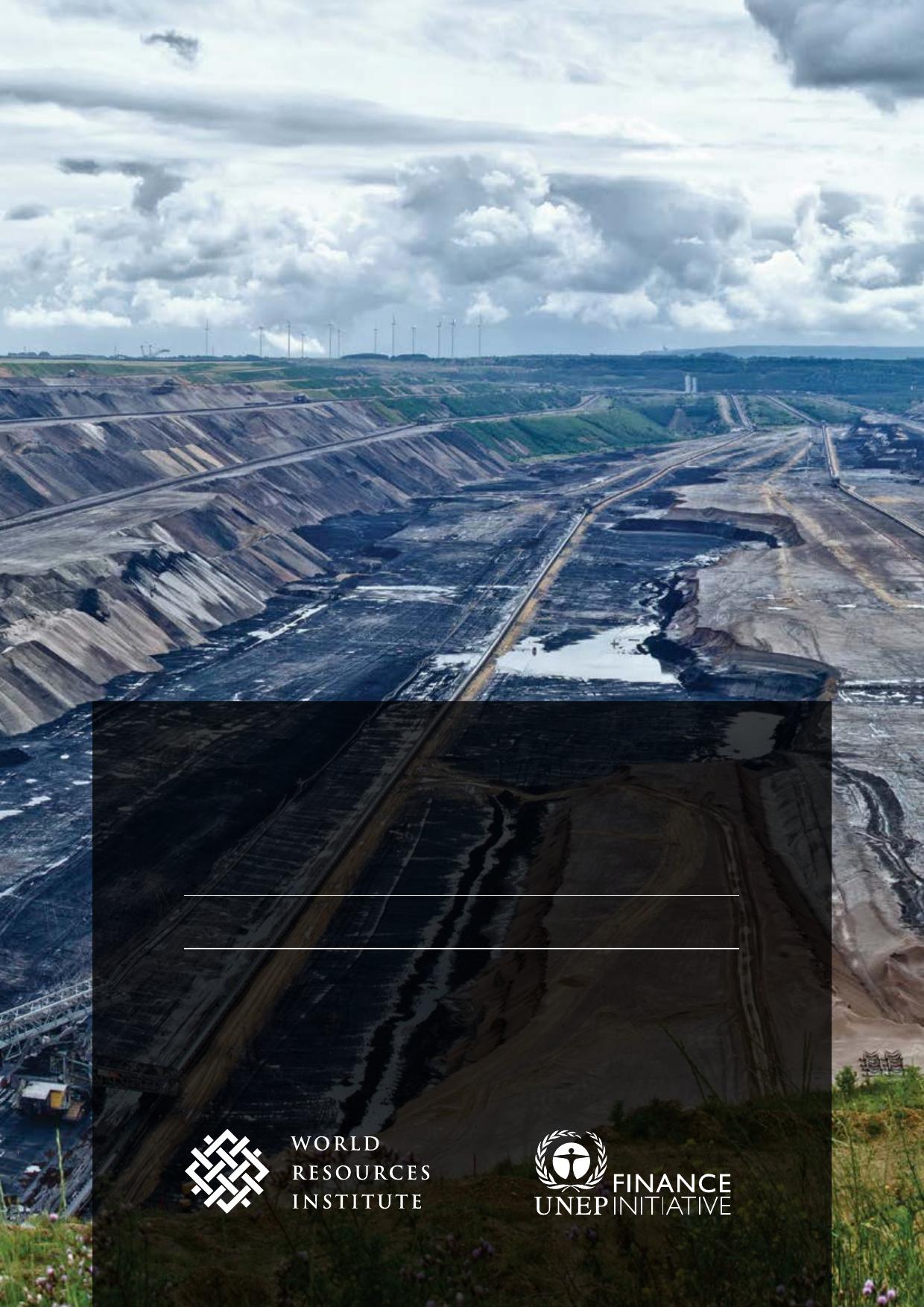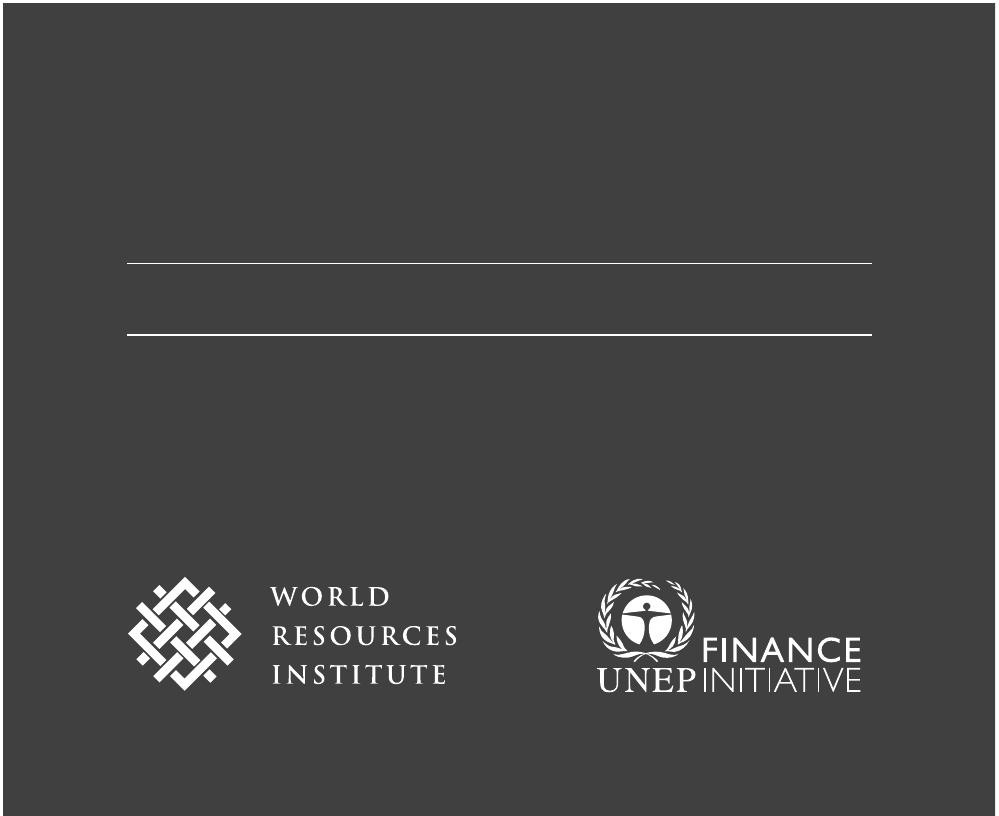CARBONASSETRISK:WRIANDUNEP-FIPORTFOLIOCARBONINITIATIVEDISCUSSIONFRAMEWORKCARBONASSETRISK:WRIANDUNEP-FIPORTFOLIOCARBONINITIATIVEDISCUSSIONFRAMEWORKCarbonAssetRisk:DiscussionFramework3ACKNOWLEDGEMENTSThisframeworkwascreatedthroughamulti-stakeholderprocessinvolvingprimaryauthors,adraftingteamthatdevelopedtheinitialchapterdrafts,atechnicalworkinggroup,otherexpertreviewerswhoprovidedinputduringtheprocess,andaSecretariatthatorganizedinputfromtechnicalworkinggroupmembersandotherstakeholders.TechnicalworkinggroupmembersandreviewersarelistedinAppendix3.ThisworkwasfundedinpartwithsupporttotheWorldResourcesInstitutefromBankofAmericaFoundation,Citigroup,JPMorganChaseBankN.A.,andWellsFargoFoundation.Draftingteammembersfromthe2°InvestingInitiativeparticipatedthroughfinancialsupportfromADEME.PrimaryAuthorsMarkFultonEnergyTransitionAdvisors,consultanttoWorldResourcesInstituteChristopherWeberWorldResourcesInstituteDraftingteamMarisaBuchananJPMorganChase&Co–TechnicalWorkingGroupChairStanDupré2°InvestingInitiativeSabineMiltnerDonaldReedPwCJakobThomae2°InvestingInitiativeGabrielThoumi,CFACalvertInvestmentsSabineMiltnerwasanemployeeofDeutscheBankatthetimeofwritingbutisnolongerwiththecompanySecretariatCynthiaCummisWorldResourcesInstituteRemcoFischerUNEPFIFrontcoverphotographyBertKaufmann(www.flickr.com/photos/22746515@N02/)Takenon15July2012GarzweilerRevisited,TagebauGarzweilerII,Jüchen,Germanyhttps://creativecommons.org/licenses/by-sa/2.0/DisclaimerParticipationinthisprocessdoesnotsuggestorimplyendorsement,andisnotanendorsement,oftheframework,oranyoftheconceptsdescribedherein,bytheindividualsortheirrespectiveinstitutions.Nothinginthispapershouldbeconstruedasinvestmentadviceorinvestmentresearch.Theframeworkalsodescribesavarietyofcommerciallyorfreelyavailabletoolsthatmaybeusedtosupportcarbonassetriskassessment.Thehighlightedtoolsareonesavailableatthetimethisdocumentwaspublishedfromproviderswhowereinvolvedinthedevelopmentandreviewofthisframework;thelistwillnotbeupdatedovertime.Thelistoftoolsisintendedtobeforillustrativepurposesonlyandshouldnotsuggestorimplyendorsement,andisnotanendorsement,byWRI,UNEP-FI,oranyoftheparticipantsintheprocessortheirrespectiveinstitutions.4WRI&UNEPFIPortfolioCarbonInitiativeTABLEOFCONTENTSExecutivesummary6Chapter1:Introduction11Chapter2:Typesofcarbonriskfactors14Chapter3:Identifyingcarbonriskinsectorsandcompanies21Chapter4:Financialriskinthecapitalstack26Chapter5:CarbonAssetRisk:Evaluatingthefinancialimpacts30Chapter6:Managingcarbonassetrisk43Glossary48AdditionalReading49Appendix1:Commonstructuresusedtofinancecarbon-intensiveassetsandcompanies52Appendix2:CommercialToolsandResearchforAssessingExposureandImpactsofCAR54Appendix3:PCIAdvisoryGroupMembersandMembersofUNEPFI’sClimateChangeAdvisoryGroup62Appendix4:TechnicalWorkingGroupMembersandReviewers63EndNotes65CarbonAssetRisk:DiscussionFramework5LISTOFFIGURESFigureES-1:SummaryofFrameworkStructure7FigureES-2:FrameworkforAssessingandManagingCarbonAssetRisk8FigureES-3:RiskManagementOptionsbyInvestmentStageforDifferentFinancialSectorActors10Figure4:IllustrationofOperatorCarbonRiskandCarbonAssetRisk16Figure5:CarbonIntensity,PhysicalAssetLifespanandEBITMarginorKeySectorsExposedtoClimateScenarios24Figure6:TheCapitalStack29Figure7:FrameworkforAssessingandManagingCarbonAssetRisk32Figure8:ExpandingFig7:High-levelSummaryofOperator/CompanyRiskAssessmentProcess33Figure9:GlobalOilSupplyCostCurve39Figure10:ExpandingFig8:High-levelsummaryoftop-downriskassessmentprocess.40Figure11:SummaryofRiskData(InputsandDriversforRiskModels),TypesofRiskModels,andKeyOutputsandMetricsforEachLevelofAnalysis41Figure12:RiskManagementOptionsbyInvestmentStageforDifferentFinancialSectorActors446WRI&UNEPFIPortfolioCarbonInitiativeEXECUTIVESUMMARYAfterdecadesofresearch,strongconsensushasemergedwithintheworld’sscientificcommunitythathumaninfluence,particularlytheburningoffossilfuelsanddeforestation,hasbeenthedominantcauseofobservedwarmingintheglobalclimatesystem.1Climatechangepresentsenormouseconomic,social,andfinancialimplicationsforeconomiesaroundtheworld.Inresponse,manygovernmentshaveenacted,orareconsideringenacting,policiestoreducegreenhousegas(GHG)emissionsandincreasedeploymentoflow-carbontechnologies.Thisisoccurringinthecontextofchangingregionalandglobalenergymarkets,asevidencedbyrecentvolatilityinglobalenergycommodityprices.Thesepolicyandmarketdynamicshaveledanumberofinvestorsandotherstakeholderstoquestionwhetherloansorinvestmentsincarbon-intensivephysicalassetsorcompaniescouldbeatrisk.Inthiscontext,theriskisthataloanisnotrepaidoraninvestmentdoesnotperformasexpected,becauseofvariouspolicy,technology,market,andeconomic,orsocialtrendsthatemergewithinaGHG-constrainedglobaleconomy.Thisframeworkfocusesprincipallyonnon-physicalrisks,suchaspolicy,market,andtechnologyrisks,associatedwithcarbonandclimatechange.Thedecisiontoexcludephysicalclimaterisks(forexample,severestorms,floods,etc.)fromthescopeisnotintendedtodiminishtheirimportanceorpotentialsignificanceforfinancialintermediariesorinvestors.Itwasmadebecausetheprocessofidentifying,evaluating,andmanagingphysicalclimateimpactsissignificantlydifferentfromthesameprocessforothercarbonriskfactors,suchasclimatepolicies.Physicalclimateriskswarranttheirownseparatetreatmentfromagroupwiththerequisiteexpertise.Thisdiscussionon“carbonrisk”1hasbeeninfluencedbyresearchundertakenbytheInternationalEnergyAgency(IEA)andtheCarbonTrackerInitiative,amongothers,whichsuggeststhat,absentcarboncaptureandsequestrationorothertechnologicalsolutionstomanageGHGemissions,asignificantquantityoftheworld’sfossilfuelresources,especiallycoal,willneedtoremainintheground(thatis,unexploited)iftheworsteffectsofclimatechangearetobeavoided.Atthesametime,mostleadingexpertspredictthatfossilfuelswillneedtoremainapartoftheworld’senergymixforsometimeintothefuture,evenunderglobalcarbonconstraints;nevertheless,addressingclimatechangewillrequirecountriestoreducetheirrelianceonfossilfuelssteadilyovertime.Thisisaphenomenonthatwillcarrybroadimplicationsforgovernments,companies,financialintermediaries,andinvestors.Forexample,ifalargequantityoffossilfuelresourcescannotbeextractedandproduced(whetherbecauseofpolicy,marketorothercarbon-relatedconstraints),companieswhosebusi-nessisprincipallyfocusedonsuchactivitiescouldbenegativelyimpacted,bothoperationallyandfinancially.Theimplicationsforfossilfuelcommoditypricesarecrucialinanyvaluationscenarioforsuchcompanies.Thisconceptisreferredtointhisframeworkas“operatorcarbonrisk”andaffectscarbon-intensivecompaniesandassetoperators(seeChapter2fordetails).Further,thisrealityhasledtoabroaderdiscussionaboutwhetherfinancialintermediaries,suchascommercialandinvestmentbanks,andinvestors,arethoroughlyintegratingconsiderationsofoperatorcarbonriskwhenevaluating,pricing,andfinancingcarbonassetsandcompanies.Inparticular,concernhasemergedaroundthepotentialforoperatorcarbonrisktotranslateto“carbonassetrisk,”whichisthepotentialfinancialriskaffectingintermediariesandinvestorswithafinancialstakeinorrelationshipwiththesecompanies.FRAMEWORKOBJECTIVEThedialoguearoundcarbonassetriskhasgrownovertime,butithasoccurredintheabsenceofacomprehensive,generallyacceptedframeworktoguideinstitutionsandotherstakeholdersintheireffortstothinkconsistentlyandsystematicallyabouttheissue.Tomeetthisimportantneed,theWorldResourcesInstitute(WRI)andUNEPFinanceInitiative(UNEP-FI)launchedaprocessinearly2014todevelopaframeworktohelpfinancialintermediariesandinvestors,aswellasstakeholderswithaninterestinthistopic,moresystematicallytoidentify,assess,andmanagecarbonassetrisk.1.Allreferencesto“carbon”inthisdocumentrefertoallgreenhousegasemissionsratherthanjustcarbondioxideCarbonAssetRisk:DiscussionFramework7Thisframeworkisintendedtobeusefulforinstitutionswithadiverserangeofriskappetites,aswellasperspectivesontheprobabilityandimpactofvarioustypesofcarbonrisk.Itwasdevelopedthroughamulti-stakeholderprocessthatincludedinvestors,academics,consultants,andrepresentativesfrombanks,insurancecompanies,andenvironmentaladvocacyorganizations.Theframeworkisnotintendedtobeaprescriptivemethodologyforcarbonassetriskmanage-ment,norisitintendedtoopineonthepotentiallikelihoodandimpactofoperatorcarbonrisk.Rather,thisconceptualframeworkisintendedtohelpfinancialintermediariesandinvestorsthinkmoreconsistentlyandsystematicallyaboutcarbonassetrisk—whatitis,andhowitcanbeevaluatedandmanaged—aswellastohighlightexistinganalyticaltoolsthatmaybehelpfulinthisprocess.Inotherwords,theframeworkdiscusseshowinvestorsandintermediariesmightthinkaboutcarbonassetriskratherthanwhattheyshouldthinkaboutit.Theconceptsareintendedtoenhanceusers’existingriskmanagementprocessesandsystemsandultimatelystrengthenoveralldecision-making.FRAMEWORKSTRUCTURETheframework,whichisstructuredacrosssixchapters,coversthekeyelementsofaddressingcarbonassetriskduringtheprocessofmakingnewfinancingorinvestmentdecisionsandwhenmanagingexistinginvestmentportfolios.AsshowninFigureES-1below,thedocumentstartswithassessingexposureandfollowswithadiscussionofevaluatingandmanagingcarbonassetrisk.FigureES-1:SummaryofFrameworkStructureCHAPTERHIGHLIGHTS◾◾Chapter2explorestypesofriskfactorsrelatedtocarbonrisk.Thisframeworkdrawsanimportantdistinctionbetweenhowcarbonriskfactorscanaffectcarbon-intensivecompanies/operators(“operatorcarbonrisk”)andhowsuchrisk,dependinguponthenatureandseverityofimpact,couldaffectfinancialintermediariesandinvestorsthathaveafinancialrelationshipwiththeseoperators(“carbonassetrisk.”)Theframeworkdiscussesthreecorecarbonriskfactorsthatexisttoday—policyandlegal,technology,andmarketandeconomic—aswellasreputationalrisksandfurtherdiscussesseveralissuesandtrendsthatwillbeimportanttomonitorovertime.Manyofthesefactorsarecloselyintertwinedandnotalwayseasytoisolate.Forexample,policychangescanleadtoneweconomicincentivesandalsodrivetechnologicalinnovationanddeployment.◾◾Chapter3exploresfactorsthatmightmakecertainindustrysectorsandtypesofcompa-niesmoreorlessexposedtocarbonrisk.Todate,publicdialoguehasfocusedprincipallyonphysicalassetsandoperationsheavilyreliantonfossilfuels,suchasupstreamfossilfuelexplorationandproductionandfossil-fuel-firedpowergeneration.Thisisalogicalfocus,giventhattheseactivitiescontributethelargestshareofGHGemissionstotheglobalecon-omyandaremostlikelytobeimpacteddirectlybycarbon(andotherair-pollution-control)policyregimes,suchascap-and-tradeprogramsorcarbontaxes.Nevertheless,othersectors,suchasfossil-fuel-dependentinfrastructureandfossil-fuel-intensiveindustriesthatfaceChapter2:TypesofcarbonriskfactorsChapter3:IdentifyingcarbonriskinsectorsandcompaniesChapter4:FinancialriskinthecapitalstackChapter5:Carbonassetrisk:evaluatingthefinancialimpactsChapter6:ManagingcarbonassetriskAssessExposureEvaluateRiskManageRisk8WRI&UNEPFIPortfolioCarbonInitiativecompetitionfromlow-carboncompetitors,mayalsobeexposedtooperatorcarbonrisk.Thechapterintroducesseveralimportantconsiderationsrelevanttodeterminingasectororoperator’spotentialexposuretocarbonrisk,includingtheprofileofitsassets(forexample,type,fuelmix,location,operationallifetime,GHGemissions,etc.),aswellasitsoperator’searningsmargin,andwhetheritfaceslow-carboncompetitors.Exposureisalsoafunctionof“operatorcarbonstrategy,”whichistheabilitytomanageriskthroughstrategieslikefuturedevelopment/capitalexpenditure(capex)plans,assetdiversification,andoperationalriskmanagementefforts(forexample,methanemitigation).Thesefactorsareimportantbecauseoperatorswithinasectorwithhighrisk(forexample,oilandgasorutilities)mightownverydifferenttypesofassetsandoperateinvariousjurisdictionswithdiverseoperatingconditions.Asaresult,theymightfaceverydifferenttypesandlevelsofcarbonrisk.◾◾Chapter4describeshow,evenforinvestmentsinsectorsorcompaniesthatfacehighlevelsofoperatorcarbonrisk,carbonassetriskislargelyafunctionofthetypeoffinancialrelationshipwiththeoperator(forexample,corporateloan,projectfinance,equityorbond)andthelikelydurationor“tenor”oftherelationship.Thisrequiresanunderstandingofwheredifferenttypesoffinancingsitinthecapitalstack,whichisthesumtotalofcapitalinvestedinaprojectorcompany.Specificaspectsoffinancing,includingthetypeofcapitalprovided,thetenor,theseniorityofcapital,andwhetheritissecuredbycollateral,allaffecttheriskandreturnprofilesofafinancialinvestmentandareimportantconsiderationsindeterminingwhetheroperatorcarbonriskmaytranslatetocarbonassetriskforanintermediaryorinvestor.Collectively,thesecarbonriskfactors,operatorcharacteristics,andfinancialassettypeandtenor,informthecarbonriskexposureofaninvestment.ThisisshowninFigureES-2,whichvisualizestheframeworkasawhole.Asdiscussedabove,afterassessingexposure,thefinancialimpactofcarbonassetriskisassessedandwherenecessary,managed.FigureES-2:FrameworkforAssessingCarbonRiskandAssessingandManagingCarbonAssetRiskLowExposure:STOPPolicyandlegalfactorsCarbonRiskFactorsAnalysisTypesManagementApproachesExposuretoCarbonRisksUnderwriter/originatorOperator/company:StresstestandvaluaƟonAvoidtherisk:Sector/securityavoidanceDivestmentManagetherisk:RiskdisclosureSectoralpoliciesDuediligence/riskpricingDiversificaƟonEngagementPorƞolio:StresstestandriskmodelsTechnologyfactorsMarketandeconomicfactorsReputaƟonalfactorsPhysicalassets123Company/operatorOperators:CarbonriskLoansBondsEquityFinancialassets:CarbonassetriskLendersInvestorsFinancialporƞoliosScreeningLowrisk:STOPAssessExposureEvaluateRiskManageRiskCarbonAssetRisk:DiscussionFramework9◾◾Chapter5discussestheprocessbywhichfinancialintermediariesandinvestorscanevalu-atethispotentialfinancialimpact.Asafirststep,intermediariesandinvestorscanscreenthekeyexposuredataassociatedwiththeoperator,includingitsportfolioofcarbonassets(forexample,fueltypes,locations,costofproduction,emissionsintensity,etc.)anditsoperatorcarbonstrategy(forexample,futuredevelopment/capexplans,assetdiversification,oper-ationalriskmanagement,etc.).Thisassessmentmightentailanevaluationofqualitativeinformationandquantitativedatareportedbyacompanyinitsannualreport,corporateresponsibilityorsustainabilityreportsorotherpublicdisclosures,aswellasconversationswithcompanymanagement.Intermediariesandinvestorsalsoneedtoconsiderthenatureofthefinancialrelationship(forexample,typeoffinancingandexpectedduration)inplaceorunderconsideration,andtheroleofthisfinancinginthecompany’scapitalstructure.Forthoseloansorinvestmentsthathavealowexposuretocarbonassetrisk,furtheractionmightnotbenecessary.However,forthosewherepotentialriskisidentified,furtherduediligenceandassessmentmightbewarranted.AsdiscussedinChapter5,twoanalyticalapproachescaninformthisassessment:1)anindividualoperator-levelapproachstartingfromphysicalassetsandrollinguptoaportfolio,and,2)aportfolioapproachthatevaluatestheimpactsofriskfactorsonanentireportfolioofinvest-ments.Theseapproachescanbeusedseparatelyorinconjunctionwitheachother.Followingtheinitialscreeningassessment,thekeyfocusoftheoperator-levelapproachisonstresstestingandscenarioanalysis,usinggeneraleconomicframeworkstofore-castpotentialfutureoutcomesunderarangeofdifferentassumptions(forexample,afutureworldwheregovernmentstakeactiontoavoidglobalaveragetemperaturesrisingbymorethan2˚Cabovepre-industriallevels).Theoutputsofthisassessmentcaninformvaluationmodels,suchasdiscountedcashflow(DCF)analysis.Screeningforexposureisimportantbecauseevaluatingtheriskcanrequiresignificantresources,andanalysisshouldfocusoninvestmentswiththehighestpotentialexposure.Investorslikelyprefertoseethecompaniesdoingthedetailedstresstestingonthemselvesattheoperatorlevel.Whilecollectingriskdatacanentailasignificanteffort,manyentitiessupplybasicdataforscenariosforexample,theIEA,thinktanksliketheCarbonTrackerInitiative,investmentanalysts,andothercommercialtoolproviders(seeAppendix2forasample).Further,inadditiontoreferencinginformationdisclosedbycompanies,intermediariesandinvestorsmayalsowanttoengagedirectlywithcompaniestounderstandtheirapproach,assump-tions,andanalysis.Intermediariesandinvestorscanthenuseinformationfromallofthesesources—statisticalagencies,NGOs,commercialtoolproviders,investmentanal-ysis,andtheoperatorsthemselves—tomakeadeterminationaboutthematerialityofrisk.CarbonAssetRisk:KeyConsiderations◾◾Carbonriskfacedbyoperatorsofcarbonassets(operatorcarbonrisk)couldleadtocarbonassetriskforfinancialintermediariesandinvestorswithafinancialinterestintheseassets.Whilecarbonassetriskdependsonanumberoffactors,fundamentally,afinancialintermediaryorinvestorcannotbeexposedtocarbonassetriskunlesstheunderlyingoperatorwithwhichithasafinancialrelationshipisexposedtocarbonrisk.◾◾Operatorcarbonriskisafunctionofthecharacteristicsofphysicalassetsmanagedbyanoperator,thenatureoftheriskstowhichtheseassetsareexposed,andhowtheoperatorismanagingtheserisks.◾◾Therecouldbeinstanceswhereanoperatorisexposedtocarbonriskbutafinancialinterme-diaryorinvestorfaceslittletonocarbonassetrisk.Thiscouldstemfromthetypeoffinancialrelationshipathand(forexample,aloanversusanequityinvestment),aswellastheexpecteddurationandliquidityoftheposition.10WRI&UNEPFIPortfolioCarbonInitiativeThePortfolioapproachanalysisevaluatestheinfluenceofriskfactorsattheportfoliolevel,takingintoaccountbothhigh-andlow-carboninvestmentsandtheexpectedriskcorrelationbetweenthemgivenanassumedscenario.Suchanalysiscouldhavesignificantadvantagesovertheoperator-levelapproachintermsofpracticalityandscalability;however,toolstoperformsuchevaluationareonlyemergingnowandaregenerallyonlyavailablethroughcommercialproviders.Moreresearchisneededtoproducepracticaltoolscapableofstresstestinginvest-mentportfoliosforcarbonassetrisk.◾◾Chapter6discussesstrategiesthatfinancialintermediariesandinvestorscanpursuetomanagecarbonassetrisk,iftheevaluationprocessleadstotheconclusionthattheriskismaterial.Theoptionsformanagingcarbonassetriskwillvarydependingontheroleoftheintermediaryorinvestor(forexample,underwriter,bondholder,lenderorshareholder)andwhetherfinancingorinvestmentisunderconsiderationorhasalreadybeenmade.AsshowninFigureES-3,intermediariesandinvestorshavetwomainoptions-avoidingriskaltogetherormanagingit.FigureES-3:RiskManagementOptionsbyInvestmentStageforDifferentFinancialSectorActorsFinancialIntermediaries(Underwriters)FinancialIntermediaries(Lenders)BondBuyersShareholdersNewinvestmentsAvoidtherisk◾◾Sector/securityavoidance◾◾Sector/securityavoidance◾◾Sector/securityavoidance◾◾Sector/securityavoidanceManagetherisk◾◾Promoteriskdisclosure◾◾Properriskpricing◾◾Thoroughduediligence◾◾Properriskpricing◾◾Sectoralpolicies◾◾Thoroughduediligence(potentiallyincludecovenants)◾◾Engageinkeyareas◾◾Promoteriskdisclosure◾◾Duediligenceaspossibleindisclosure◾◾InvestwithESGscreens◾◾DiversificationCurrentholdingsAvoidtheriskN/A◾◾Divestmentatsectororloanlevel◾◾Divestmentatsectororsecuritylevel◾◾DivestmentatsectororsecuritylevelManagetheriskN/A◾◾Diversification(sectorandsubsector)◾◾Engagementtounderstandoperatorriskmanagement◾◾Diversification◾◾Diversification◾◾Engagementtounderstandriskmanagement◾◾EngagementtoalignriskandreturnperspectivesRiskavoidancecanbeachievedbyapplyingsectororcompanyexclusionswhenmakingnewinvest-mentdecisions,orbychoosingtosellordivestcertainholdingsfromcurrentlyheldpositions.Somemaychoosetoavoidcertaintypesoffinancingorinvestmentsduetoethicalreasonsorbecausetheperceivedcarbonriskistoosignificant.However,iftheprimarygoalistobettermanagerisk(asopposedtoethicalconsiderations)manyotheroptionscanbepursued.Forinstance,lendersandinvestorsconsideringnewopportunitiescanensurethatthoroughduediligencehasbeenperformedandthatinvestmentshaveanappropriaterisk-adjustedreturn.Likewise,riskcanalsobemanagedthroughportfoliodiversificationstrategiesand,insomecases,byengagingwithcompaniesaroundcarbonriskdisclosureandmanagement.Furthermore,serviceproviderslikeunderwriterscanalsoplayarolebyencouragingthoroughdisclosureofoperatorcarbonriskinsecurities-offeringdocuments,andensuringthepricingofsecuritiesincorporatesconsiderationofrelevantrisks.THEROLEOFPOLICYAnimportantfinalconsiderationisthatassessingandmanagingcarbonassetriskismademorechallengingbythesubstantialamountofuncertaintyaboutthefuturedirectionofpublicpoliciesonenergyandclimatechange.Thefinancialsectorcouldplayaroleinworkingtoreducethisuncertaintythroughengagementinpublicpolicyarenas.HavinggreaterclarityonissuessuchasthepotentialnatureandtimingofGHGregulationandreportinganddisclosurerequirementswouldgreatlyenhancetheabilitytoassessandmanagecarbonassetrisk.CarbonAssetRisk:DiscussionFramework11CHAPTER1:INTRODUCTION1.1CONTEXTAfterdecadesofresearch,strongconsensushasemergedwithintheworld’sscientificcommunitythathumaninfluence,particularlytheburningoffossilfuelsanddeforestation,hasbeenthedominantcauseofobservedwarmingintheglobalclimatesystemsincethemid-20thcentury.Furthermore,continuedgrowthingreenhousegas(GHG)emissionsislikelytocausefurtherclimaticchanges,whichareprojectedtoleadtocontinuedsea-levelrise,changesinprecipitationpatterns,andmorefrequenthottemperatureextremesovermostlandareas.2Thesepotentialchangespresentenormouseconomic,social,andfinancialimplicationsforeconomiesaroundtheworld.Inresponsetothesechallenges,manygovernmentshaveenactedpoliciestoreduceGHGemissionsandotherpollutionfromsourcessuchaspowerplants,andtoincreasedeploymentoflow-carbonenergyandothertechnologies.Theshareofrenewableenergyintheworld’senergymix,whilestillrelativelysmall,hasincreasedsubstantiallybecauseofthesepolicies,andarangeoftechnologicalimprovementshasbroughtthecostofrenewablesclosertoparitywithfossilfuels.Atthesametime,ongoingevolutionandchangesinthedevelopmentoffossilfuelshaveledtosignificantshiftsinenergydevelopmentinsomeregions.OneprominentexampleisthegrowthofshaleoilandgasdevelopmentintheUnitedStates,whichhasbeenpartlyresponsiblefordisplacingsignificantamountsofcoal-firedpowergeneration.Thesepolicyandmarketdynamicshaveledanumberofinvestorsandotherstakeholderstoquestionwhetherloansto,orinvestmentsin,carbon-intensiveassetsandcompanies-definedinthisframeworkasphysicalassetsorcompanieswithdirectorindirectexposuretohighlevelsofGHGemissions,suchasthoseinthefossilfuelindustry,orthatareheavilyreliantonfossilfuels-couldbeexposedtofinancialrisk.Inthiscontext,theriskisthataloanisnotrepaidoraninvestmentdoesnotperformasexpected,becauseofvariouspolicy,economic,market,andsocialtrendsthatemergewithinaGHG-constrainedglobaleconomy.ThisdiscussionhasbeeninfluencedbyresearchfromtheInternationalEnergyAgency(IEA)andtheCarbonTrackerInitiative,amongothers,whichsuggeststhat,absentcarboncaptureandsequestrationorothertechnologicalsolutionstomanageGHGemissions,asignificantquantityoftheworld’sfossilfuelresources,notablycoal,willneedtoremainintheground(thatis,unexploited).Thiswillbeanecessarypartofanyreasonablestrategytoavoidariseinglobalaveragetemperatureofmorethan2°Cabovepre-industriallevels-thelimitthatscientistssuggestisnecessarytoavoidtheworstconsequencesofclimatechange(andthetargetlevelagreedtobytheUnitedNationsFrameworkConventiononClimateChangein2010).Thisconceptisoftenknownasa“carbonKEYPOINTS◾◾Someinvestorsandstakeholdershavequestionedwhetherfinancialintermediariesandinvestorsareadequatelyconsideringpolicy,market/economicandreputationalrisksfromcarbon-intensivephysicalassets◾◾Perspectivesonthelikelihoodandpotentialimpactofsuchrisksvaryconsiderably◾◾Thisframeworkprovidesapproachesandtoolsforidentifying,assessing,andmanag-ingcarbonassetrisk12WRI&UNEPFIPortfolioCarbonInitiativebudget,”anditappliestoboth2°Cscenariosaswellastohigheremissionsandhigherimpactscenarios(forexample,3°C),albeitwithahigherbudgetforthesealternativescenarios.WhiletheIEA’smodellingsuggeststhatfossilfuelsarelikelytoremainasignificantpartoftheworld’senergymix,evenundera2°Cscenario,italsofindsthataddressingclimatechangewillnecessitatereducingrelianceonunabatedfossilfueluseovertime--inparticular,onthemostcarbon-intensivefuels.3Thisisaphenomenonthatwillcarrybroadimplicationsforgovernments,companies,financialintermediariesandinvestors.Forexample,ifalargequantityoffossilfuelresourcescannotbeextractedandproduced(whetherbecauseofpolicy,market,orothercarbon-relatedconstraints),companieswhosebusi-nessisprincipallyfocusedonsuchactivitiescouldbenegativelyimpacted,bothoperationallyandfinancially.Theeffectoncommoditypricesandvaluationsisakeyelement.Further,thisrealityhasledtoabroaderdebateaboutwhetherfinancialintermediaries,suchascommercialandinvestmentbanks,andinvestors,arethoroughlyintegratingconsiderationsofoperatorcarbonriskwhenevaluating,pricing,andfinancingcarbon-intensiveassets.Insomecases,therehavebeencallsforbanksandinvestorstoceasefinancingfossil-fuelcompaniesandotherhigh-carbonprojectsinlightofconcernabouttheriskofexposureto“strandedassets,”ortheriskthatassetsloseall(inanextremecase)orapartialamountoftheirvalue.1.2OBJECTIVEAsdiscussedabove,thisdialoguehasgrownovertimebothwithinthefinancialsectoramongfinancialactorsandotherstakeholders,butithasoccurredintheabsenceofacomprehensive,generallyacceptedframeworktoguideinstitutionsandstakeholdersintheireffortstothinkconsist-entlyandsystematicallyaboutcarbonassetrisk(CAR).Tomeetthisimportantneed,theWorldResourcesInstitute(WRI)andUNEPFinanceInitiative(UNEP-FI)launchedaprocessinearly2013todevelopaframeworktohelpfinancialintermediariesandinvestorsbetteridentify,assess,andmanageCAR.Theframeworkisintendedtobepracticalandusefulforexecutives,researchanalysts,dealteams,riskmanagers,andcorporateresponsibilityexpertsfromadiversesetofinstitutionsinthefinancialsector,rangingfromcommercialandinvestmentbankstoassetmanagersandinvestors.Itisalsointendedtobeusefulforreaderswitharangeofriskappetitesandperspectivesontheprobabilityandimpactofcarbonrisks.Itisalsoimportanttonotethescopeandlimitationsofthisframework.AsdiscussedinChapters2and3,thedocumentlimitsitscoveragetorisksassociatedwithclimatemitigationforenergy-relatedCO2emissions,asopposedtoothersourcesofgreenhousegases(agriculture,landuseandforestry,fluorinatedcompounds),andspecificallylargesourcesofenergy-relatedCO2emissionsinfossilfuelproductionandelectricitygeneration.Further,theframeworkdiscussesCARassessmentandmanagementwithlittleconsiderationofthepotentialdevelopmentbenefitsassociatedwithenergyaccessindevelopingeconomies.1.3TERMINOLOGYAswithmanytopicsinfinanceandtheenvironment,ourobservationisthatthepublicdialogueoncarbonassetriskhasbeencomplicatedbydifferencesinthewaythatvariousstakeholdersuseterminology.Wehopethatthispaperwillprovideusefulclarityandconsistency.Anexampleistheterm“exposure,”whichwillbeusedinthisframeworkinacolloquialsensetomean“exposedtoarisk”ratherthanthemoreformalquantitativedefinitionof“potentialloss.”Additionalexamplesincludetermslike“assets”(physicalversusfinancial;herewehavestrivenforclaritybydefiningwhatwemeanwhenweusetheterm);“financialintermediaries”(hereusedtodescribeinvestmentandcommercialbanksthatunderwriteequityandbondofferings,aswellasmakeloanstocompaniesandprojects);and“investors”(hereusedtodescribeshareholdersandbondholders,aswellasassetmanagers).Theauthorsandtechnicalworkinggroupmembers(seenextsection)strovetocreateaframe-workthatwillbebroadlyusefulandunderstandabletothewidestpossibleaudience;however,somereadersmayencounterterminologyusedinunfamiliarways.Toguidereaders,aglossaryhasbeenincludedasanappendixtothedocument.CarbonAssetRisk:DiscussionFramework131.4FRAMEWORKDEVELOPMENTPROCESSThisframeworkwasdevelopedthroughaninternationalmulti-stakeholderprocessthatincludedrepresentativesfrombanks,insurancecompanies,andenvironmentaladvocacyorganizations,aswellasinvestors,academics,andconsultants.Aninitialdraftwascreatedbyadraftingteamandreviewedbyatechnicalworkinggroup,andaseconddraftwasreviewedbyabroadertechnicalworkinggroupandotherexpertsthroughpublicconsultation.Thisprocess,whichwasfacilitatedbyWRIandUNEP-FI,helpedtoensurethatdiverseperspectiveswereconsideredduringdevelopment,andwasintendedtoensurethatthefinalproductisultimatelypracticalandusableforitsintendedaudience.ThemembersofthetechnicalworkinggroupthatparticipatedintheprocessarenotedinAppendix3.14WRI&UNEPFIPortfolioCarbonInitiativeCHAPTER2:TYPESOFCARBONRISKFACTORS2.1DEFINITIONANDCONCEPTUALFRAMEWORKThischapteroutlinesthetypesofcarbonrisksandriskfactorsthatcouldimpactphysicalassetsandcompanies,creatingpotentialfinancialrisksforfinancialintermediariesandinvestorswitharelatedfinancialinterest.2.1.1DefiningtypesofcarbonriskandriskfactorsWhendefiningrisksrelatedtoclimatechange,itisimportanttodistinguishbetween:◾◾Physicalclimaterisks,whicharerisksassociatedwithphysicalimpactsfromclimatechangethatcouldimpactcarbonassetsandoperatingcompanies.Theseimpactsmayincludephysicaldamageand/orcapitalexpendituresnecessaryinresponsetovariationsinweatherpatterns(suchasseverestorms,floods,anddrought)and“slowonset”impactssuchassealevelrise,desertification,etc.◾◾Carbonrisks,whichthispaperdefinesasnon-physicalclimatechange-relatedfactorsfacingassetsandcompanies.Thisprincipallyencompassespolicyandlegal,technology,marketandeconomicfactorsaswellasreputationalrisks.Dependingupontheirnatureandseverity,carbonrisksmaytranslatetocarbonassetrisktofinancialintermediariesandinvestors.Theimpactofphysicalclimaterisksandcarbonriskscanbeconsideredwithinthecommonframeworkofvarioustypesoffinancialrisk;theseincludecredit,market,policy,liquidity,oper-ational,andreputationalrisks,amongothers.Whereasphysicalclimaterisksgenerallytranslateintooperationalrisks(forexample,anassetcannotoperateduetophysicalimpacts),non-physicalcarbonriskfactorscaninfluencemanydifferenttypesofrisk,whichmayalsocarryfinancialimplicationsforcompanies.Thisframeworkfocusesonnon-physicalcarbonriskfactors(primarilypolicyandlegal,tech-nology,andmarket/economic).ExcludingphysicalclimaterisksfromdiscussionisnotintendedKEYPOINTS◾◾Carbonassetsandcompaniescanbeexposedtoavarietyofpotentialriskfactorsrelatedtoclimatechange,includingpolicy,legal,technology,marketandeconomic,aswellasreputationalrisks.Policy,technology,andmarket/economicfactorsareoftencloselyinterrelatedandarethemainfocusofthisframework,althoughreputationalrisksarediscussedhereandinChapter6.◾◾Carbonrisks,whichaffecttheoperatorsofcarbonassets(“operatorcarbonrisk,”)mightpresentthemselvesas“carbonassetrisk”tofinancialintermediariesandinvestors,dependingupontheirnatureandseverityofimpact.◾◾Whilenolessimportant,thephysicalrisksstemmingfromclimatechangeareexcludedfromthescopeoftheframework,becausetheapproachesforidentifying,evaluatingandmanagingtheserisksdiffersignificantlyfromapproachesusedforcarbonrisks.CarbonAssetRisk:DiscussionFramework15todiminishtheirimportanceorpotentialsignificanceforfinancialintermediariesorinvestors.Thisdecisionwasmadebecausetheprocessofidentifying,evaluatingandmanagingphysicalclimateimpactsissignificantlydifferentfromthatusedforothercarbonriskfactors,suchaspolicyrisks.Physicalclimateriskswarranttheirownseparatetreatmentfromagroupwiththerequisiteexpertise.Similarly,reputationalriskconsiderationsarealsoimportanttoconsider.However,individualinstitutionsgenerallyhavetheirownframeworkandprocessesforevaluatingandmanagingsuchrisks.Thus,whilethisdocumentdiscussesreputationalrisks(section2.3andChapter6)itdoesnotcoverspecificevaluationapproaches.Finally,thevastmajorityofrecentpublicdiscourseaboutpotentialrisksfacingfinancialinter-mediariesandinvestorshavesfocusedaroundhowcarbonriskfactorsaffecthigh-carboncompaniesandindustries,notablyfossilfuelcompanies.Giventhispublicdebate,high-carbonassetsarethemainfocusofthisframework.2.1.2MovingfromcarbonrisktocarbonassetriskItisimportanttoillustratehowcarbonrisk,whichaffectsoperatorsofcarbonassets,couldpoten-tiallytranslateto“carbonassetrisk,”whichaffectsfinancialintermediariesandinvestors.Asanexample,considerapowercompanythatoperatesafleetofcoal-firedpowerplants.Thecompanymightfacearangeofcarbon-relatedpoliciesandothertechnologicalandmarketrisks.Theserisksdirectlyimpactthecompanythatoperatesthefleet;dependingonthenatureoftherisks,theycould,forexample,reducetheamountofenergytheoperatorcanselltothemarket,orthreatentheoperator’sabilitytocontinuerunningthefleetinthefuture.Theutilitycompany’sfinancialbackers(suchasbanksandinvestors)couldbeindirectlyaffectedbytheseimpactsontheutilitycompanythroughincreasedcreditriskorevenlossofrevenue,dependingupontheseverityoftheimpacts.Wedistinguishbetweentheseriskstoeachpartybyreferringtothedirectrisktothecompanyas“operatorcarbonrisk”andtheassociatedfinancialrisktofinancialintermediariesandinvestorsas“carbonassetrisk.”ThisdistinctionisillustratedconceptuallyinFigure4.CarbonRiskandLow-CarbonAssetsThisguidancefocusesoncarbonrisksrelatedtocarbonassets,whicharephysicalassetswithdirectorindirectexposuretoGHGemissionconstraints,suchasthoseinthefossil-fuelindustryorthatareheavilyreliantonfossilfuels.Low-carbonassets,suchasrenewableenergy,aresometimesdiscussedasapotential“hedge”againstcarbonassetsbecause,inmanyways,policyandmarketrisksforlow-carbonassetsarenegativelycorrelatedwiththoseofhigh-carbonassets(forexample,carbonpricingisonthewholepositiveforwindenergyandnegativeforoilandgas).Wenotethatwhilelow-carbonassetsalsofacemanyofthesametypesofriskascarbonassets(forexample,policyandmarket/economicrisks),thenatureoftheserisksisdifferentfromthosefacingcarbonassets(forexample,theriskthatindustrialorinnovationpoliciessupportingrenewableenergyarediscontinuedornotenacted).Whilelow-carbonassetsfalloutsidethefocusofthisguidance,thegeneralstrategiesandconceptsdescribedtohelpassesspolicyandeconomic/marketrisksrelatedtocarbonassetsmightalsobeusefulforassessingrisksfacinglow-carbonassets.16WRI&UNEPFIPortfolioCarbonInitiativeFigure4:IllustrationofOperatorCarbonRiskandCarbonAssetRiskBecausecarbonassetriskisafunctionofoperatorcarbonrisk,afinancialintermediaryorinvestorcannotbeexposedtocarbonassetriskunlesstheoperatorisexposedtocarbonrisk.Operatorcarbonriskisafunctionoftheunderlyingphysicalassetsoftheoperator,thetypeandnatureofrisksfacingtheoperator,andalsohowtheoperatorisidentifyingandmanagingthoserisks.Inadditiontoconsideringoperatorcarbonrisk,financialintermediariesorinvestorsevaluatingcarbonassetriskneedtoconsidertheirunderlyingfinancialrelationshiptotheoperator,includingthenatureandtype(forexample,loan,bondorequity)andduration.Theseconsiderationscanhaveasignificantimpactonwhetheroperatorcarbonrisktranslatesintoanysignificantcarbonassetriskforafinancialintermediaryorinvestor.Theseissueswillbediscussedfurtherinsubsequentchapters.2.2CARBONRISKFACTORSInadditiontoreputationalrisks,thisframeworkfocusesonthreecoreriskfactorsthatexisttoday,aswellasseveralotherissuesthatmightbecomeimportantinthefuture.Thesecoreriskfactorsare:1.PolicyandLegalFactors2.TechnologyFactors3.MarketandEconomicFactorsOtherauthorshaveidentifiedsimilarcategories,includingtheClimatePolicyInitiativeandMercer.4Forinstance,Merceridentifiedthreemajorriskfactorsinitsrecentlyupdated2011work,Technology,Impacts,andPolicy(TIPS;seefurtherdetailsinChapter5).WedonotlookatImpacts(relatedtophysicalclimaterisks)butourcategoriesofTechnologyandPolicyaresimilar.WefurtherdistinguishMarketandEconomicRiskandReputationalrisk.Thefollowingtableandsectionsexaminetheserisksinfurtherdetail;theycoverdefinitions,impactsonoperatorsorfinancialintermediaries/investors,andpracticalexamplesofeachrisktype.Underwriter/originatorPhysicalassetsOperatorcarbonrisk:riskoffinanciallosstoanoperatorofaphysicalassetduetonon-physicalclimatechangerelatedfactors(predominantlypolicy,market,andtechnology)Operatorcarbonstrategy:thestrategybywhichanoperatorofcarbonassetsminimizesitsoperatorcarbonriskbyposiƟoningitselftoadapttoacarbon-constrainedworldCarbonassetrisk:PotenƟalforafinancialintermediaryorinvestortoexperiencefinanciallossduetounmanagedoperatorcarbonriskinitsclientsorinvesteecompanies123Company/operatorOperators:CarbonriskLoansBondsEquityFinancialassets:CarbonassetriskLendersInvestorsFinancialporƞoliosCarbonAssetRisk:DiscussionFramework17Table1:PrimaryTypesofCarbonRiskFactorsCategoryofRiskDefinitionNatureofImpactExamplesPolicyandLegalPoliciesorregulationsthatcouldimpacttheoperationalandfinancialviabilityofcarbonassetsImpactsphysicalcarbonassetsandcompaniesthatown/operateassetsFuel-efficiencystandardsforpersonalvehicles;emissionstradingsystems;U.S.EPAregulationstargetingairpollutionandGHGsfrompowerplantsTechnologyDevelopmentsinthecommercialavailabilityandcostofalternativeandlow-carbontechnologiesImpactstechnologychoices,deploymentandcostsanddemandprofilesEnergystoragetechnologies;advancesinrenewableenergytechnologies,carboncaptureandstorage;alternativefuelsMarketandEconomicChangesinmarketoreconomicconditionsthatwouldnegativelyimpactcarbonassetsImpactsphysicalcarbonassetsandcompaniesthatown/operateassetsChangesinfossilfuelprices;changesinconsumerpreferencesInmanycases,thecarbonriskfactorsoutlinedheremaybecloselyinterrelated.Forinstance,changesinmarketconditionsthatoccurasaresultofpolicycanbedifficulttodistinguishfromrisksthatareadirectfunctionofmarketdynamics.2.2.1PolicyandLegalFactorsDefinitionPolicyandlegalfactorsinvolvechangesininternational,national,andlocalgovernmentpoliciesorregulationsthatcouldimpacttheoperationalandfinancialviabilityofcarbonassets.ThesemightbepoliciesorregulationsthatimposelimitsonGHGemissionsfromcertaintypesofphysicalassets,orthosethatindirectlyimpactsuchassets.Examplesofdirectpoliciesorregulationsincludethosethatestablishcarbon-pricingsystems(forexample,cap-and-tradeprogramsorcarbontaxes)ordirectlylimitGHGemissions.Inaddition,somepoliciesorregulationsthatdonotdirectlytargetGHGemissionsmightneverthelessimpactGHG-emittingassets;examplesincludeapolicythatimposeslimitsonnon-GHGairpollutionfromfossil-fuel-firedpowerplants,apolicythatimpactsindustrialwateruseanddischarge,oranenergyefficiencystandard.Ontheotherside,policiesandregulationsthatsupportthedevelopmentoflow-carbontech-nologiesandenergyefficiencycanalsoimpacthigh-carbonsectorsandassets,aswellastheoveralldemandforenergy.Legalrisks,whichstemdirectlyfromdisputesovertheapplicationorimplementationofgovern-mentpoliciesandregulations,alsohavethepotentialtoimpactcarbonassets,bothatthepointofdevelopmentandduringoperation.Theserisksincludeactuallitigation,orthethreatoflitigation,inresponsetoallegedviolationsof,ordisputesovertheimplementationof,governmentpolicy,regulationorlaw.NatureofimpactPolicyandregulatoryrisksstemfromactualorpotentialgovernmentaction,whetheratthecountry,state,orlocallevel.Asaresult,thenatureoftheseriskswillvarydependingonthegeographicalcontextofaphysicalassetorcompany.Forexample,whilecertainjurisdictionsmighthavecertainpoliciesorregulationsinplaceorunderconsideration,inotherjurisdictions,suchpoliciesorregulationsmightbehighlyunlikelytobeintroducedorenacted.Inaddition,similartypesofpoliciesandregulationsenactedacrossdiffer-entjurisdictionscanbedifferentindesignandimplementation.Forthisreason,whenevaluatingthepotentialimpactofpolicyorregulation,itiscriticaltounderstandspecificelementsofitsdesign:forexample,whatsectorsittargetsandhow;thetimeframeforcompliance;and(inthecaseofproposedpolicyorregulation)thelikelihoodofenactmentorimplementation.Thisisthecaseforpoliciesandregulationsdirectlytargetinghigh-carbonassets,aswellasthosethatarefocusedonencouragingalternatives.Thisinsightwillhelpinformtheassessmentofwhetherandhowpolicyandregulatoryrisksmightimpactaphysicalassetorcompanyand,inturn,alenderorinvestor.Thethreatoflegalrisksfacingcarbonassetsiscloselytiedtothepoliciesandregulationsenactedinaspecificjurisdiction,aswellastothetypeoflegalsysteminplace.Suchrisksincludelegalchallengesandclaimsarisingfrom“blackswan”events(forexample,anextremelylargeoilspill)aswellasthosearisingfromallegednoncompliancewithvariouspoliciesandregulations.Theoutcomesandremediessoughtbyplaintiffsinalawsuitarealsofactorstoconsider.Forexample,theycanrangefromplaintiffsseekingtoforceoperatorsofcarbonassetstoinstallpollutioncontrol18WRI&UNEPFIPortfolioCarbonInitiativeequipmentorexplorelower-GHGemittingtechnology,todemandingthatanassetdiscontinueoperation.Inotherinstances,litigationcanresultinsignificantlydelayingconstructionofnewcarbonassetsorcauseoperatorstoincurlargecostsintheprocessofcontestinglitigation.ExamplesTherearearangeofexamplesofgovernmentpoliciesandregulationswithdirectorindirectimpactsoncarbonassets.Carbon-pricingsystemsareincreasinglybeingdevelopedacrosstheglobe;a2014review5identifiednearlyfortysystemsinplaceorunderdevelopment.Theyincludecap-and-tradeprogramssuchastheEuropeanUnion’sEmissionsTradingSchemeandtheStateofCalifornia’sprogramintheUnitedStates,establishedbythepassageofAssemblyBill32in2006.OtherregulationsimpactGHGemissionsindirectly,suchasthoseissuedbytheU.S.EnvironmentalProtectionAgency(EPA)targetingmercury,andotherairtoxinsandcriteriaairpollutants,emittedfromfossil-fuel-firedpowerplants.6TheEPAhasalsoenactedregulationstargetingGHGemissionsfromlargenewstationarysourcessuchaspowerplants,andisintheprocessofdevelopingnewregulationsthatwouldtargetGHGemissionsfromexistingpowerplants.7Furthermore,theupcomingU.N.ConferenceofPartiesinParis(inDecember,2015)isfocusingattentiononfutureclimatepolicycommitmentsthatcouldbeagreedbycountriesaroundtheworld.TheUnitedStates-ChinaJointAnnouncementonClimateChange,whichwasissuedinNovember2014,isakeyexample.8Withrespecttoalternativeenergypolicyandefficiency,thereareasignificantnumberofpoliciesandregulationsinplace,andunderconsideration,inmanycountriesandatmanydifferentlevelsofgovernment.Finally,theIntendedNationallyDeterminedContributions(INDCs),whichcountriesaredevelopingandsubmittingtotheUNFCCCinadvanceoftheinternationalclimatenegotiationsinParis,willinfluencemanygovernmentplansandactionsoverthenextseveraldecades.Withrespecttolegalrisks,environmentallitigationalreadyisaprominentpartofthelegallandscapeintheUnitedStates.ArnoldandPorterLLP,inpartnershipwithMichaelGerrardfromColumbiaUniversity,provideanonlinetooltrackingthenumberofcasesandtheiroutcomes.9Policiesandregulationsthemselvescanalsobesubjecttolitigation,which,insomecases,maygoonforyearsorevendecades.InadditiontoEPA’sairregulations,whichhavebeenthesubjectofongoinglegaldisputes,GHGemittersintheUnitedStateshavebeensubjecttovariousattempts(sofarunsuccessful)toseekredressfortheimpactsofclimatechangeundercommon-lawnuisanceclaims.10Generallyspeaking,litigationisacommonthreatformanycarbonassetsthesedays,particularlyincountrieswhich,liketheUnitedStates,haveactiveenvironmentalconstituencies,andlitigationislikelytocontinueinlightofincreasedpolicyandregulationthatdirectlyandindirectlytargetGHGemissions,aswellasbychangingpublicopinion.112.2.2TechnologyFactorsDefinitionInthecontextofcarbonrisk,technologyrisksarethoseassociatedwithchangesanddevelopmentsthatcouldincreasethecommercialavailabilityandattractivenessofalternativeandlow-carbontechnologies.Manyindustriesfacetechnologyriskinsomeshapeorform,whetherinenergy,telecommunications,orcomputerhardwareandsoftware.NatureofimpactTechnologyriskshavethepotentialtoimpactcarbonassetsandcompaniesinmanyways.Theseincludesignificantnewtechnologicalbreakthroughs-whetherincost,designorboth-thatleadtorapiddisplacementofexistingtechnologies.Morecommonly,however,areincrementalimprove-mentsinexistingtechnologiesthataredevelopedoveralongerperiodoftime.Ineithercase,existingtechnologiesgenerallyfacesomelevelofriskofdisplacementbyneweralternativesthathavealowercostprofileorgreaterfunction,efficiency,reliability,usabilityand,withrespecttocarbon,lowerGHGemissions.Technologychangesthatleadtogreaterenergyefficiencyalsohavethepotentialtoreduceoveralldemandforenergy,therebyreducingtheneedforproductionorgenerationfromexistingtechnologyassets.ExamplesManytechnologychangeshaveimpactedcompaniesintheenergysector,andmanymorechangesarelikelytooccurinthefuture.Aprominentexampleisthecostofsolarphotovoltaic(PV)panels,whichhasdeclineddramaticallyinrecentyears.ThiscostdeclinehasledtoasignificantincreaseinCarbonAssetRisk:DiscussionFramework19solarPVdeployment;theSolarEnergyIndustriesAssociationestimatesthat,sincethethirdquarterof2010,theaveragepriceofaPVpanelhasdroppedby63percent.12DeutscheBankanalystsrecentlypredictedthatsolarPVwouldreachgridparityin80percentoftheworldby2017.13IntheUnitedStates,technologicaladvancementsledtothewidespreaduseofhorizontaldrillingandhydraulicfracturingtechniquesinthepastdecade,whichdrovemajorincreasesinoilandnaturalgasproduction.Thisincreasedproductionhasledtoasignificantdecreaseintheaveragepriceofnaturalgas,whichhasbeenonekeyfactorinthedecisionofmanyU.S.powerutilitiestoretireoldcoalplantsinfavorofbuildingnewnaturalgasplants,whichemitfewerCO2emissions.Othertechnologychangescouldincludenewdevelopmentsinbatterystorageandsmartgridtechnologies,forexample,whichcouldfacilitatemorewidespreaduseofrenewableenergy.Theyalsoincludepotentialdevelopmentswithrespecttobiofuels(asasubstituteforoil),carboncaptureandstorage,andsmall-scalenuclearpower.2.2.3MarketandEconomicFactorsDefinitionMarketandeconomicrisksencompassasetofrisksthatarisefromchangesinmarketandeconomicconditionsthatmightimpacttheoperationalviabilityorfinancialprofileofaphysicalassetorcompany.Suchmarketandeconomicchangescanbeafunctionofchangesinconsumerdemandforenergy,technologicaladvancements,andevengovernmentpoliciesorpoliticalevents.NatureofimpactThepotentialimpactthatmarketoreconomicriskscouldhaveonaphysicalassetorcompanyand-inturn,alenderorinvestor-willvarydependingonnumerousfactors.Thesefactorsincludethetypeofassetorcompanyandwhatitproduces;whetheranassetorcompanyisinanindustrywherebarrierstoentryarehigh;andwhetherdemandforaproductorserviceisinelastic(meaningnotsensitivetoincreasesinprice).Forexample,globallytradedcommoditiessuchasoilgenerallyfacedifferentmarketandeconomicrisksthancommoditiesorproductsconsumedwithinamorelocalorregionalmarket.Inmanycases,itboilsdowntowhatdrivesdemand,supply,capitalexpenditure,andoutput.ExamplesOnerecentexampleofhowmarketchangescanimpactenergyassetsandcompaniesistherecentsignificantdeclineinthepriceofoil,agloballytradedcommodity.Demandforoilhasbeenlowbecauseoflowereconomicgrowthratesinmanycountriesandincreasedefficiency,aswellasrobustsupplyinsomemarkets,forexample,theUnitedStates,wheresupplyhasbeenboostedbytheexploitationofnewreservesmadeaccessiblebyhorizontaldrillingandhydraulicfracturing.14Oilandgascompanieshavefounditmorechallengingtopursuehighercostdevelopmentprojectsinalow-priceenvironment.WeakerdemandforcoalintheUnitedStates-aresultoflowernaturalgaspricesandtighterpollutionregulations,andtheconsequentretirementofmanycoalpowerplants-hassimilarlyimpactedmanycoalcompanies.Futureeconomicgrowthtrends,particularlyinemergingeconomiessuchasChinaandIndia,willhaveasignificantinfluenceonfuturetrendsinglobalenergydemand.Demandwillalsobeinfluencedbytechnologychanges,particularlyenergyefficiencyimprovements,aswellaspotentialadvancementsindistributedenergy.2.3REPUTATIONALRISKSDefinitionReputationalrisksencompassfinancialornon-financialdamagetoreputationstemmingfromadirectorindirectassociationwithanassetorcompany.Possiblerisksincludedamagetobrandvalueorreputation,lostrevenue,oradditionalcapitalexpenditures.NatureofImpactOperatorsofindividualcarbonassets,aswellascompanies,mightbeexposedtoreputationalriskbecauseofconcernssurroundingthenatureoftheiractivitiesandimpacts.Forexample,a20WRI&UNEPFIPortfolioCarbonInitiativenumberoffossil-fuelcompanieshavebeentargetedbyagrowingdivestmentcampaign,wheresomeinvestorshavearguedforfossil-fueldivestmentonmoralorethicalgrounds,becauseoftheirconcernsaboutclimatechangeandpotentialenvironmentaldamage.SomecompanieshavealsobeenpubliclycriticizedoverparticulartypesofcarbonprojectsortheGHG-intensivenatureoftheirbusinessingeneral.Inaddition,financialintermediariesandinvestorsmightalsofacereputationalriskstemmingfromfinancing-whetherdebt,equityorevenfinancialservices-providedtocarbon-intensiveassetsorcompanies.Aswiththenatureofalltypesofrisk,thepotentialimpactofsuchreputationalriskdependsonarangeoffactors;thesevarysignificantlydependingupontheinstitutionandissueathand.Onekeywaythatreputationalimpactstendtodifferfrompolicyormarketandeconomicimpactsisthattheyhavethecapacitytooccurverysuddenly.Thisphenomenonhasbeenenabled,inlargepart,byincreasinglysophisticatedandinter-connectedcommunicationnetworks,whichfacilitatetherapidspreadofnews.Whilemarketandeconomicchangescanalsooccurquickly(oneexamplebeingtherecentvolatilityinglobaloilprices),theygenerallyemergeandevolveoveralongertimehorizon.ExamplesFinancialintermediariesandinvestorsareincreasinglysubjecttopublicscrutinyoverfinancingprovidedtocarbonassetsandcompanies.Forexample,severalbanks(bothcommercialanddevel-opmentbanks)havebeenthetargetofcampaignsorganizedbyenvironmentaladvocates,whichhavesoughttopublicizetheperceivedenvironmentaldamageassociatedwithfinancingforactivitiessuchascoal-firedpowergeneration,mountaintop-removalmining,andoil-sandsdevelopment.Suchcampaignsareintendedtoencouragecustomers,employees,andinvestorstorequestchangesinpracticeorthedevelopmentofnewpoliciestolimitfinancingtosuchsectorsorcompanies.Equityinvestorscanalsofacereputationalrisksassociatedwithequityholdingsinfossil-fuelcompanies;anexampleistherecentdivestmentmovementfocusedonuniversityandnon-profitendowments,aswellastheinvestmentsofpensionandsovereignwealthfunds.Inresponse,someinvestors(e.g.Norway’ssovereignwealthfund,theRockefellerBrothersFund)havechosentodivestallorsomefossil-fuelholdings,whilemanyothersaredevelopingtargetedshareholderengagementandsustainableandresponsibleinvestmentstrategiesasameansofmanagingthisrisk.2.4OTHERPOTENTIALDEVELOPMENTS:WHATTOWATCHONTHEHORIZONInadditiontothecoretypesofriskdescribedabove,thereareseveraldevelopmentsonthehorizonthatareworthwatching.Potentialchangestofinancialregulatoryframeworkscouldimpactthedecision-makingoffinancialintermediariesandinvestors,particularlywithrespecttocarbonassets.Forexample,in2014,theBrazilianMonetaryCouncilapprovedguidelinesthatrequirefinancialinstitutionsoperatinginBraziltoestablishandimplementaSocialandEnvironmentalResponsibilityPolicy.InFrance,theparliamentiscurrentlydebatingandislikelytopassanEnergyTransitionLawthatincludesprovisionsfocusingonprivatelistedcompaniesandfinancialinsti-tutions,withparticularregardtoissuesarounddisclosureandGHGemissionsaccounting.Inaddition,newdiscussionshaveemergedabouttheissueoffiduciarydutyandwhetherconsiderationofenvironmentalandsocialimpacts,suchasclimatechange,canbeconsideredininvestmentdecision-making.Voluntaryactiononthepartofinvestorsontheissueofclimatechangeisalsostartingtogrow,inpartthroughtheeffortsofinvestorandfinancialnetworkssuchastheU.N.PrinciplesforResponsibleInvestment(UNPRI)andUNEP-FI.InSeptember2014,UNPRIlaunchedtheMontrealCarbonPledge,acommitmentonthepartofinvestorstomeasureandpubliclydisclosethecarbonfootprintoftheirinvestmentportfoliosonanannualbasis.15ThegoalistoattractUS$3trillionofportfoliocommitmentsinadvanceoftheU.N.ClimateChangeConferenceinDecember2015.Inacloselyrelatedeffort,UNEP-FIiscoordinatingthePortfolioDecarbonizationCoalition,amulti-stakeholderinitiativethatseekstodriveGHGemissionreductionsbyencouraginginstitutionalinvestorsto“decarbonize”theirinvestmentportfolios.BythetimeoftheU.N.ClimateChangeConferenceinDecember2015,inParis,thecoalitionaimstohaveinstitutionalinvestorswithatotalofUS$100billionofassetsundermanagement(AUM)committedtodecarbonizingtheirportfolios.16CarbonAssetRisk:DiscussionFramework21CHAPTER3:IDENTIFYINGCARBONRISKINSECTORSANDCOMPANIESTodate,thepublicdiscussionaboutcarbonriskhasfocusedprincipallyoninvestmentsinGHG-intensivesectors,suchasthoseassociatedwiththeproductionandcombustionofcoal,oilandnaturalgas.Whilethereisadiverserangeofsectorsandphysicalassetsacrosstheglobaleconomythatcould,intheory,beexposedtovaryingdegreesofcarbonrisks,thosethatareheavilyreliantonfossilfuelspresentareasonableplaceforfinancialintermediariesandinvestorstofocustheirinitialeffortsonCARassessmentandmanagement.Thisfollowsfromthefactsthatcombustionoffossilfuelsforelectricpower,industry,andtransportcontributesthelargestshareofGHGemissionsglobally,17andthatthesesectorsarelikelytobethefocusofmostcarbonregimes,suchascap-and-tradeprogramsorcarbontaxes.Nevertheless,financialintermediariesandinvestorscanapplytheprinciplesandapproachesdescribedinthispapertomanyothersectorsandassets.Ultimately,usersofthisframeworkwillneedtomaketheirowndeterminationsaboutwheretoprioritizeefforts,basedonthenatureoftheirbusiness,theirobjectives,andtheirperspectivesonriskexposure.Thischapterprovidesanoverviewofkeysectors,aswellasexamplesoftoolsandmetricsthatmightbeusefulforidentifyingexposuretooperatorcarbonrisk.Thesebroadinsightscanhelpfinancialintermediariesandinvestorstoprioritizesectorsandassetsforin-depthriskanalysis.Giventhevarietyofsectorcategorizations,localregulatorylandscapes,andtimehorizonsapplicabletodifferentfinancialinstitutionsanddifferentinvestmentclasses,thereisnoone-size-fits-allprioritylist.Thechapterwillthereforedescribeasimpleprioritizationmethod,andprovidesomeexamplesofresultsforreaderstoconsider.3.1EXPOSURETOCARBONRISKSATTHESECTORLEVELThisanalysisbeginsbyassessingthepotentialimplicationsforvarioustypesofphysicalassetsandeconomicsectorsinascenariowherestrongclimatemitigationactions-preventingaveragetemperaturesfromrisingmorethan2˚C-aretaken.18(SeeTable2below.)Notethatthisanalyticalframeworkcanalsobeusedtoassessthepotentialimplicationsofalternativeclimatescenarios,inwhichdifferentlevelsofclimatemitigationareachieved.Importantly,company-levelScope3KEYPOINTS◾◾Manytypesofphysicalassetsandcompaniescouldbeexposedtocarbonrisks:thosethatgenerallyreceivethegreatestattentionarecompaniesinvolvedintheproductionoffossilfuels,fossil-fuel-firedpowerplants,andinfrastructurethatisheavilyreliantonfossilfuels.◾◾Afinancialintermediary’sorinvestor’spotentialexposuretocarbonassetriskcanbeassessedbyexamininginformationontheunderlyingcarbonrisksoftheoperatorswithwhichtheyhaveafinancialrelationship.◾◾Inadditiontobroadsector-levelscreening,assessingexposureattheoperator/companylevelisalsoimportant.Thisisbecausecompanies,eventhosewithinthesamesectororindustry,canhaveverydifferentriskexposures,becauseoftheirindividualcharacteristics,operatingconditions,andmanagementstrategies.22WRI&UNEPFIPortfolioCarbonInitiativeemissions(forexample,upstreamsupplychainemissionsanddownstreamproductemissions)areconsideredintheGHGprofileofthetypesofassetslistedbelow.Itshouldbenotedthatthisdiscussionexcludesbiogenicemissions,ornon-fossil-fuelemissionsassociatedwithlanduse,land-usechange,andforestry,andGHGemissionsunrelatedtoenergy(e.g.agriculturalemissions,productionanduseoffluorinatedgases).WhilesuchemissionscontributesignificantlytoglobalGHGemissions,thenatureofcarbon-relatedrisksfacingtheseactivitiesisdistinctfromthoseinvolvingfossilfuels.1.“Fossilassets”includephysicalassetsinsectorssuchascoalmining,andoilandnaturalgasproduction.Ina2°Cscenario,globalrelianceonfossil-basedenergyassetswillneedtobecurtailed.However,despitethisreductioninthelongterm,mostexpertsexpecteithergrowthoragradualpeakingofdemandgrowthintheshortterm,primarilyinthedevelopingworld,asglobalenergydemandcontinuestogrowandenergysystemstransition.Forexample,theIEAhasestimatedthatglobaldemandforbothoilandnaturalgasislikelytogrowmodestlyfrom2011levelsto2020undera2°Cscenario.19Inthelongerterm,undera2°Cscenario,demandfortheseassetsisexpectedtodeclineasaresultofinitiativesthatcouldincludepoliciesthatreduceconsumptionandsubsidies,and/orincreasetaxesonproducts/production.2.“Fossil-fueldependentinfrastructure”describesassetsthatdependonaccessibleandlow-costfuels(notablygasolineandjetfuel)orareinvolvedinthetransportofsuchfuels.Keyassetsinthiscategoryincludeairports,fossil-fuelpipelines,electrictransmissionconnectedtofossilfuelgeneratingfacilities,raillinesthatprimarilytransportfossilfuels,and,arguably,suburbanrealestatedevelopmentsorcertainroadconnections.Thechangesexpectedinthesesectorsarenotexplicitlydescribedinclimatescenarios,butthelevelofinvestmentinthesesectorsmaybeimpactedbyclimateandenergypolicies.Allthesame,thereisnoconsensusonhowtechnologymayevolve(forexample,aswitchtoelectriccarsorjetbiofuels)orwhatimpactsuchtechnologytrendsmighthaveonthevalueofsuchinfrastructure.Generally,themainavenueforadrop-invaluationrelatestoanincreaseincostofeitherthefuelsortheinfrastructureitself.Forinstance,anincreaseinthepriceofjetfuelcoulddecreaseairportutilizationonthemargin,increasetheuseofalternativejetfuels,orboth.Thepotentialimpactontherelatedcompanieslargelydependsontheirbusinessmodel(owningoronlyoperating,contractlength,etc.).Afurtherconsiderationistheconcentrationofsuchinvestmentswithinthesamevaluechainandgeographyasfossilassets;forinstance,ifaninvestorownsaportionofarefineryandthepipelinesupplyingitriskwouldbecompounded.3.“High-carbonassetsfacingshifttolow-carbontechnologies”isacategorythatrepresentsphysicalassetsforwhichalternative,low-carbontechnologiesexistandareexpectedeventuallytoreplacemorecarbon-intensiveorfossil-relianttechnologies.Companiescanthereforeadapt,butdifferenttechnologybetswillleadtodifferentriskprofilesfordifferentcompanies.Forinstance,autilitywithahigh-carbongenerationportfoliomightbeabletodiversifyintolowercarbonelectricpowergenerationbecausesuchalternativesexist.Forutilities,theriskoffullystrandedassetsisrealandhasmaterialized.Keysectorsinthiscategoryincludeelectricpowergeneratorsandutilities,carandtruckmanufacturers,manufacturersoffossilfuelcombustionequipment,roadlogistics,theshort-haulbusinessofairlinesandrelatedaircraftmanufacturing,andpulpandpaper.Thesesectorscouldbeimpactedbydirectpoliciessuchascarbontaxes,taxesonenergyconsumption,ormorestringentregulatoryrequirements,suchasthosepertain-ingtoenergyefficiencystandards.4.“High-carbonassetswithoutlow-carboncompetitors”isacategorythatrepresentssectorsforwhichnomaturealternativelow-carbontechnologyexiststoday.However,theintroductionofclimatepoliciesortheeventualemergenceofalternativetechnologiesmightstillhaveimpactsontheirbusiness.Suchsectorsincludecement,steel,aluminium,glass,andthelong-haulbusi-nessofairlinesandrelatedaircraftmanufacturing(itshouldbenotedthatelectricity-intensivesectorsareonlycarbon-intensivewhentheirpowersupplyisprimarilyfossil-fuelderived).OthersectorsgenerallyhaveaggregateactivitiesthatemitfewdirectGHGemissions(andthusfacealowpotentialimpactofincreasedGHGcostsontheaveragesectorcoststructure.)20Companiesinthesesectors,suchasfinancialservices,insurance,non-energy-intensivemanufacturing,orprod-uctretailers,areunlikelytobedirectlytargetedbyclimateorenergypolicies,thoughtheymightbeimpactedindirectly.Table2belowsummarizeskeyaspectsofthesecategories.CarbonAssetRisk:DiscussionFramework23Table2:SummaryofTypicalRiskTypesandAssetClassesAssociatedwithEachCategoryofAssetsCategoryExampleSectorsPrincipalTypesofRiskFacingtheCategoryTypicalFinancialAssetClasses1.Fossil-fuelassetsCoalmining;oilandgasproductionPolicy;technologymarketandeconomic;reputationalEquities;bonds;corporatelending2.Fossil-fueldependentinfrastructureOilandgaspipelines;raillines(forexample,thoseshippingcoal)Policy;marketandeconomic;reputationalBonds;projectfinance3.High-carbonassetsfacingshifttolow-carbontechnologiesFossilfuel-firedpowerplantsPolicy;technologymarketandeconomicEquities;bonds;corporatelending4.High-carbonassetswithoutlow-carboncompetitorsCement;steel;glassPolicy;technologymarketandeconomicEquities;bonds;corporatelending3.2ASSESSINGEXPOSURETOCARBONRISKATTHESECTORLEVELForeachkeysectorpotentiallyaffectedbyclimateandenergypolicyrisks(primarilycategories1to3asdescribedabove,)21Figure5providesanoverviewofthreekeyindicatorsrelatedtocarbonassetrisk:◾◾Sectorcarbonintensityofsales(basedonInrate/Cross-assetFootprintdatafor2011);◾◾Physicalassetslifespan;22and◾◾EBIT(earningsbeforeinterestandtax)margin(basedonDatastreamdata).Theindicatorsareappliedtoeachkeysectorpotentiallyaffectedbyclimateandenergypolicyrisks(primarilycategories1to3asdescribedabove.)24Theconnectionbetweeneachmetricandpotentialriskisclear:◾◾SectorsthatarelargeGHGemittersorthatareverycarbonintensive,allelsebeingequal,generallyfaceexposuretogreaterriskfromapotentialcarbonpriceordirectregulation,becausetheincreasedcostwouldrepresentahigherproportionofcoststructure;◾◾Sectorswithhigheraveragephysicalassetlifespan,allelsebeingequal,generallyfaceexposuretogreaterriskbecauseoflongerexposureperiods;and◾◾SectorswithlowerEBITmargins,allelsebeingequal,generallyfaceexposuretogreaterrisk,becauseanyincreaseincostsislikelytohavealargerimpactonprofits.Comparingthesemetricsacrossthesectorsshowninthefigureprovidesfurtherjustificationforfocusingonfossil-fuelproductionandutilities,becausetheseindustrysectorsemitlargequantitiesofGHGemissionsandgenerallyoperatephysicalassetswithalonglifespan.24WRI&UNEPFIPortfolioCarbonInitiativeFigure5:CarbonIntensity,PhysicalAssetLifespanandEBITMarginorKeySectorsExposedtoClimateScenariosSource:2°InvestingInitiative,20143.3ASSESSINGEXPOSUREATTHECOMPANYLEVELIndividualcompaniesthatcanbecategorizedasfittingintoalarge,generalsector(forexample,oilandgas,orutilities)canownverydifferenttypesofassetsandoperateinvariousjurisdictionswithdiverseoperatingconditions.Differentcompaniesthereforecanfaceverydifferenttypesandlevelsofriskwithrespecttocarbon.Asaresult,inadditiontosector-levelscreening,itisimportanttoevaluatecertaincriteriaandcharacteristicsthatcouldmakeindividualoperatorsorcompaniesexposedtohigherorlowerlevelsofriskthantheirsectorpeers.Differentstrategiesandapproachescanbeusedtoassess,atahigh-level,whetheracompanyfacescarbonrisk.TheseinvolvedevelopinganunderstandingofthetypesofassetscontrolledbyTOOLS:ProvidersofESGInformationandAnalysisTheprocessofevaluatingcarbonriskexposureforcompaniescanbeviewedasacomponentofESGanalysis.RecognitionofthevalueofESGanalysishasgrown,inlargepart,becauseofgrowingawarenessandacceptanceofthefactthatESGissuescanbematerialforcompanies.Today,agrowingnumberoforganizationsandserviceprovidersaggregateandmakeavailable(sometimesforfreeandsometimesatacost)variousESGdata,informationandanalysis,someofwhichmightbeusefulwhenassessingcarbonrisk.ESGinformationcanbeaggregateddirectlyfromcompanydisclosuresand,insomecases,developedthroughproprietaryanalysis.SeeAppendix2forasampleofCAR-relatedESGinformationandtoolproviders.050100150200250300350400450500CARBONINTENSITYBY$OFSALESScope1Scope2Scope3-SupplychainScope3-ProductsUse10,8Years7,1Years6,0Years10,5Years17,2Years11,3Years5,8Years8,0Years12,3Years8,3Years7,0Years8,1Years9,1Years5,8Years0%5%10%15%20%25%30%35%40%45%50%MedianAssetLifespanover10yearsEBITMarginFossil-fueldependentinfra-structureHigh-carbonassetsfacingshifttolow-carbontechnologiesHighcarbonassetswithoutlow-carboncompetitorsFossilassetsCoal&ConsumableFuelsOthersOil&GasOil&GasExploration&ProductionIntegratedOil&GasHighways&RailtracksUtilitiesMarineAirlines,Aerospace&DefensePaper&ForestProductsElectricalEquipmentAutomobileManufacturersMetals&MiningConstructionMaterialsConstruction&EngineeringCarbonAssetRisk:DiscussionFramework25acompanyoroperatorandassessingwhether,basedontheprofileofthoseassets(forexample,type,fuelmix,location,etc.),furtherduediligencemightbewarranted(seeChapter5forfurtherdetail).Inaddition,itmightalsobeusefultoconsiderhowacompanyoroperatorispositioningitselfwithrespecttoriskmanagementandsustainability,whichmayentailanevaluationofqual-itativeinformationandquantitativedatareportedbyacompanyinitsannualreport,corporateresponsibilityorsustainabilityreports,orotherpublicdisclosures.Thisanalysis,whichcanbeviewedasacomponentofenvironmental,socialandgovernance(ESG)analysis,willbediscussedinfurtherdetailinChapter5.3.4ADDITIONALCONSIDERATIONSWhenassessingcompanycharacteristics,itisimportanttoconsidersomeadditionalfactorsthatmightimpactcarbonriskexposure.Oneiswhetheranoperatororcompanyisabletopassthroughincreasedcosts,resultingfromeitheracarbon-pricingregimeorfromothermarketchanges,tocustomers.Ifdemandforanassetorproductiselastic(meaningreadilyavailablesubstitutesexist)acompanymightbelessabletopassthroughincreasedcostsandmaintaincurrentrevenuemargins.Anotherimportantconsiderationwhenassessingexposureindicatorsrelatestothetimeboundariesinherentinvariousmetrics.Forexample,currentannualGHGemissionsdataarenotnecessarilyrepresentativeofacompany’sfutureemissionsprofile;somecompanieswilldiversifyorinvestinlower-carbonassetsovertime,whileotherswillnot.Forthisreason,whileitisimportanttoassessacompany’scurrentprofile,itisalsocriticaltoevaluateinformationthatcanprovideinsightintohowthatprofilemightevolveovertime,includingwhethersuchchangescouldleadtohigherorlowercarbonrisk.Ultimately,giventheseconsiderations,institutionswillneedtomakeadeterminationaboutthetypeofsectors,companies,orassetsonwhichtofocusgiventheirrespectivebusinesses,objectives,andperspectivesonrisk.FinancedEmissionsandCarbonAssetRiskAnissuedeliberatedduringtheprocessofdevelopingthisdiscussionframeworkwaswhetherornot“financedemissions”arearelevantmeasuretoconsiderwhenassessingCARexposure.FinancedemissionsareatypeofScope3(indirect)valuechainemissionsasdefinedbytheGHGProtocolScope3Standard;theymeasuretheportionofGHGemissionsfromacompanyorassetthatis“enabled”byfinancing,investmentcapital,orotherservices(forexample,underwriting)providedbyabankorinvestor.Asahypotheticalexample,considercalculatingabank’sfinancedemissionsassociatedwithaloanmadetoanelectricpowercompanythatemits30millionmetrictonsofGHGsinagivenyear.Ifthebank’sloanwereresponsiblefortwopercentofthecompany’stotalfinancing,thefinancedemissionsattributabletothebankwouldbe600,000metrictons.Settingasidesignificantissuesassociatedwiththemechanicsofcalculatingandreportingtheseemissions(particularlyforalargefinancialintermediaryorinvestorwiththousandsoftransactionsorholdingseveryyear),therelevantquestionbeingdebatediswhetherthismeasurementindicatesthatthebankcouldbeexposedtorisktoasaresultofoperatorcarbonriskfacingtheelectricpowercompany.Iftheanswerisno,istheresomeothervalueincalculatingfinancedemissions?Therelevanceoffinancedemissionstocarbonriskwasdiscussedaspartofabroaderprocessrelatedtobothcarbonrisksandthe“climateperformance”offinancialinstitutions,withtech-nicalworkinggroupsdiscussingbothtopics.Perspectivesontheissueweredividedinbothriskandperformanceworkinggroups.Whiletherewassomeagreementamongtechnicalworkinggroup(TWG)membersthatafinancedemissionsmeasurementisnotrelevantwhenassessingrisk,membersoftheTWGsweredividedonthepracticalityandmeaningfulnessofusingthefinancedemissionsconcepttoprovidetransparencyaroundtheGHGemissions“enabled”byfinancingactivity,andthustheclimateperformanceoffinancialinstitutions.Inresponsetothisongoingchallenge,WRIandUNEP-FI,inpartnershipwiththe2°InvestingInitiative,establishedtwoworkstreamsthrough2015.Workisfocusedonevaluatingexistingmethodsandpracticesofmeasuringthecarbonimpactsoffinancingprovidedbybanksandassetowners,andwhichappropriatelymeettheneedsandgoalsofeachconstituency.26WRI&UNEPFIPortfolioCarbonInitiativeCHAPTER4:FINANCIALRISKINTHECAPITALSTACKThischapterdescribeshowtounderstandriskexposureinthecontextofvarioustypesofcapitalinthe“capitalstack,”orcapitalstructure,25whichisthetotalcapitalinvestedinaphysicalassetorcompany,includingtypesofdebtandequity.Itdescribesgeneralconceptsoffinancialriskthatareimportantwhenevaluatingthematerialityofcarbonassetriskforspecifictypesofcapitalandfordifferentfinancialactors.Understandingthecapitalstackiscrucialtounderstandingthelikelihoodthatoperatorcarbonriskmaypresentcarbonassetriskforafinancialintermediaryorinvestor.Thischapterwilloutlinetheprincipaltypesofcapitalusedtofinanceassetsandcompanies,aswellastherolesofdifferentfinancialmarketparticipants.Thechapterwillalsodiscusshowthefinancialsectorgenerallythinksaboutrisk,howriskisallocatedinthecapitalstack,andgeneralstrategiesformanagingriskdependingonthetypeofcapitalorserviceprovided.Examplesofcommonstructuresusedtofinancecarbon-intensivephysicalassetsarealsobrieflydiscussed,andpresentedinfurtherdetailinAppendix1.ReadersfamiliarwiththesebasicfinancialconceptscanskiptoChapter5.4.1TYPESOFCAPITALINTHECAPITALSTACKTherearemanytypesofcapitalthatcanbeusedtofundprojectsandcompanies.Thischapterwillfocusprincipallyonthecoretypesthataremostpertinenttofundingcarbon-intensivephysicalassets,whichtendtobelarge,capital-intensive,and(oftenbutnotalways)controlledbypubliclylistedorgovernment-ownedentities.Table3presentsasummaryofsomemajorcharacteristicsofthemaintypesofcapital.KEYPOINTS:◾◾The“capitalstack”isthesumtotalofallofthecapitalinvestedinaphysicalassetorcompany.Understandingwherecapitalsitsinthestackiscrucialtounderstandingandevaluatingexposuretorisk.◾◾Theprincipaltypesofcapitalusedtofinancecarbonassetsaredebt(whichincludesloansandbonds)andequity.Debthasahigherpositionthanequityinthecapitalstack,meaningthatitgetsrepaidfirstandcarrieslowerrisk(aswellasreturns)thanequity.◾◾Commercialandinvestmentbanksgenerallyprovideloansandmayalsounderwritedebtandequitysecurities,whicharethenpurchasedandheldbyinvestors.◾◾Thetypeoffinancingprovided,thedurationortenor,andwhetheritissecuredbycollat-eral,allaffecttheriskandreturnprofileofaloanorinvestment;theseareimportantconsiderationswhenevaluatingpotentialexposuretoCAR.CarbonAssetRisk:DiscussionFramework27Table3:SummaryofDifferentTypesofCapitalintheCapitalStackCategoryTypesofCapitalPhysicalAssetorCompanyLevelTypeofInvestmentTypesofIntermediariesandInvestorsServiceProvidersEquityEquitycapitalmarkets(stocks)Privateequity(corporateorproject)Company-level(stocks,privateequity)Asset-level(privateandpublicequity)Ownership,throughdirectholdingsofsharesorthroughfundsInstitutionalinvestorsRetailinvestorsBanks(underwriting)AssetmanagersDebt(Bonds)DebtcapitalmarketsPrivateplacementsProjectspecificbondsCompany-level(corporatebonds)Asset-level(projectbonds)Lending(borrowing),thoughdirectholdingsorbondsorthroughfundsInstitutionalinvestorsRetailinvestorsBanks(underwriting)AssetmanagersDebt(Loans)CorporateloansProjectfinanceloansCompany-level(corporateloans)Asset-level(projectfinanceloans)Lending(borrowing),throughdirectloansorthroughalendingsyndicate(multiplelenders)BanksInstitutionalinvestorsBanks(lenders)4.2THECAPITALSTACK:HOWISCAPITALRAISED?Directingequityordebttoanysortofbusinessactivitycanbeexaminedfromseveralperspectivesincludingtheseniorityofcapitalinthetransaction,theintermediariesthroughwhichcapitalisprovided,theultimatesourceofthefinancialresources,thetransaction’sriskprofile,andthedepthofknowledgeregardinghowthecapitalproceedswillbeused.Equitycapitaltoacquirepartialownershipofacorporationorprojectiscommonlyunder-stoodasaninvestorpurchasingacompany’spubliclytradedsharesonastockmarket.Equitycanalsobeinvestedprivatelyintheformofanangel,venture,orprivateequityinvestment,eitherintoaspecialpurposevehicleforaprojectorasaPrivateInvestmentinPublicEquity(PIPE)–eitheraregisteredorunregisteredprivateplacement.Debtcapitalisatypeofloanthatentailsacommitmenttorepaytheprincipalcapitalborrowedplusinterest.Debtcapitalcanberaisedpubliclybyissuingabondonthepublicbondmarkets,orprivatelyintheformofacommercialbankprovidingaloan(knownasabilateralloan)oragroupofbanksprovidingaloan(knownasasyndicatedloan)todistributeriskamongthelenders.Debtcanalsobeintheformofprojectfinanceloans,whicharegenerallylong-termloansusedtofinanceinfrastructureandotherlargeassets,oracreditfacilitysuchasarevolvinglineofcredit,whichaborrowingentitycanuseasneeded.Thesourcesofcapitalforanytypeofinvestmentorfinancingincludethesavingsofindivid-ualsplacedinbankdeposits,orinvestmentfundsandvehicles,includingpensionfunds,retainedearningsofcorporations,thefinancialassetsofinvestmentcompanies,andnationalinvestmentvehiclessuchassovereignwealthfunds.Therearenumerousfinancialintermediaryrolesthatfacilitateinvestmentandfinancing.Forexample,commercialandinvestmentbanksprovidesecuritiesunderwritingandadvisoryservices,inadditiontoextendingloans.Assetmanagerscollectivelyfacilitatecapitalflowsandmanageinvestmentsonbehalfofinstitutionalinvestors,suchaspensionfunds,corporations,andfoundations,aswellasretailinvestors.Securitiesunderwritingreferstotheprocessbywhichinvestmentbanksraiseinvestmentcapitalfrominvestorsonbehalfofcorporationsandgovernmentsthatareissuingsecurities(bothequityanddebtcapital).Theservicesofanunderwriteraretypicallyusedduringapublicoffering.Thisisawayofdistributinganewlyissuedsecurity,suchasstocksorbonds,toinvestors.Asyndi-cateofbanks(theleadmanagers)underwritesthetransaction,whichmeanstheytakeresponsibilityfordistributingthesecuritiestoinvestors.Shouldtheynotbeabletosellallofthesecuritiestoinvestors,theymayhavetoholdsomesecuritiesthemselves.Thismeansthatunderwriterstakeon28WRI&UNEPFIPortfolioCarbonInitiativetheriskthattheymightbecomepart-ownersofaphysicalassetorcompanyiftheyareunabletosellasufficientamountoftheequity/debtsecuritytoinvestors.4.3HOWISFINANCIALRISKMANAGED?Virtuallyanyfinancingorinvestmenthassomeelementofrisk.Inthecaseofdebt,thisisthepossibilitythatsomeoralloftheprincipalcapitalandinterestcommittedwillnotberecouped.Inthecaseofequity,theriskisthataninvestorwillnotearnanexpectedlevelofreturnoncapitalinvested.Riskmanagementgenerallyentailscharacterizingthreats,assessingvulnerabilities,evaluatingtheexpectedlikelihoodandconsequencesofpotentialimpacts,identifyingwaystoreducethoserisksandprioritizingandimplementingriskreductionmeasures.Thestrategiesformanagingriskwilldifferaccordingtowhetherlendersorinvestorsaremakinganewfinancingorinvestmentdecisionorwhethertheyareevaluatinganexistingloanorinvestment.Theissueoftimehorizonisalsoveryrelevant:whatisthedurationofaloanorinvestment?Riskmanagementmustalsobalancetheopportunitycostofresourcesspentonriskmanagementortheopportunitycostofotherinvestmentsthatcouldbemade.Idealriskmanagementminimizesthenegativeeffectsofrisksandalsothecost(timeandmoney)ofmanagingthatrisk.Withoutanyriskthereisnoreward,soinvestorsdogenerallywantsomelevelofrisk.Risktolerancedependsontheinvestors’strategiesandobjectives,whichnecessarilydifferamonginvestors.AsisdiscussedmorefullyinChapter5,financialriskisgenerallyassessedusingavarietyoftoolsincludingin-houseduediligence,obtainingindependentthird-partyopinionoranalysis,scenarioanalysis,stresstestingandforecasting.Levelsofduediligencevaryaccordingtothetypeofcapitalbeingevaluatedforcommitmentandwhereitsitsinthecapitalstack.Inthecaseofbondsandcorporateloans,creditratingsbythirdpartyagencieswilloftenbeused(ifavailable).Thebondinvestororentitymakingacorporateloanwillbeinterestedinthelikelihoodofthecompanybeingabletopaybackthebond/loan.Projectfinancedealsrequirehigherlevelsofduediligenceonprojectlevelrisks(becausetheloanisgenerallylongertermandwillberepaidsolelythroughprojectcashflows)andtheinvolvementofthesponsorandprojectdevelopers.Forequityinvestments,higherlevelsofdiligencearelikelybutalsodependonthesizeoftheinvestmentcomparedtootherinvestors(thatis,ifacontrollinginterestisbeingpursued,veryhighlevelsofduediligencearelikely).Infinance,riskisnotinherentlysomethingtobeavoided.Thekeyliesinunderstandingtherisksbeingtaken,andensuringthatlendersandinvestorsarebeingcompensatedappropriatelyforthelevelofrisktheyareassuming.Greaterriskgenerallyequatestoahigherpotentialreturnforinvestorsandhigherinterestratesforlenders;inturn,aprojectorcompanywithagreaterriskprofilewillgenerallyhavetopaymoretoaccesscapital.4.4RISKINTHECAPITALSTACK–WHOISTAKINGRISK,HOWMUCH,ANDHOWCANITBEMANAGED?Thedistributionandmanagementofriskinanytransactionorfinancialassetisakeyissue.Figure6showshowlenderswhosithigherinthecapitalstackhavealowerriskandreturnexpectationthanequityinvestorswhositlowerinthecapitalstack(forexample,investmentgradedebtislowestriskandhaslowestreturnexpectations).Theseniorityofcapitalisalsorelevanttounderstandingthedegreeofriskinthecapitalstack,becauseitreferstotheorderinwhichinvestorswillberepaidintheeventofdefault.Inthiscase,debtisalwaysseniortoequitywhilesecureddebtisseniortounsecuredorsubordinatedformsofdebtcapital.CarbonAssetRisk:DiscussionFramework29Figure6:TheCapitalStackSource:AdaptedfromGuggenheimInvestmentsSecureddebtisdebtbackedbycollateraltoreducetheriskassociatedwithlending(forexample,ahousecouldbeseizediftheownerdefaultsonthemortgage).Unsecureddebtisnotbackedbyanyphysicalassets.Unsecureddebtthereforehasahigherinterestratebecauseitcarriesgreaterrisktothelender.Subordinateddebtisaloanorsecuritythatranksbelowotherloanswithregardtothepriorityofclaimsonassetsorearnings.Capitalwithhigherdegreesofsenioritywillgenerallyofferlowerreturns.Dependingonthetypeofcapitalprovided,lendersandinvestorscanmanageriskusinganumberofpractices.ThesearediscussedingreaterdetailinChapter6.Oncealendingorinvestmentdecisionhasbeenmade,thedegreeofongoingriskmanagementandmonitoringwillvaryaccordingtothetypeofcapitalcommittedanditspositioninthecapitalstack.Investingsponsorequitygenerallyinvolveshighlevelsofduediligenceandongoingengage-mentwiththecompany.Secureddebtprovidersareusuallycontenttoreceiveperiodicupdatesfromthecompanyastheirrecourseovercompanyphysicalassetsreducessomeoftheneedforintensivemonitoring.4.5TYPICALSTRUCTURESUSEDTOFINANCECARBONASSETSManydifferenttypesoffinancialstructurescanbeusedtofinancecarbonassets,includingcorpo-rateloans,reserve-basedlending,pre-exportfinancing(sub-level),projectfinance(asset-level),andvariouscreditenhancementoptions.Eachstructurehasuniquecharacteristicsintermsofhowphysicalassetsareownedandoperatedandhowriskismanaged.ThesestructuresaredescribedforinterestedreadersinAppendix1.SeniorSecuredLoanSeniorUnsecuredBondJuniorUnsubordinatedBondSeniorUnsecuredLoanSeniorSubordinatedBondPreferredStockSeniorSecuredBondSubordinatedBondCommonStockHighLowRiskHighLowCapitalStructureSeniority30WRI&UNEPFIPortfolioCarbonInitiativeCHAPTER5:CARBONASSETRISK:EVALUATINGTHEFINANCIALIMPACTSWhilecarbonriskfactorsareaneweradditiontothemanydifferenttypesofrisks(forexample,marketrisk,creditrisk,liquidityrisk)thatanalyststypicallyevaluateduringfinancialduediligence,theirfundamentalconceptsarenot.Asdiscussed,CARhascometorepresenttheriskthatloansto,andinvestmentsin,carbonassetsdonotfinanciallyperformasexpected,becauseofnewpolicy,economic,market,andsocialtrendsthatemergewithinaglobalGHG-constrainedeconomy.Suchriskismultidimensionalandcanoverlapwithexistingregulatory,market,andreputationalriskmanagementapproachesinfinancialdecision-making,butitmightalsorequirethetestingofnewscenariosandassumptionsinriskmodelsthatarenotbasedonhistoricalexperience.Asdiscussedinpreviouschapters,theCARevaluationprocessconsistsofidentifyingriskfactors,screeningportfoliosornewinvestmentsforexposure,andthenevaluatingthepotentialfinancialimpacts-thefocusofthischapter.GiventhediversityofviewsonthelikelihoodofvariouscarbonriskfactorsthatwoulddriveCAR(andthusthematerialityofCARwithrespecttodifferenttypesoffinancingandinvestments)thischapterdoesnotdefineparametervaluesormodellingapproaches.Instead,itprovidesaframeworkthatfinancialintermediariesandinvestorscanusetoassessthelikelihoodandpotentialimpactofCARacrossarangeofinvestmentstructures.Itwillconnecttheseconceptsanddiscussmethodstoassesspotentialfinancialriskassociatedwiththesecarbonriskfactors.AlltheanalysiswepresentherecanbeutilizedbybothfinancialanalystsandmorespecializedESGanalysts.KEYPOINTS◾◾Ifafinancialintermediaryorinvestorhasdeterminedthatanunderlyingphysicalassetorcompanyisexposedtocarbonrisk,thenextstepistodeterminewhetherthattranslatestopotentialcarbonassetrisk.◾◾Scenarioanalysisandstresstestingareusedtoassesshowriskfactors(thatis,policy,markets,andtechnology)mightevolveovertimeandwhatthefinancialimpactcouldbe.Suchanalysiscanbeperformedintwoways:attheoperator/companylevel,oratafinancialportfoliolevel,focusingonhowriskfactorsaffectadiversifiedportfolioofinvestments.◾◾Theoperator/companyapproachappliesscenariostocompaniesandtheirphysicalassets,testingthepotentialfinancialimpacttoassetsasmeasuredthroughvalua-tionmethodslikediscountedcashflow(NPV,IRR,Break-evenprice).Atthislevel,governancestructures,operationalmanagement,capitalexpenditure,andcapitalmanagementimpactsareallrelevant.Thesecanbeaddressedattheappropriatecapitalstackleveland,ifmaterialriskisfound,itcanbemanaged(Chapter6).WenotethatmanyFIsandinvestorswillrely,asastartingpoint,uponoperatorscarryingoutanddisclosingasmuchofthistypeofinformationaspossible.◾◾Atop-down,portfolio-levelapproachisalsopossibleforinvestors.Here,riskfactorsareidentifiedfromscenarioanalysis,astheyareinabottom-upapproach,buttheseriskfactorsarethenusedtomeasuretheoverallportfolioexposureand,potentially,tooptimizeassetallocationdependingonwhichscenarioisbelievedtobemostlikely.Thisapproachreliesonindustrystandardmodels.CarbonAssetRisk:DiscussionFramework31Wenoteherethatthischapterfocusesexplicitlyonpolicy,technology,andmarketandeconomicfactors.Reputationalriskfactors,whileveryimportant,generallydonotlendthemselvestothetypeofquantitativeanalysisdescribedhere.Eachinstitutionwillneedtomakeitsowndeterminationaboutthethreatsandimpactsofreputationalriskfactors,basedonitsrespectivebusinessandriskappetite.Chapter6,whichoutlinesriskmanagementstrategies,includesadiscussionofstrategiesformanagingreputationalriskassociatedwithfinancingfor,andinvestmentsin,carbonassetsandcompanies.5.1CARBONRISKANDCARASSESSMENTFRAMEWORKBeforediscussinganapproachtoevaluateCAR,itisusefultoreviewthemainpointsdiscussedinthepreviouschapters.Chapter2discussesfourmaintypesofcarbonriskfactors,primarilypolicyandlegal,technology,andeconomicandmarketfactorsthatimpactphysicalcarbonassetsoroperators/companies,aswellasreputationalfactorsthatgenerallyimpactinvestorsorintermediaries.Chapter3highlightsconsiderationsthatcaninfluencethedegreetowhichtypesofassets,sectorsandoperators/companiesmightbeexposedtocarbonrisks.Theseincludecarbonintensity,typicalphysicalassetlifetime,andearningsmargins.Attheoperator/companylevel,itisalsoimportanttoassesspricingpower(thatis,elasticityofdemand),theindividualcharacteristicsofitsassetsandoperatingenvironment,andhowtheoperator/companystrategicallymanagesitsexposuretocarbonrisk.Chapter4discusseshowtounderstandriskexposureinthecontextofvarioustypesofcapital(forexample,loans,bondsequity)inthe“capitalstack.”Itdescribesgeneralconceptsthatareimportantwhenevaluatingthematerialityofcarbonassetriskforspecifictypesofcapitalandfordifferentfinancialactors.TheseconceptsarebroughttogetherinFigure7below.Thefigureshowsalinearprocess:◾◾Beginningontheleftwithidentifyingrelevantcarbonriskfactors(Chapter2)◾◾Then,screeningcarbonriskexposure,startingfromthephysicalassetsownedbyoperator/companies(carbonrisk).Dependingonthenatureandtypeoffinancialrelationship,andlocationinthecapitalstacksuchcarbonriskmighttranslatetoCARexposuretoinves-torsandfinancialintermediaries(Chapters3and4).Investorsandintermediariescanhavedifferenttypesoffinancialrelationshipswithdifferentlevelsofacompany,fromasubsidiary/directoperatorofanassetuptotheholdingcompanylevel;weusetheterms“operator”and“company”heretodescribeboth,butitshouldbenotedthatcarbonriskandCARobviouslyvaryatdifferentlevels,dependingonthedifferentassetportfoliosatthesedifferentlevels.◾◾Forthoseassetsoroperators/companiesfacingcarbonriskexposure,thenextstepistoassessthepotentialfinancialimpactusingriskandvaluationmodels,eitherattheoperator/companylevelortheportfoliolevel(Chapter5).◾◾WherecarbonrisktranslatestoCARforfinancialintermediariesandinvestors,itcanfinallybemanagedthroughavarietyofriskmanagementpracticesandstrategies(Chapter6)32WRI&UNEPFIPortfolioCarbonInitiativeFigure7:FrameworkforAssessingCarbonRiskandAssessingandManagingCarbonAssetRiskAsshowninthefigure,afterscreeningforexposure(seesection5.2.1),forthosetypesoffinancingandinvestmentswithalowpotentialexposure(becauseoflowcarbonintensity,ortheexpecteddurationofthefinancialrelationship,etc.)furtheractionmightnotbenecessary.However,forfinancingandinvestmentswhereapotentialriskisdiscovered,additionalanalysismightbewarranted.InthischapterweidentifyanddiscusstwomaintypesofapproachestoevaluatingcarbonriskandCAR:1.Theoperator/companylevelstartingfromphysicalassets-applicabletobothexistingportfoliosandnewinvestments:a.Theimpactofpotentialriskstophysicalassetscontrolledbyanoperator/companycanbeassessedthroughscenarioanalysisandstresstesting,usingvariousvaluationandriskassessmentmodels.b.Operators/companiescansimilarlybetestedforriskintheirportfolioofassets,usingthesameapproaches.However,attheoperatorlevel,analysistakesintoaccountnotonlythecharacteristicsofphysicalassetsintheoperator/companyportfolio,butseveralotherfactorsincludingtheoperator’scarbonstrategy-itsapproachtomanagingitsassetsviagovernanceandspecificoperationalapproaches.Akeyoutcomeisthencapitalmanagementinrelationtoprojectinvestmentandshareholderreturns.2.Thefinancialportfoliolevel-applicablemainlytoexistinginvestmentportfolios:a.Scenarioanalysisisfirstusedtocalibrateriskfactors.b.Thesedataarethenusedtodriveportfolio-levelriskoptimizationmodelsthatlookatdiversification,correlation,andriskfactorsattheportfolioscale.Thefollowingsectionsintroducethesedifferenttypesofanalysesinmoredetail.LowExposure:STOPPolicyandlegalfactorsCarbonRiskFactorsAnalysisTypesManagementApproachesExposuretoCarbonRisksUnderwriter/originatorOperator/company:StresstestandvaluaƟonAvoidtherisk:Sector/securityavoidanceDivestmentManagetherisk:RiskdisclosureSectoralpoliciesDuediligence/riskpricingDiversificaƟonEngagementPorƞolio:StresstestandriskmodelsTechnologyfactorsMarketandeconomicfactorsReputaƟonalfactorsPhysicalassets123Company/operatorOperators:CarbonriskLoansBondsEquityFinancialassets:CarbonassetriskLendersInvestorsFinancialporƞoliosScreeningLowrisk:STOPAssessExposureEvaluateRiskManageRiskCarbonAssetRisk:DiscussionFramework335.2EVALUATINGCARBONASSETRISK:THEOPERATOR/COMPANYLEVELLikemanyothertypesofrisk,carbonriskfactorscanbeuncertainanddependentonfuturescenariosthatmightbeverydifferentfromthepast.Yet,aswithassessmentofotherrisks,standardtoolssuchasscenarioanalysis,stresstestingandothervaluationandriskmodels/approachescanbeappliedtoevaluatetheprobabilityofariskmaterializingandwhatthepotentialfinancialimpactcouldbeforanintermediaryorinvestor.Figure8belowprovidesasummaryoftheoperator/companylevelapproachtoscreening,startingwithevaluatingriskdataatanassetandcompanylevel;lookingatthenatureofthefinancialrelationship(typeoffinancingorinvestment,andthedurationortenor,seeChapter4);andconsideringthemostlikelyfuturescenariosforpolicy,technology,andmarketfactors.Suchscreeningisimportantbecausestresstestinghasthepotentialtorequiresignificantresources,andanalysisshouldfocusoninvestmentswiththehighestpotentialexposure.Forcertaintypesoffinancingandinvestmentsthatarehigherriskduetocapitalstacklocationortenor,suchasprojectfinance,scenarioanalysisandstresstestingwillbeappropriate.Forcorporateloansandbonds,orevenequities-particularlyinaportfoliothatconsistsofmultiplesmallholdings-detailedscenarioanalysisandstresstestingmightbeimpractical.Figure8:ExpandingFig7:High-levelSummaryofOperator/CompanyRiskAssessmentProcessNote:Investmentsarefirstscreenedusingexposuredataandriskfactors(expectedfuturepolicy,technology,andmarketconditions)atthephysicalasset,operator,andfinancialrelationshiplevels.Thisexposureinformationisthenusedwithmacro-scenarios(forexample,IEA)togenerateafullrisk-datasetreflectingimpactstocashflowandrevenue.Thesedatathenfeedintovaluationmodelssuchasdiscountedcashflow(DCF),whichareusedtocalculatehowtheseimpactswillaffecttheasset/operator(carbonrisk)anditsfinancialbackers(carbonassetrisk).Followingtheinitialriskfactorandexposurescreening,thekeyfocusisonscenarioanalysisandstresstestingusinggeneraleconomicframeworks.Suchmethodsexaminesupplyanddemandusingscenariosandgeneratedatasuchasexpectedimpactsoncashflowthat,inturn,drivevaluationmodels.Whiledifferenttypesofvaluationmodelsareusedindifferentpartsofthefinancialindustryandfordifferenttypesoffinancialassets,wefocushereonvaluationssuchasdiscountedcashflow(IRR/NPV/Break-even-seebelow).Thisisforseveralreasons:first,suchvaluationsarewidelyusedatthephysicalasset,operator,andfinancialassetlevels.Second,timingisavery34WRI&UNEPFIPortfolioCarbonInitiativeimportantfactorwhenassessingcarbonrisks,andscenarioanalysisusingcash-floworsimilarmodelscanincorporatearangeofassumptionsregardingwhenmaterialevents(forexample,policychanges)mayoccurinthefuture.Further,scenarioanalysiscanbeusedtoevaluatetheperformanceofafinancialassetthroughouttheasset’slifecycle(forexample,due-diligence,ownership,andwind-downorexit)andacrossarangeofassumptions,includingboththeprobabilityofapolicyormarketshiftandthefinancialimpactsoftheshift.Attheindustrylevelitcanbeusedtotakeestimatesofthewholeindustry’srevenueandcompareNPVsacrossdifferentscenarios.Capitalmanagement,usingthesevaluationmodelsonfuturecapitalexpenditureassociatedwithdevelopinganasset,thenbecomesakeyoperatormanagementoutcome,linkingtoinvestorengagementasariskmanagementstrategy(seeChapter6).Thefollowingsectionsexamineeachofthesesteps:riskscreening,scenarioanalysis,andvaluation.5.2.1ScreeningUsingExposureDataandRiskFactorsSeveraltoolsandapproachescanbeusedbyfinancialintermediariesandinvestorstohelpevaluatethepotentialfinancialimpactofacompany’scarbonriskexposure.Evaluationbeginswithidentify-ingandevaluatingkeyexposuredataandriskfactorspertainingtoanunderlyingoperator/company.Suchscreeningmightentailanevaluationofqualitativeinformationandquantitativedatareportedpubliclybyacompany,anESGinformationprovider,and/ordisclosedinconversationswithcompanymanagement.Pertinentdataandinformationcanbeclassifiedinthreemaincategories:◾◾Operator/companyandphysicalasset-levelinformation;◾◾Typeanddurationofthefinancialrelationship;and◾◾Baselinescenariodata(howriskfactorsarelikelytoevolveovertime).Operator/companyandphysicalasset-levelinformationScreeningattheoperatorleveltakesintoaccounttwotypesofinformation:thecharacteristicsoftheoperator’sportfolioofphysicalassetsandtheoperatorcarbonstrategy.Relevantinformationtoexamineaboutthespecificassetscontrolledbyanoperatorcaninclude:◾◾Typesofassets◾◾Fuelmix/profile◾◾Location◾◾Expectedlifetime◾◾Costofproduction◾◾GHGemissionsprofileoftheassets(thatis,absoluteemissionsorintensitydata,dependinguponthemostrelevantmeasureforthespecificassettype,andincludingallmaterialScope1,2,and3emissionsasdefinedbytheGHGProtocol).Notethatcertainemissionscopesmaybemoreorlessrelevanttoconsider,dependinguponthespecificprojectand/orcompanyandnatureofrisk(s)beingevaluated.Readerswillhavetousetheirjudgmentaboutwhichonesarematerialinthecontextofassessingrisk.Inadditiontodevelopinganunderstandingofanoperator/company’sassets,itisalsoimportanttoevaluatehowacompanyispositionedtomanagecarbon-relatedrisks.Whileriskcanneverbecompletelyeliminated,thoseoperatorsandcompaniesthatdisplayastrongorganizationalcommit-mentto,andcapacityfor,managingsuchrisksmightbebetterpositionedtowithstandchallengesthatariseovertime.Tothatend,arisk-screeningmightwarrantconsiderationofthefollowing:◾◾Corporatestrategy,policiesandmanagementcapacity◾◾Capitalstructure◾◾Specificoperationalmanagementapproaches(forexample,methanecapture,flaring,etc.)◾◾Strategyforeffectivelyassessingandmanagingkeyrisks,includingcarbonrisk◾◾Strategyformanagingcapitalinvestmentanddevelopmentplansinrelationtocarbonriskfactors◾◾EffortstoengagewithinvestorsoncarbonriskTheassessmentofoperatorgovernanceandcapitalmanagementisakeypartofscreeningbutitalsorepresentsoneofthemorechallengingaspects(seeBox:RiskScreening-ESGAnalysis).Suchstrategyassessmentsaresubjectivebytheirverynature,anddifficulttoquantifyoutsideofquantitativemetricsrelatedtothecompany’sportfolioofassets.TypeandDurationoftheFinancialRelationshipAsdiscussedinChapter4,itisalsocriticaltoconsiderthetypeofrelationshipthatafinancialintermediaryorinvestorhaswithanoperator/company,including:◾◾Typeoffinancingorinvestment(forexample,corporateloan,projectfinanceloan,bond,equity,etc.)◾◾Expecteddurationortenor◾◾ExpectedliquidityBaselinescenariodataFollowingevaluatingthetypesofinformationdescribedabove,itisthenimportanttoconsidermacro-scenariodata(thatisexpectedevolutionthroughtimeofriskfactors;seenextsection)duringtheinitialscreeningprocess,althoughlessthoroughlythanwhenperformingdetailedstresstesting.Thisisbecausesuchscenariosprovidethecontextinwhichtheanalystcanunderstandhowriskfactors(policy,market,technology)aremostlikelytochangeovertimeatamacroleveland,thus,howassetsandoperatorsarelikelytobeaffectedwithinthatcontext.Asanexample,atthisstageitisrelevanttoaskwhetherachangeinclimatechangepolicyispossibleorlikelyinthegeographicallocationofaphysicalassetovertheexpectedholdingtime,althoughitmightnotbenecessarytoquantifythefinancialimpactsuchapolicychangeunlessallotherscreeningcriteriaaremet.Screening:synthesizingtheresultsWhendeterminingwhetheratypeoffinancingorinvestmentwarrantsfurtheranalysis,itisimpor-tanttokeepseveralconsiderationsinmind.Particularlyimportantismovingbeyondstaticorbackward-lookingdataandinformation(forexample,acompany’spresent-yearGHGemissions)andconsidering,inaddition,howoperators/companiesmightlookinthefuture,particularlyinthetimeframeswhencarbonriskfactorscouldmaterialize.Inordertodevelopamorerealisticunderstandingoftheimpactsofcarbonriskonaloanorinvestment,afinancialintermediaryorinvestorshoulddevelopanunderstandingoftheoperator/company’sgovernanceandoperatingRiskScreening-ESGAnalysisTheprocessofevaluatingcarbonriskexposureforcompaniescanbeviewedasacomponentofenvironmental,socialandgovernance(ESG)analysis.DespiteongoingdebatesaboutthemosteffectiveapproachtoconductingESGanalysis,growingrecognitionofthevalueinthisworkisbasedonanunderstandingthattheseissues,iftheyarenotwellmanaged,canhaveanegativeimpactonacompany’sperformance.Inadditiontoprovidinginsightintowhereacompanyisperformingwell,ESGanalysiscanalsohighlightareaswithpotentialgaps,orevensignificantrisks,thataninvestormightwanttoexamineinfurtherdetail,possiblythroughscenarioanalysisorstresstesting.ESGanalysisisnotwithoutitschallenges.NotallESGissuesareequallyrelevantforallsectorsorcompanies,anddifferentanalystsoftenhavedifferentopinionsregardingwhattheybelievetobematerialorsignificantissuesforagivensectororcompany.Adequateinformationanddatafromcompaniesarenotalwaysreadilyavailable(although,notably,throughongoingdialoguewithinvestors,somefossilfuelcompanieshavebeendisclosingsignificantamountsofinformationontheirexposuretocarbonrisk).Furthermore,thereisnotoneagreed-uponmodelorapproachtoperformingESGanalysis.Infact,althoughsomeinvestmentanalystsregularlyexamineESGissuesaspartofduediligence,theydonotalwayslabeltheiractivities“ESGanalysis.”Indeed,themorespecificaspectsofdirectcorporatemanagementofcarbonriskarestilldevelopingatpresent,Appendix2describesasubsetofthemanytoolsavailabletoperformESGanalysisforcarbonriskandCAR.CarbonAssetRisk:DiscussionFramework3536WRI&UNEPFIPortfolioCarbonInitiativestrategy,potentialfuturedemandforitsproduct(s),andhowitsportfolioofphysicalassetscouldchangeinthefuture.Thislastpointisdirectlyrelatedtodevelopmentandcapitalmanagementstrategies,whicharecriticaltounderstandinghowcompaniesareplanningtodaytoruntheirbusinessesinthefuture.Forexample,isacompanyintheprocessofmakingsignificantinvestmentsinlow-carbontechnologythatwillcomeon-lineinfutureyears?Arecorporatemanagersplanningto(orableto)diversifytheiroperationsorassets?Thesearejustafewofthequestionsthatmightbeusefulwhenconsideringanewfinancingorinvestmentdecision,orevaluatinganexistingone.Suchquestionscanplayasignificantroleininformingdecisionsaboutwhethermoredetailedanalysisshouldbeconsidered.Forthat,weturntothenextstep–scenarioanalysisandstresstesting.5.2.2ScenarioAnalysis–GeneratingtheRiskData-theEconomicContextScenarioanalysisprovidesausefulwaytounderstandthefinancialimplicationsofpotentialpolicies,regulations,andmarketforcesthatmightimpactthefinancialintermediaryorinvestor.Theprocessofcollectingdataandinformationforscenarioanalysisandstresstestingcaninvolveasignificantamountofeffort.However,usefulinformationisavailablefrommanyentities,suchastheIEA,thinktanksliketheCarbonTrackerInitiative,investmentanalysts,andothercommercialtoolproviders(seeAppendix2forasample).Further,inadditiontoreferencinginfor-mationdisclosedbycompanies,intermediariesandinvestorsmayalsowanttoengagedirectlywithcompaniestounderstandtheirapproach,assumptions,andanalysis.Intermediariesandinvestorscanthenuseinformationfromallofthesesources-statisticalagencies,NGOs,commercialtoolproviders,investmentanalysis,andtheoperatorsthemselves-tomakeadeterminationaboutthematerialityofrisk.Scenariosgenerallyaccountforseveraltypesofuncertainvariables,notablymacro-levelpolicyandeconomicfactorslikegovernmentactions,technologytrends,andinvestmenttrends.Financialinstrument-specificCARscenarioanalysisalsoincludesassumptionsregardingriskandreturnobjectives;riskmitigationoptions;andliquidity,tax,legal,andotherrelevantuniqueconcerns.Allthesefactorsmustbeconsideredinthecontextofaspecifictimehorizon-anextremelyimportantfactor(seeBox:TimingofCarbonRiskFactors).TimingofCarbonRiskFactorsManyofthescenariosonglobalenergyarebasedonverylong-termhorizons—outto2050insomecases.Someofthescenarioshaveshorterterm“pathways,”whichisimportantgiventhatmostfinancingandinvestmenttimeframesarerelativelyshortterm.ThequestionoftimehorizonisacriticallyimportantissuewhenassessingthematerialityofCAR.Generallyspeaking,theissueofCARinvolveslong-termphysicalassetsoroperators/companiesthatcanbeassociatedwithfinancialvehiclesthatcanbelong-term(forexample,equityorprojectfinance)andshort-term(forexample,short-termcorporateloans).Further,differentfinancialactorswillhavedifferentexpectedholdingperiods(givenanexpectedmarketliquidity),assetmanagementstrategies,andviewsonthelikelihoodofmarketandpolicychangesoveranygiventimeframe.Evenshort-termtimeframescanbesignificant,however.Forexample,anunderwriterhaslimitedtimeexposurebutinthattimecancarrysubstantialreputationalriskifthedealdoesnotdisclosesufficientaspectsoftheriskfactorsaddressedhereandthenrunsintofinancialdifficulties.Giventhesecomplexities,financialintermediariesorinvestorsmustmaketheirowndetermi-nationsabouttheappropriatetimeframeforscenarioanalyseswithrespecttoCARassessment.ImportantsourcesofinformationincludetheInternationalEnergyAgency(seenextsection)andindividualcountries’climatepoliciesaslaidoutintheirIntendedNationallyDeterminedContributions(INDCs)totheUNFrameworkConventiononClimateChange.CarbonAssetRisk:DiscussionFramework37Carbonriskfactorscanbeseenaseitheranextensionofcurrenttrends(“currentrisks”),orasmoreuncertain“eventrisks,”whichstemfromunpredictablepolicyormarketchanges.Crucially,ifsucheventrisksarebelievedtobepossibleorlikely,thenhistoricalorparametricdataandassumptionsareunlikelytobeveryuseful;instead,probabilityanalysisandriskweightingbecomemoreimportant.Giventhehighlevelsofuncertaintyacrossandwithinscenarios,quantitativeanalysisthattreatstheprobabilitydistributionofwhatdrivesthecashflow-commoditypricesinparticular-canalsobeapplied.ThesemethodscanbedrawnfromValueatRisk(VaR)modelsthatarecommonlyusedinshortertermhorizonsandappliedtocomplexsecurityportfoliosheldbyBanks.26IEA’sWorldEnergyOutlook–astartingpointforlong-termscenariodataScenarioanalysisgenerallystartsbyturningtoanacceptedandtrustedsourceofinformation.TheInternationalEnergyAgency’s(IEA)annualWorldEnergyOutlookandotherrelatedpublications(suchasIEA’sEnergyTechnologyPerspectives),aswellasscenariospublishedbyenergycompanies(includingExxon,BP,andShell)aresomeoftheleadingpointsofreference.AnalystsoftenusetheIEAmodeldirectly,orcross-referencetheirinternalmodelswiththeIEAmodels,becauseitiscomprehensiveandrespected(though,likeanymodel,farfromperfect).BecausetheunderlyingIEAWorldEnergymodeliscomprehensivewithrespecttomacroeconomicvariablesandenergysectordetail,itallowsforallthedemandandsupplyforcesintheeconomytobeappliedtogether.Themodel’sscenarioscanbeusedtoanalyzeCARatseverallevels,buildingfromaspecificinvestmenttoanassetclass,portfolio,andindustry.TheIEA’smodelsincludeseveralcomprehensivescenariosthataredevelopedonthebasisofkeyassumptionsaboutthefutureglobaleconomy,energysystem,andpolicies.Theyprovidean“outlook”ofpotentialfutureenergydemandandsupplyandothertrends(suchasfuelmix,GHGemissions,andcommoditytrends),bothonaglobalscaleandwithincertainregions,countries,andindustries.Thefollowingarethekeyscenariosthatextendto2040and2050(thesearefullyreferencedinthebibliography).271.CurrentPoliciesScenario:AscenariointheWorldEnergyOutlookthatassumesnochangesinpoliciesfromthemid-pointoftheyearofpublication(previouslycalledtheReferenceScenario).2.NewPoliciesScenario(NPS):AscenariointheWorldEnergyOutlookthattakesaccountofbroadpolicycommitmentsandplansthathavebeenannouncedbycountries,includingnationalpledgestoreducegreenhouse-gasemissionsandplanstophaseoutfossil-energysubsidies,evenifthemeasurestoimplementthesecommitmentshaveyettobeidentifiedorannounced.ThisbroadlyservesastheIEAbaselinescenario.3.450Scenario:AscenariointheWorldEnergyOutlookthatsetsoutanenergypathwayconsistentwiththegoaloflimitingtheaverageglobalincreaseintemperatureto2°Cbylimitingtheconcentrationofgreenhousegasesintheatmospheretoaround450partspermillionofCO2.The450Scenarioassumesconsiderablymoreclimatemitigationandthuslowerfossil-fueldemand.4.The2°CScenario(2DS)isthefocusofEnergyTechnologyPerspectives.The2DSdescribesanenergysystemconsistentwithanemissionstrajectorythat,recentclimatescienceresearchindicates,wouldgivean80percentchanceoflimitingtheaverageglobaltemperatureincreaseto2°C.Itsetsthetargetofcuttingenergy-relatedCO2emissionsbymorethanhalfin2050(comparedwith2009)andensuringthattheycontinuetofallthereafter.Importantly,the2DSacknowledgesthattransformingtheenergysectorisvital,butnotthesolesolution:thegoalcanbeachievedonlyifGHGemissionsinnon-energysectorsarealsoreduced.The2DSisbroadlyconsistentwiththeWorldEnergyOutlook450Scenariothrough2035.IEAconsiderstheNewPoliciesScenariotobeitsbaselineor“central”scenario.Thus,itisimportanttotestcompanies’baselinescenarioscomparedtotheNPS,especiallywithrespecttoassumptionsregardingdemand.Similarly,afinancialintermediaryorinvestormayalsodecidetotestthepotentialimplicationsofotherscenarios(forexample,2DS),ifonethinkssuchscenarioscouldmaterialize.PracticalConsiderationsforApplyingScenarioAnalysisIEAscenariosprovideanexcellentstartingplaceforresearchteams,althoughanalystsshouldalsoexamineunderlyingassumptionswithrespecttoenergyefficiency,alternatives,andeconomic38WRI&UNEPFIPortfolioCarbonInitiativegrowth,particularlyintheregion(s)thatareapplicabletoanoperator/company.Thechoiceofscenarios(andanyalterationstounderlyingassumptions)shouldreflectperspectivesonthemostlikelymannerinwhichriskfactors(policy,technology,andmarketconditions)willplayoutovertime.Thescenarioshouldalsoreflectthetimeframethatisconsistentwithfinancialexposure;forexample,ifthenatureofafinancialrelationshipisrelativelyshort,analystsmightwanttoconstructscenariosdrawingononlycertainaspects(years,relevantgeographicalareas,etc.)oftheoutlook,andcustomizethescenariousingadditionaldatawhererelevant.Ofparticularimportanceisensuringscenariosaccountforallcurrentandlikely-to-be-enactedpoliciesandcommitments,suchasacountry’sIntendedNationallyDeterminedContributiontotheUN(whichwillbereflectedinfutureversionsoftheIEANewPoliciesScenario).Assumptionsregardingdemandcanbecrucial,andtheyarefundamentalintwoways.Firstly,theseassumptionsdrivecompanychoicesregardingpotentialcapitalexpendituretomeetthatdemand.Secondly,theyformakeyinputtoforecastingcommodityprices.Commoditypriceforecastingishighlycomplexandreliesnotonlyonlong-termsupplyconsiderationsbutalsoonassumptionsregardinghowkeyactorsonthesupplyside(suchasOPECinoilmarkets)mightoperate.DemandscenarioswillleadtodifferentconclusionsifOPECisexpectedtopushformoremarketsharethanisestimatedinIEA’sownpriceforecast.Financialinstitutionsandinvestorscanchoosetoapplytheirownperspectivesonenergydemandtrendsandcommoditypriceswhenundertakingariskassessment.Manyinvestorswilllooktotheoperatorsorcompaniestocarryoutmuchoftheevaluationontheirownbusinesses.Forexample,therehavebeenseveralshareholderproposalsfiledwithfossilfuelcompaniesinthepastcoupleyears,whichhaverequestedgreaterdisclosureoncarbonstresstestingandrelatedanalysis.Itisimportanttorememberthatscenarios(whetherpublishedbyIEAorotherentities)areonlyaforecastbasedonvariousassumptions.Anytypeofeconomicforecasting,particularlyforecastingthatspansverylongtimehorizons,isinherentlychallenging.Asaresult,scenarioanalysisshouldbeseenonlyasausefulguidetoexploretherangeofpotentialoutcomesbasedoncertainassumptions.Analystsshouldalsorelyonotherformsofinformationandtestmultiplescenariosandassumptionsusingsensitivityanduncertaintyanalysis,andusetheirownjudgmenttomakeinformedassessments.5.2.3Operator-LevelValuationModels:KeyMetricsandOutputsTosomeextentChapters3and4,togetherwiththeprevioustwosections,createthe“riskdata”(timeseriescostsandimpactstorevenuesandcashflow)forinputtovaluationmodels.Wedonotattemptheretosetoutthedetailsofsuchtechniquesbecausetheyarewellknowninfinancialcircles,andlargeamountsofinformationareavailableonlineontheirbasicusage.28Figure8abovesummarizeshowvariousriskdataandoutputs/metricsareassociatedwitheachtypeofriskmodel.Returningtothehierarchysetoutabove:◾◾Theoutputsfromthescenariosinsimpletermsarecashflowsandrevenues◾◾PhysicalAssetscanbetestedforthecashflowimpactofchangesinriskfactors◽◽Thesimplestandmostwidelyusedvaluationapproachisadiscountedcashflow(DCF)model,whichproducesoutputmetricslikeNetPresentValue(NPV),InternalRateofReturn(IRR),orBreak-evenprice29◽◽ThesecanbeoverlaidwithmoresophisticatedquantitativetechniquesdrawnfrommethodslikeVaR◾◾Theoperatorsoftheseassets/companiescanbetestedforoverallriskofassetsintheirvariouscapitalstructuresbyapplyingDCFanalysistotheportfolioofassetsthecompanyoperates.Becausenewinvestmentsare,ineffect,capitalinvestmentsbytheoperator,theyneedtobeputinthecontextofcapitalmanagementoverall,relativetoshareholderreturnsanddividends/buybacksanddiversification◾◾Atanindustrylevel,itispossibletoderiverevenueestimatesunderdifferentscenarios,generateNPVs,andlookatthedifferencesforariskassessmentAnExample:Capitalexpendituresandengagementattheoperator/companylevel.Thefollowingexampleshowshowanoperator-levelassessmentworksinpractice.Itfocusesonglobalexposureofcarbonassetsintheoil&gassectorandhowindividualassets(ornewprojects)couldbeaffectedbydifferentdemandscenarios.CarbonAssetRisk:DiscussionFramework39EXAMPLE:ScenarioAnalysisAppliedtoCapitalExpendituresIn2014,CarbonTrackerandEnergyTransitionAdvisorsdevelopedglobalanalysesoftheprojecteconomicsofpotentialcoalandoilproductionoverthenextfewdecades,translatedintotheresultingCO2emissions.AfterdevelopingademandforecastbasedontheIEANPS,adjustedforacceleratedtechnologydeployment,theycombinedthiswithaglobalsupplycurvederivedfromRystadEnergy.Figure9showsthesupplycurveforglobaloil.Figure9:GlobalOilSupplyCostCurveTheanalyststhenfocusedonthecapitalexpendituresassociatedwithnewprojectsthatcouldbespentto2025underthescenario.Thisapproachprovidedatoolthatstressteststhelevelofexposureofdifferentcompaniesandprojectstoanalternativedemandscenario.Asaresult,investorsareabletounderstandhowacompany’sportfolioofassetsisspreadalongthecostcurve.Thisanalysis,whichispubliclyavailable(reference49),enablesusersto:◾◾Differentiatebetweencompanies,basedontheirexposuretothehighendofthecostcurve;◾◾Understandhowadjustingdemandandpricescenariosasaproxyforcarbonbudgetsimpactstheviabilityoffutureprojects;◾◾Applyaforward-lookingindicatortothesectorswithdirectcarbonriskexposuretotheirproducts;◾◾Makeadirectlinktothefinancialanalysisoffuturerevenuesandreturns,anduseofcashflowforcapexandreturnstoshareholdersbycompanies;and◾◾Identifyhigh-risksecuritieswithchallengedbusinessmodelsthattheymightwishtoavoid,andprioritizetopicsforengagementwithongoingholdings.40WRI&UNEPFIPortfolioCarbonInitiative5.3EVALUATINGPOTENTIALFINANCIALIMPACTSOFCAR:RISKOPTIMIZERPORTFOLIOAPPROACHTheportfolio-levelapproachismoreorientedtowardportfolioanalysis.Figure10showsavisu-alizationofhowtheprocessworks.Thecoreoftheprocess-stresstesting-issimilartothebottom-upprocessdescribedabove.However,therearecriticaldifferences,notablythatthestresstestisappliedtotheoverallportfolio,trackinginteractionandcorrelationamonginvestments(andthusdiversificationwithlow-carbonassetsandothersectors).Further,sincetheanalysisoperatesatportfoliolevel,itispossibletooptimizeassetallocationbasedonwhichscenarioananalystbelievestobemostlikely.Figure10:ExpandingFig8:High-levelsummaryofportfolio-levelriskassessmentprocess.Note:Theprocessfirstidentifiesriskfactorsandthenteststherelationshipsamongthemtoensuretheyareunique.Thesefactorsarethencombinedwithmacro-scenariodatatostresstesttheportfolioandgeneratethedatadescribingtheimpactsofchangesinriskfactorstotheportfolio.Inthefinalsteptheportfolioisanalyzedandpotentiallyoptimizedwithregardtotheriskfactors.Mercer’sTechnology,ResourceAvailability,Impact,andPolicy(TRIP)riskmodel,inits2015report(buildingonthe2011report),isoneofthefewtop-downportfolioriskanalysismodelsavailable.AsdescribedinChapter2,theidentifiedriskfactorsmaptotheonessetoutinthisstudyexceptthatImpactandResourceAvailability(herecalledphysicalclimateimpacts)arenotdiscussedhereandeconomicfactorsarecoveredinawidersense.Themodelusesscenarioanalysistoevaluatetherelativeimpactforeachriskfactorundereachscenariotoestimatetheclimateimpactonreturnbetween2015-2050forportfolios,assetclassesandindustrysectors.(seeboxbelow).MSCI’swell-knownindustryBARRARiskModelcanalsointegrateESGfactorsfromtheirofferings(seeAppendix2).However,theseexamplesillustrateoneoftheotherdifferencesfromtheoperator-levelassessment;giventhecomplexityofsuchportfoliomodels,itisunlikelythatindividualanalystsorinstitutionscanbuildthemandcommercialsoftwareisusuallyrequired.Moreworkusingoptimizationmodels,andriskfactormodelslookingattheeffectsofcorre-lationanddiversificationwouldbewelcomeintheCARspace.CarbonAssetRisk:DiscussionFramework415.4Summary:FrameworkforCarbonAssetRiskAssessmentFigure11providesahigh-levelsummaryoftheprecedinganalysisframework.Atthehighestlevel,thefinancialimpactsofcarbonassetriskcanbeevaluatedusinganoperator-levelframeworkaggregatingphysicalassetsuptoportfoliosoranassessmentframeworkstartingatportfoliolevelandanalyzingunderlyinginvestmenttypes.Inbothcases,carbonriskexposuredataandriskfactors(thatis,scenarioinputs)serveasinputstovaluationandriskassessmentmodels,creatingoutputsandmetricsthatsummarizeimpacttoinvestmentvalue.Figure11:SummaryofRiskData(InputsandDriversforRiskModels),TypesofRiskModels,andKeyOutputsandMetricsforEachLevelofAnalysisExposuredataandriskfactorsValuationandriskassessmentmodelsMetricsandoutcomesOperator/assetlevelAssetcharacteristics:type;location;fuel;lifetime;costofproduction,GHGemissionprofileScenarioinputs:economicgrowth;demand/price;policydevelopments;technologicalchangeNPV,IRR,BreakevenpricesQuantitativeAnalysisCashflowimpactValuationimpactCapitalmanagementOperator/companylevelOperator/companycharacteristics:Assetportfolio;managementcapacity/governance;futurecapexplans;abilitytopassthroughcostsFinancialportfoliolevelMixofinvestmentsinhighversuslowcarbonExpectedriskcorrelationsFactoranalysisportfoliooptimisationFactors,diversificationAnExampleofPortfolio-levelRiskAssessmentModellingInvestinginaTimeofClimateChangeistherecentlylaunched2015updatetoMercer’soriginal2011study.TheMercerapproachidentifiesfourclimatescenariosandfourclimateriskfactors,andintegratestheseintheinvestmentmodellingprocessalongsidemoretraditionalmarketassump-tions,scenarios,andriskfactors.Themodellingresultsestimatetheclimateimpactonreturnforportfolios,assetclassesandindustrysectorsbetween2015and2050.Theriskfactorscaptureindicatorsforpolicyandtechnology,togetherwithphysicalimpactsdrivenbycatastrophicincidents(forexample.storm,wildfire,andflood)andlong-termweatherchangesaffectingkeyresourcessuchaswater.Themodel’sscriptingmethodologymapsthepath-wayovertimeforeachriskfactorundereachscenarioandidentifiestherelativemagnitudeofexpectedpositiveornegativeimpactsonreturn.Theresultsprovideinvestorswithaninsightintopotentialimpactsonreturndistributionexpec-tationsforstrategicassetallocation,enablingthemtoexaminetheimplicationsofdifferentclimatescenariosfortheirassetclassandindustrysectorexposures,inthecontextofatotalportfolio,andconsiderresultingactionstomanagerisksandaccessopportunities,suchas:◾◾Developingaformalpointofviewonclimateriskandassociatedimplementationstrategy◾◾Identifyingrisk,andriskmanagementsolutions,attheassetclassandindustrysectorlevel(forexample,realassetphysicalriskexposureacrosstheportfolio)◾◾Framingquestionsonsector-levelimpactsthatassetowners(andconsultants)canuseintheiroversightofexternalmanagers,andmanagerscanuseintheiroversightofcompanies◾◾Consideringopportunitiestoaccesslow-carbon,high-growthinvestmentsacrossassetclasses◾◾DevelopinganappropriatestakeholderrelationsstrategyAnnualmonitoringofarangeofindicatorshasthepotentialtokeepinvestors“uptospeed”ontheclimatepathasitunfolds,andhelptoaddresstheuncertaintimingthatsurroundsourtransitiontoalow-carboneconomy.42WRI&UNEPFIPortfolioCarbonInitiativeTOOLSANDRESEARCH:RiskAssessmentModelsInadditiontothepubliclyreleasedstudieshighlightedabove,anumberofcommercialprovidersandresearchorganizationshavereleasedoraredevelopingtoolsormethodstoevaluatethefutureimpactofCARoninvestmentsandportfolios,asdiscussedinAppendix2.GiventhatCARisanemergingconsiderationformanyfirmsandanalysts,manysuchtoolsarestillindevelopmentorarebeingimprovedovertime.Theportfoliolevelappearstobethemostunder-servicedatpresent.Researchandtoolsrangefromveryspecificexaminationsofthefateofasinglesectorinasinglegeographicregiontobroadexaminationsofnewmethodsforstresstestingandscenariosanalysistogether.DifferenteffortsandtoolsfocusondifferentaspectsoftheoverallfieldofCAR,includinghowscenariosimpactcapitalexpenditures,earnings,andmargins,andhowpricingpower/costpassthroughcapacityaffectsriskprofiles.Ingeneral,suchtoolsandresearchareevolvingquicklyandinterestedintermediariesandinvestorsshouldkeepabreastoftool,metric,andresearchdevelopmentsastheyoccur.CarbonAssetRisk:DiscussionFramework43CHAPTER6:MANAGINGCARBONASSETRISKFinancialriskmanagementbestpracticeshavebeenappliedforcenturies.Theterm“CAR”isarecentadditiontothetypesofrisksthatcanbemanaged.However,riskanalystsmightwellbeaddressingsomeofitselementsalready,suchasthroughcommoditypricescenarioanalysis.ThefollowingsectionsoutlineCARmanagementoptionsacrosstypesoffinancialinstitutionsandstagesofinvestment.6.1PATHWAYSTOMANAGECARBONASSETRISKThischapterdiscussestherangeofoptionsavailabletofinancialintermediariesandinvestorstomanageCARthatisjudgedtobematerial.Atthehighestlevel,theoptionsavailabletomanagecurrentandfuturecarbonassetriskcanbecategorizedasachoicebetweenavoidingtheriskaltogetherormanagingit.Thespecificoptionswillbedifferentforeachfinancialintermediaryandinvestor,dependingonthenatureoftheirexposureandinvestments.Forexample,atanindividualinvestmentorrelationshiplevel,aninvestororintermediarymightconcludefromitsanalysisthatitshould:◾◾Notholdfinancialassetswithaparticularcarbonriskprofile;◾◾Adjusttheriskpremiumitseeksforfuturefinancingofparticularphysicalassetsorcompanies,includingengagingwithmanagement;or◾◾Seekchangesinthestructureofthefinancingtolimittheriskexposureforaparticularpositioninthecapitalstack.Ingeneral,financialintermediariesandinvestorshavetwoprimaryinterventionpointswheretheycanactinordertoaltertheircarbonassetriskexposure.First,theycanaddressconcernsaboutcarbonassetriskatthepointintimewhentheymakeaninvestmentdecision,extendaloanorcredit,ororiginateasecurity.Second,theycanaddressconcernsaboutcarbonassetriskintheirexistinginvestmentsandloans.KEYPOINTS◾◾FinancialintermediariesandinvestorshaveanumberofoptionsformanagingCAR.Atthehighestlevel,theoptionscanbesummarizedasachoicebetweenavoidingtheriskentirelyormanagingit.◾◾TherearetwodistincttimesintheinvestmentlifecyclewherefinancialintermediariesandinvestorshavetheopportunitytoactivelymanageCAR-attheinitialpointoforiginating,makingaloan,orinvesting,andaftercapitalhasalreadybeenprovided(incurrentportfolios).Ateachpoint,differentoptionsexisttomanageCARandtheydependontheroleplayedbytheintermediaryorinvestor(underwriter,lender,bondholder,orshareholder).◾◾Riskmanagementmaybehinderedbyuncertaintyaboutfutureclimateandenergypolicies.Thefinancialsectorcouldplayaroleinworkingtoreducethisuncertaintythroughactiveengagementinpublicpolicy.44WRI&UNEPFIPortfolioCarbonInitiativeAspreviouslydiscussed,whileCARanalysistechniquesandtoolsaresimilaracrossdifferentinvestmentstages(thatis,riskfactorassessmentandstresstestingcanbeusedforbothnewinvestmentsandcurrentholdings),riskmanagementapproachescanvary.Figure12summarizesthemainmanagementstrategiesavailabletofinancialintermediariesandinvestorsatthesedifferentstages.Thefollowingsectionsdescribetheseoptionsforriskmanagementofnew(6.2)andforexistinginvestments(6.3).Figure12:RiskManagementOptionsbyInvestmentStageforDifferentFinancialSectorActorsFinancialIntermediaries(underwriters)FinancialIntermediaries(lenders)BondbuyersShareholdersNewinvestmentsAvoidtherisk◾◾Sector/securityavoidance◾◾Sector/securityavoidance◾◾Sector/securityavoidance◾◾Sector/securityavoidanceManagetherisk◾◾Promoteriskdisclosure◾◾Properriskpricing◾◾Thoroughduediligence◾◾Properriskpricing.◾◾Sectoralpolicies◾◾Thoroughduediligence(potentiallyincludecovenants)◾◾Engageinkeyareas◾◾Promoteriskdisclosure◾◾Duediligenceaspossibleindisclosure◾◾InvestmentwithESGscreens◾◾DiversificationCurrentholdingsAvoidtherisk◾◾N/A◾◾Divestmentatsectororloanlevel◾◾DivestmentatsectororsecuritylevelManagetherisk◾◾N/A◾◾Diversification(sectorandsubsector)◾◾Engagementtounderstandriskmanagement◾◾Diversification◾◾Diversification◾◾Engagementtounderstandriskmanagement◾◾Engagementtoalignriskandreturnperspectives6.2MANAGINGCARBONASSETRISKWHENMAKINGNEWINVESTMENTDECISIONSWebeginwithriskmanagementfornewinvestments(includingunderwritingaswellasnewloansorinvestments),anddescriberiskmanagementapproachesavailabletointermediariesandinvestors.6.2.1UnderwritersUnderwritershelpcompaniesraisecapital,eitherdebtorequity,frominvestorsthroughthecapitalmarkets.Underwritershavearoleinpricingsecuritiesandworkingwithissuersandlegalcounselondisclosureoffinancialinformation,operationalinformationandrelevantriskfactorssothatinves-torsevaluatingthepurchaseofdebtorequitysecuritiescanmakeinformeddecisions.Underwritersalsotakeresponsibilityfordistributingthesecuritiestoinvestors;insomecases,shouldtheynotbeabletosellallofthesecuritiestoinvestors,theymayhavetoholdsomesecuritiesthemselves.Forthisreason,agroupofbankswilloftenworktogetherasasyndicateinanunderwritingtransactiontoleverageresourcesandmanagerisk.Totheextentcarbonrisksarearelevantfactortoconsider,underwriterscanplayaroleinensuringrisksareconsideredinthepricingofasecurity.Inaddition,underwritersmayhaveanopportunitytoengagewithissuersandlegalcounseltoensuresuchrisksaredisclosedinsecuritiesofferingandloandocumentationmadeavailabletoinvestors.Inaddition,astheunderwritingprocessisoftenpublic,anunderwritermayfacereputationalriskduetoassociationwithacompanythatisraisingcapital.Forthisreason,eachunderwriterwillhavetomakeitsowndeterminationabouthowtomanagepotentialreputationalrisk.Insomecases,underwritersmightdecidenottoparticipateinaparticulartransaction.6.2.2LendersInChapter4andAppendix1,wedistinguishamongseveraldifferenttypesoflendingforcarbonassets,includingcorporatelending,reserve-basedlending,andprojectfinance.Whilethereareimportantdifferenceswithrespecttoassessingcarbonassetrisk,mostoftheaspectsofmanagingCarbonAssetRisk:DiscussionFramework45carbonassetrisksacrossthesestructuresaresimilar.Theparticularrangeofcarbonassetrisksfacinglendersisinfluencedbythedurationandnatureoftheircreditcommitmentstocompanies.Forexample,aten-yearprojectfinanceloaninherentlybearsmoreriskthansomethinglikeafive-yearcorporateloan.Giventhatmanyloans(withtheexceptionofprojectfinance)arerela-tivelyshort-term,manylendersmaynotfacematerialcarbonassetriskintheirlendingportfolios.However,wherethepotentialforcarbonassetriskexists,lendershavearangeofoptionsduringtheloandecisionprocesstohelpmanagetheserisks.Lendershaveanopportunitytoengagewithcompaniesaroundpotentialrisks,opportunitiesandbestpractices.Thiscanoccurduringduediligenceandthroughoutthecourseofalender’srelationshipwithacompanyoroperator.Ifengagementisnotaviablestrategy,alendercouldchoosetoavoidrisksbynotlendingtocertaincompaniesbasedonarangeoffactors,includingindustryorsub-industrycategorizationandgeographicexposure,amongothers.However,riskavoidancedoesnothavetobequitesoblackorwhite.Alendercouldtakeamoretargetedapproachandseektoavoideitherlimitedcategoriesofcompaniesorthosethat,intheirview,facegreateroperatorcarbonrisk,duetothespecifictypesofassetstheymaintain,theirstrategyand/orgovernance,orotherfactors.Suchanapproachcouldbesimilarto“sectoralpolicies”thathavebeenadoptedbymanybanks(seeboxbelow)todealwithbroaderESGrisks.Lendersmightalsosetthresholdsforthedegreeofcarbonassetrisktheywouldaccept,basedonsimilarcriteria-eitheravoidingtransactionsorensuringappropriateriskpricingandprovisioningwhereriskswerefoundtobesignificant.Aspreviouslydiscussed,consideringreputationalrisksindecisionsaboutcreditisafairlymaturearea,atleastformajorbanks.Mosthaveestablishedproceduresforconsideringtheseissuesonatransactionbasisaswellasacrossportfolios.Themanagementofreputationalrisksassociatedwithhigh-intensitycarbonassetsisfairlysimilartothediscussionoftheseissuesforunderwriting,above.Lenderscanmanagetheserisksthroughcarefulduediligence,and,inparticular,engagementwithclients.Animportantdistinctionhereistherelativeresponsibilitiesofdifferentparties(companies/operatorsversusintermediariesandinvestors)withrespecttoCARdisclosure.Severaleffortsareunderwaythatarefocusedonencouragingoperatorsofcarbonassetstoincreasedisclosure.Astheprovidersofcapitaltotheseoperators,financialintermediariesandinvestorshavealsofacedpressureforgreaterdisclosureonavarietyofdifferenttopics,includingtheirclimateperformance(usingmetricslikefinancedemissions;seeboxattheendofChapter3)andCARintheirportfolios.Inresponse,throughthePortfolioCarbonInitiative,WRIandUNEPFIaredevelopinganevaluationofmetricsandotherinformationthatcouldbeusedbyfinancialintermediariesandinvestorstomeasureandpotentiallyreportontheir“climateperformance”inlendingandinvestmentportfolios.306.2.3BondBuyersChapter4explainedthecategoriesofbondsdistinguishedbyseniorityinthecapitalstackandwhetherornottheyaresecuredbyphysicalassets.Thesedistinctionsareimportantfordeter-miningthelevelofcarbonassetrisk,buttheydonotfundamentallychangetheriskmanagementtechniquesavailabletoholdersofdifferentbonds.Bondbuyershavesimilaroptionsformanagingcarbonassetriskaslendersdo.Inselectingtheirinvestments,theycanchooseeithertoavoidcertainsecuritiesortopurchasethem,providedriskisbeingpricedappropriately.Thereare,however,severalimportantdifferencesforbondbuyers.SectoralPoliciesManybankshaveinternalpoliciesorguidelinesthatframetheirapproachtoconductingenviron-mentalandsocialduediligenceontransactions.Thesemayincluderequirementsthatcertainsectorsoractivitiesundergoenhancedduediligence(forexample,transactionsthatrequireapplicationoftheEquatorPrinciples,whichpertaintocertainprojectfinancetransactionsandproject-relatedcorporateloans).Insomecases,suchpoliciesorguidelinesmayalsoprohibittransactionsassociatedwithcertainsectorsoractivities(forexample,forcedlaborormountaintopremovalmining).46WRI&UNEPFIPortfolioCarbonInitiativeTheabilityofbondbuyerstoanalyzecreditriskandoperatorcarbonriskofaparticularissuerisusuallydependentonriskdisclosuresintheofferingandthedegreetowhichthecreditratingagencyhasconsideredtheissuesinitsratingprocess.Inaddition,bondbuyerscanrequestinformationthroughthecompany(forexample,throughtheinvestorrelationsteam),acquiredataorinformationfromotherproviders(forexample,throughESGproviders)andengagewithcompaniesonissues.Thereisgenerallygreateropportunityfordialoguearoundsuchissuesinaprimarymarkettransaction,asopposedtoasecondarymarkettransaction.Second,bondbuyerstypicallyhavegreaterliquidity,withlongerduration,atleastintheusualformofabondwithaprincipalbulletpaymentversusanamortizingloan.Thissuggeststherecouldbegreaterriskforbondbuyersrelativetolendersduetolongerduration,thoughthereareoftensignificantoptionstomanagethoserisksoverthelifeofthebondthroughselling.Todate,bondbuyershavenotbeensubjecttothesamedegreeofstakeholderattentionandreputationalriskashavelendersandequityowners.Thiscouldchangeinthefuture.6.2.4EquityInvestorsTherearemanydifferenttypesofshareholders,rangingfromindividualstolargepublicpensionfundsandsovereignwealthfunds.Shareholdershavearangeofoptionsformanagingcarbonassetriskwhenmakinganinvestmentdecision;theseoptionsarelikelytovaryfordifferentinvestors,dependingupontheirmandatesandinvestmentstyle.Inselectingstocks,investorscanchooseeithertopurchase(providedtheyfeelthestocksarepricedappropriately)oravoidpurchasingstocksofcertaincompanies.Someinvestors,onthebasisoftheirownethicalstandards,mightchoosenottobuycertainstocks,regardlessofthelevelofpotentialcarbonrisk.ForinvestorsthatendupowningsharesthroughanIndexfund,avoidingcertainstocksmightnotbesoeasy.InadditiontoexploringalternativeIndexfunds,investorscouldopttoengagewiththemanagementofcertaincompaniesonissuesofconcern,includingcarbonrisk.Shareholderengagementstrategiesarediscussedinfurtherdetailbelow.6.3MANAGINGCARBONASSETRISKINCURRENTINVESTMENTSInmanycases,strategiesformanagingcarbonassetriskincurrentholdingsaresimilartothosefornewinvestments.Thus,toavoidrepetition,thissectionwilldiscussareaswhereoptionsdifferfromthosefornewinvestments.Ingeneral,financialintermediariesandinvestorswhochooseactivelytomanageCARincurrentinvestmentscandosobydiversifyingrisks,hedging,exercisingactiveownershipprinciples,andchanginginvestmentperformancebenchmarks.6.3.1UnderwritersBecausetheCARexposureofdebtandequityunderwritersistypicallyofonlyaveryshortduration,thissectionisnotapplicabletounderwriters.Whiletheycanfacereputationrisks,thereisneitherongoinginvestmentnorcarbonassetrisktomanage.6.3.2LendersLendershaveseveraloptionsformanagingcarbonassetriskinexistingloans.Firstamongtheseisdiversification.Lendersconcernedaboutcarbonassetriskcantracktheirindustryandsub-industryactivityexposurestobothlow-carbonandhigh-carbonassetsandseektoavoidunintendedriskconcentrations.SpecificCARportfolioriskmodelswouldhelpgreatlyinthiseffort.Whilelendersdohaveanopportunitytoengagetheirborrowers,theirinfluenceismorelimitedcomparedtothatofanequityinvestor.Theexceptioniswithprojectfinanceloans,whicharegenerallylong-termandhighly-structuredbecauselendersdonothaverecoursetootherassetsoftheborrowerintheeventofdefault.Projectfinanceloansrequiresignificantduediligenceandengagementwithprojectsponsorstonegotiateloanterms,covenants,andotheragreementstomanagerisk.6.3.3BondholdersTheoptionsofcurrentbond-holderstodiversifyandhedgecarbonassetrisksaresimilartothoseoflenders.Currentbond-holderscanengageissuersoncarbonassetrisk,iftheyfeelithasthepotentialtobecomeacreditissue.Todate,mostengagementhascomefromcurrentequityinvestors.CarbonAssetRisk:DiscussionFramework476.3.4EquityInvestorsAswiththesituationdescribedinSection6.2.4,aninvestor’smandatewilldictateitsCARmanage-mentoptions.ForthoseinvestorswiththeinterestandabilitytomanageCARactively,theleadingoptionsincludeengagement,diversification,hedging,anddivestment.Shareholderscanachievedifferentobjectivesbyengagingactivelywiththemanagementofcompanieswhosesharestheyown.Engagementcantaketheformofongoingdiscussionswithcompanymanagement,aswellasfilingshareholderresolutions.Shareholdersmayseektoengagecompaniestodevelopamoredetailedunderstandingofthecompany’scurrentapproachtoassess-ingandmanagingcarbonrisks(forinstance,theirassumptionsregardingthecriticalriskfactorsandscenariosdescribedinChapters2and5).Incertaincases,shareholdersmaychoosetoworkwithacompanytoreconciledifferencesintheirassessmentandperspectiveofcarbonrisk.Theymight,forexample,engageindiscussionsofassumptionsabouttiming,probability,nature,andmagnitudeoftherisks,aswellascapitalexpendituredecisions.Overthepastcoupleyears,inconjunctionwithCeres,agroupofinstitutionalinvestorshasbeenworkinginacoordinatedfashiontoengagewithfossil-fuelcompaniesonissuesofcarbonrisk;recently,shareholderresolutionsatseverallargeoilcompanieswererecentlysupportedbyanoverwhelmingmajorityofshareholders,aswellasbycompanymanagement.31Ashareholdercouldmanagerisksthroughrefinedinvestmentdecisionprocesses,suchasinvest-ingwithascreenthateitherexcludescertainholdingsortiltstheportfoliotowardslowerriskassets.Thereisarangeofsecondarydecisionstobemadeunderthisapproach,includingrelativeandabsolutedegreesofrisktolerance,atboththesecurityandportfoliolevels.Shareholderscanalsomanagecarbonassetriskthroughdiversification:theycanassesswhererisksareconcentratedandseekopportunitiestodiversifythisriskacrosstheirportfolio,eitherwithinsectorsoracrosssectors.Investorsshouldalsoevaluatewhethertheirdiversificationattheoperatorissuerlevelisadequate.Forexample,smallerandlessdiversifiedcompaniesmighthaveadifferentcarbonassetriskprofilefromlarge,diversifiedcompanies.Investorshavetheoptionofsellingordivestingfromcertaincompaniesorindustries.Therehasbeenmuchdeliberationaboutthemeritsanddrawbacksoffossil-fueldivestment.Therearemanyargumentsonbothsidesaboutitsimpactandeffectiveness,andargumentsextendfarbeyondthetopicofcarbonassetrisk.Ultimately,investorswillneedtodeveloptheirownopinionsaboutdivestmentasapotentialstrategy.Regardlessoftheapproach,CARmanagementshouldbeviewedasadynamic,ongoingeffort.Finally,asdescribedinthefollowingbox,shareholdersseekingtomanagecarbonassetriskcandevelopnewinvestmentperformancebenchmarkswithlowercarbonriskinordertoattributereturnstothisasaseparateriskfactoracrosstheirportfolio.6.4PUBLICPOLICYENGAGEMENTAnimportantfinalconsiderationisthatassessingandmanagingcarbonassetriskismadesomewhatmorechallengingbythesubstantialamountofuncertaintyaboutthefuturedirectionofpublicpoliciesonenergyandclimatechange.Thefinancialsectorcouldplayaroleinreducingthisuncertaintybymoreactivelyengaginginpublicpolicyarenas.PoliciesthatprovidegreaterclarityonissuessuchasthepotentialnatureandtimingofGHGregulation,aswellasreportinganddisclosurerequirements,wouldenhancetheabilityoffinancialintermediariesandinvestorstoassessandmanagecarbonassetrisk.TOOLS:AlternativeBenchmarks(Low-CarbonIndices)VariousresearchfirmshavebeguntodevelopalternativeindicestothebroadmarketindicesthatmaybetiltedtowardhigherGHG-intensitysectorsandcompanies.Indicesarenowavailabletosupportarangeofalternativeinvestmentstrategies,includingthosethateliminatefossilfuelsecuritiesaltogether,tilttheportfoliobysector,orattempttopickbest-in-classsecuritieswithinspecificsectors,whilemaintaininglowtrackingerrortooverallmarkets.ExamplesofsuchindicesarepresentedinAppendix2,SectionA2.4.andwererecentlyreviewedbytheGlobalInvestorCoalitiononClimateChange(reference57).48WRI&UNEPFIPortfolioCarbonInitiativeGLOSSARYCapitalstack:thelegalorganizationofallcapitalinacompanyorphysicalassetthroughinvestingorborrowing,includingcommonandpreferredequity,securedandunsecuredbondsandsecuredandunsecuredloans.Usedsynonymouslywith“capitalstructure”inthisreport.Carbonasset:aphysicalassetwithrelativelyhighGHGemissions,eitherdirectly(forexample,acoal-firedpowerplant)indirectlythroughpurchasedenergy(forexample,analuminiumplantusinglargeamountsoffossil-fuel-poweredelectricity)orthroughthesaleofproductsthatwillemitlargevolumesofgreenhousegases(forexample,wellsinabasinproducingoilornaturalgas)Carbonrisk:non-physicalclimatechange-relatedrisksfacingassetsandcompanies,principallyencompassingpolicyandlegal,technology,marketandeconomic,andreputationalfactors.Seealsooperatorcarbonriskandcarbonassetrisk.Carbonassetrisk(CAR):Potentialforafinancialintermediaryorinvestortoexperiencefinanciallossduetounmanagedoperatorcarbonriskinitsclientsorinvesteecompanies.Climaterisk(a.k.a.physicalrisk):risksassociatedwithphysicalimpactsfromclimatechangethatcouldimpactcarbonassetsandoperatingcompanies.Theseimpactsmayincludephysicaldamageand/orcapitalexpendituresnecessaryinresponsetovariationsinweatherpatterns(suchasseverestorms,floods,anddrought)and“slowonset”impactssuchassealevelrise,desertification,etc.ESG(Environmental,Social,andGovernance):abroadtermdescribingenvironmental,socialandgovernanceissuesorfactorsthatmaymateriallyimpactcompanyperformance.ESGisoftenassociatedwithsociallyresponsibleorsustainableinvesting.Financialintermediary:afinancialinstitutionthatchannelsfundsbetweenlendersandborrowers,mostcommonlybanks.Financialintermediariesactasbothprovidersofcapital(lenders)andunderwritersofsecuritiesthatarepurchasedbyinvestors.Financialinstitution:inthecontextofthisframeworkthistermisusedgenerallytodescribebothfinancialintermediariesandinvestors.Investor:inthecontextofthisframeworkthistermisusedgenerallytodescribeanynon-financialintermediary(individualorinstitution)providingcapitalwiththeexpectationoffinancialreturn,mostcommonlyshareholdersorbondholders.Operatorcarbonrisk:theriskoffinanciallosstoanoperatorofaphysicalassetduetonon-phys-icalclimate-changerelatedfactors(predominantlypolicy,market,andtechnology).Operatorcarbonstrategy:thestrategybywhichanoperatorofcarbonassetsminimizesitsoperatorcarbonriskbypositioningitselftoadapttoaGHG-constrainedglobaleconomy.Scenarioanalysis:involvesusinggeneraleconomicframeworkstoforecastpotentialfutureoutcomesunderarangeofdifferentassumptions.Strandedassets:economicallyunder-performingassets,attheextremefullywrittendown.Stresstesting:amethodofassessinghowcertainfactorsorchanges(forexample,theintroductionofacarbontax,orachangeincommodityprices)couldaffectthefinancialperformanceofanassetorcompany.CarbonAssetRisk:DiscussionFramework49ADDITIONALREADING1.IEAWorldEnergyModelDocumentation2013http://www.worldenergyoutlook.org/media/weowebsite/2013/WEM_Documentation_WEO2013.pdf2.SmithSchoolofEnterprise-StrandedAssetsandScenarios2014http://www.smithschool.ox.ac.uk/research/stranded-assets/Stranded%20Assets%20and%20Scenarios%20-%20Discussion%20Paper.pdf3.GenerationFoundation-StrandedCarbonAssets2013http://genfound.org/media/pdf-generation-foundation-stranded-carbon-assets-v1.pdf4.UNEPFI-PortfolioCarbon2013http://www.unepfi.org/fileadmin/climatechange/UNEP_FI_Investor_Briefing_Portfolio_Carbon.pdf5.Mercer.ClimateChange--ImplicationsforStrategicAssetAllocation2011http://www.mercer.com/climatechange6.DeutscheBank.InvestinginClimateChange2012–AStrategicAssetAllocationPerspective,2012.https://www.db.com/cr/en/docs/Inv_in_CC_2012.pdf7.IEARedrawingTheEnergy-ClimateMap2013http://www.iea.org/publications/freepubli-cations/publication/WEO_Special_Report_2013_Redrawing_the_Energy_Climate_Map.pdf8.IEAWorldEnergyOutlook2012http://www.worldenergyoutlook.org/publications/weo-2012/9.UNEPTheEmissionsGapReport2013http://www.unep.org/publications/ebooks/emissionsgapreport2013/10.CarbonTrackerInitiativeandtheGranthamResearchInstituteonClimateChangeandtheEnvironment.UnburnableCarbon2013http://www.carbontracker.org/wastedcapital11.PWCBustingtheCarbonBudget2013http://www.pwc.co.uk/assets/pdf/low-carbon-economy-index-2013.pdf12.BloombergNewEnergyFinance(BNEF).EnergyForecastsfor2030andbeyond,2013,GlobalRenewableEnergyOutlook,2011,GlobalRenewableEnergyOutlook,2013.http://about.newenergyfinance.com/about/services/gremo/13.Bowen,A.andRanger,N.(2009)mitigatingclimatechangethroughreductionsingreenhousegasemissions:Thescienceandeconomicsoffuturepathsforglobalannualemissions.Policybrief.http://www.lse.ac.uk/publicEvents/ppt/20091201%20Lord%20Stern2.pdf14.TheGranthamResearchInstituteonClimateChangeandtheEnvironment,CarbonTracker(2011)Unburnablecarbon–Aretheworld’sfinancialmarketscarryingacarbonbubble?http://www.carbontracker.org/carbonbubble15.CarbonTracker(2012)Coalcapital:CoaloccupyingtheLondonStockExchangeLondon.http://www.carbontracker.org/wp-content/uploads/downloads/2012/01/CoalCapitalbriefingJan12.pdf16.GlobalCarbonCaptureandStorageInstitute(2012)TheglobalstatusofCCS2012.http://www.globalccsinstitute.com/publications/global-status-ccs-201217.Jones,A.,Allen,I.,Silver,N.,Cameron,C.,Howarth,C.andCaldecott,B.(2013)Resourceconstraints:Sharingafiniteworld.Implicationsoflimitstogrowthfortheactuarialprofes-sion.http://www.actuaries.org.uk/sites/all/files/Resource_IoA_Report%20Print%20copy.pdf18.Ranger,N.,Millner,A.,Dietz,S.,Fankhauser,S.,Lopez,A.andRuta,G.(2010)AdaptationintheUK:Adecisionmakingprocess.Policybrief,TheGranthamResearchInstituteonClimateChangeandtheEnvironment.http://www.cccep.ac.uk/Publications/Policy/docs/PB-adaptationUK-ranger.pdf19.CarbonTracker(2012b)Unburnablecarbon:BudgetingcarboninSouthAfrica.http://www.carbontracker.org/southafrica20.CERES(2012)Sustainableextraction?AnanalysisofSECdisclosurebymajoroilandgascompaniesonclimaterisk&Deepwaterdrillingrisk.https://www.ceres.org/resources/reports/sustainable-extraction-an-analysis-of-sec-disclosure-by-major-oil-gas-companies-on-climate-risk-and-deepwater-drilling-risk/view21.EuropeanCommission(2013)Greenpaper:Long-termfinancingoftheEuropeaneconomy.http://ec.europa.eu/internal_market/consultations/2013/long-term-financing/index_en.htm50WRI&UNEPFIPortfolioCarbonInitiative22.GenerationInvestmentManagement(2012)Sustainablecapitalism.http://www.generationim.com/sustainability/report/23.Kay,J.(2012)TheKayreviewofUKequitymarketsandlong-termdecision-making.http://www.bis.gov.uk/assets/biscore/business-law/docs/k/12-917-kay-review-of-equity-markets-final-report.pdf24.CitiGroupResearch(2013)Globaloildemandgrowth–Theendisnigh.http://s3.documentcloud.org/documents/809476/citicldemand.pdf25.DeutscheBank(2013)ChinaStrategy:Bigbangmeasurestofightairpollution.http://www.chinastock.com.hk/ewebeditor/uploadfile/20130301095251457.pdf26.HSBC(2012)CoalandCarbon.Strandedassets:Assessingtherisk.http://globalchallenges.org/pdf/stockholm-risk-conference/slides/08-NickR-StockholmRiskConference.pdf27.HSBC(2013)OilandCarbonrevisited:Valueatriskfrom‘unburnable’reserves.http://gofossilfree.org/files/2013/02/HSBCOilJan13.pdf28.Moody’sinvestorsservice(2012)Europeanutilities:Windandsolarpowerwillcontinuetoerodethermalgenerators’creditquality.https://www.moodys.com/research/Moodys-Wind-and-solar-power-will-continue-to-erode-thermal--PR_25912229.BloombergNewEnergyFinance(2013)Financialregulation–Biasedagainstcleanenergyandgreeninfrastructure.http://www.weforum.org/reports/financial-regulation-biased-against-clean-energy-and-green-infrastructure30.ClimateBondsInitiative(2012)Bondsandclimatechange:Thestateofthemarketin2012.http://www.climatebonds.net/wp-content/uploads/2012/05/CB-HSBC_Final_30May12-Single.pdf31.Stern,N.(2011)Aprofoundcontradictionattheheartofclimatechangepolicy.FinancialTimes.8December.http://www.ft.com/intl/cms/s/0/52f2709c-20f0-11e1-8a43-00144feabdc0.html#axzz308w17Pv032.FoodandAgricultureOrganizationoftheUnitedNations(FAO).GlobalLivestockProductionSystems,2011.http://www.fao.org/docrep/014/i2414e/i2414e.pdf33.GeorgeWashingtonUniversity(GWU).TheGWUForecastofEmergingTechnologies,1998.http://home.gwu.edu/~halal/Articles/TC.tfsc.pdf34.GlobalBusinessNetwork(GBN).ActingonClimateChange:AStrategicWorkshopforBusinessLeaders,2007.35.HSBC.CoalandCarbon,2012.NoWater,NoPower:IsThereEnoughWatertoFuelChina’sPowerExpansion?,September2012.OilandCarbonRevisited,2013.http://chinawaterrisk.org/notices/china-water-risk-and-hsbc-no-power-no-water-report/36.InternationalFoodPolicyResearchInstitute(IFPRI).FoodSecurity,Farming,andClimateChangeto2050,2010.http://www.ifpri.org/publication/food-security-farming-and-climate-change-205037.KPMG.ExpecttheUnexpected,2012.http://www.kpmg.com/au/en/issuesandinsights/arti-clespublications/pages/expect-the-unexpected-building-business-value-changing-world.aspx38.Krause,Florentin,WilfridBach,andJonKoomey.EnergyPolicyintheGreenhouse:FromWarmingFatetoWarmingLimit.Routledge,2013.http://www.routledge.com/catalogs/environment_sustainability_and_energy_research_and_reference_2013_2014/1/6/39.McKinseyGlobalInstitute.ResourceRevolution:MeetingtheWorld’sEnergy,Materials,Food,andWaterNeeds,2011.https://www.mckinsey.com/features/~/media/mckinsey/dotcom/homepage/2011%20nov%20resource%20revolution/resource_revolution_summary_v2.ashx40.NationalIntelligenceCouncil(NIC).GlobalTrendsto2025,2009.http://www.dni.gov/files/documents/Newsroom/Reports%20and%20Pubs/2025_Global_Trends_Final_Report.pdf41.OrganisationforEconomicCo-operationandDevelopment(OECD),andFoodandAgricultureOrganization(FAO).AgriculturalOutlook,2012.http://www.oecdbookshop.org/display.asp?SF1=identifiers&ST1=5KGHWMTFK641&LANG=EN42.REN21.RenewableGlobalFuturesReport.Paris,2013.http://www.ren21.net/REN21Activities/GlobalFuturesReport.aspx43.RoyalDutchShell.NewLensScenarios,2013.http://s01.static-shell.com/content/dam/shell-new/local/corporate/Scenarios/Downloads/Scenarios_newdoc.pdf44.SmithSchoolofEnterpriseandtheEnvironment.StrandedAssetsandtheFossilFuelDivestmentCampaign:WhatDoesDivestmentMeanfortheValuationofFossilFuelAssets?,2013.StrandedDownUnder?AustralianCoal,ItsDependencyonChinaandFutureCarbonAssetRisk:DiscussionFramework51DriversofAssetStranding,2013.http://www.smithschool.ox.ac.uk/research/stranded-assets/index.html?content=publications45.UnitedNationsEnvironmentProgramme(UNEP).GEO-5EnvironmentfortheFutureWeWant,2012.GlobalEnvironmentalOutlook5forBusiness,2013.http://sustainabledevelopment.un.org/index.php?page=view&type=400&nr=546&menu=3546.UniversityofOxford.TheOxfordScenarios:BeyondtheFinancialCrisis,2010.http://financialscenarios.wordpress.com47.WorldBusinessCouncilforSustainableDevelopment(WBCSD).Vision2050,2010.http://www.wbcsd.org/vision2050.aspx48.WorldEconomicForum(WEF).MiningandMetals-Scenariosto2030,2010.http://www.weforum.org/reports/mining-metals-scenarios-203049.CarbonTracker,Carbonsupplycostcurves:Evaluatingfinancialrisktooilcapitalexpendituresandrelateddocuments.http://www.carbontracker.org/site/our-work/carbon-supply-cost-curves-financial-risk-to-oil-capex.50.Standard&Poor’sandCarbonTracker.Whatacarbon-constrainedfuturecouldmeanforoilcompanies’creditworthiness.201351.AspenInstitute.Longtermvaluecreation:Guidingprinciplesforcorporationsandinvestors.(2010)http://www.aspeninstitute.org/sites/default/files/content/docs/bsp/FinalPrinciples.pdf52.ClimateDisclosureStandardsBoard.Climatechangereportingframework:Promotingandadvancingclimatechange-relateddisclosure.2012http://www.cdsb.net/sites/cdsbnet/files/cdsbframework_v1-1.pdf53.FairPensions.Protectingourbestinterests:Rediscoveringfiduciaryobligation.2011http://www.shareaction.org/sites/default/files/uploaded_files/fidduty/FPProtectingOurBestInterests.pdf54.CarbonTrackerInitiative.CarbonSupplyCostCurves:EvaluatingFinancialRisktoCoalCapitalExpenditures.2014.http://www.carbontracker.org/report/carbon-supply-cost-curves-evaluating-financial-risk-to-coal-capital-expenditures/55.Haslametal.Accountingforcarbonandreframingdisclosure:Abusinessmodelapproach.2014.http://www.sciencedirect.com/science/article/pii/S0155998214000234.56.Moody’s.ImpactofCarbonReductionPoliciesisRisingGlobally.2015.https://www.moodys.com/research/Moodys-Impact-of-carbon-reduction-policies-is-rising-globally--PR_321945?WT.mc_id=AM~RmluYW56ZW4ubmV0X1JTQl9SYXRpbmdzX05ld3NfTm-9fVHJhbnNsYXRpb25z~20150330_PR_32194557.GlobalInvestorCoalitiononClimateChange.ClimateChangeInvestmentSolutions:AGuideforAssetOwners.2015.http://igcc.org.au/Resources/Documents/Climate-Change-Investment-Solutions-GuideFINAL.pdf?utm_source=IGCC+Member+list&utm_campaign=3c319a019c-IGCC_Member_Update_Climate_Change_Investment&utm_medi-um=email&utm_term=0_a30ad698c9-3c319a019c-8762432558.MorganStanley.ESGFramework:Oil&Gas:ExecutiveSummary.2014http://www.morganstanley.com/sustainableinvesting/pdf/Oil_andGas_ESG_Framework_Exec_Summary.pdf59.TowersWatson.FossilFuels:ExploringtheStrandedAssetsDebate.2015http://www.towerswatson.com/en/Insights/IC-Types/Ad-hoc-Point-of-View/2015/01/Fossil-fuels-Exploring-the-stranded-assets-debate60.KeplerCheuvreaux.Strandedassets,fossilisedrevenues:USD28trnoffossil-fuelrevenuesatriskina450-ppmworld.2014.http://www.keplercheuvreux.com/pdf/research/EG_EG_253208.pdf61.HSBC.StrandedAssets:What’sNext?Howinvestorscanmanageincreasingfossilfuelrisks,2015.http://www.businessgreen.com/digital_assets/8779/hsbc_Stranded_assets_what_next.pdf62.CarbonTrackerInitiative.TheFossilFuelTransitionBlueprint,2015.http://www.carbontracker.org/report/companyblueprint/63.IHSHerold.Deflatingthe“CarbonBubble”,2014.64.IPIECA.Exploringtheconceptof“unburnablecarbon,2014.http://www.ipieca.org/publication/exploring-concept-%E2%80%98unburnable-carbon%E2%80%9965.Mercer.InvestinginaTimeofClimateChange,2015.http://www.mercer.com/insights/focus/invest-in-climate-change-study-2015.html66.VariousAuthors.Thefinancialsectorandclimatechange:measuringclimateperformanceandcarbonriskexposure,2015.http://parisclimateweek-2015-metrics.2degrees-investing.org/52WRI&UNEPFIPortfolioCarbonInitiativeAPPENDIX1:COMMONSTRUCTURESUSEDTOFINANCECARBON-INTENSIVEASSETSANDCOMPANIESAsasupplementtoChapter4,thisappendixdiscussesgeneralaspectsandcharacteristicsofseveraltypesoffinancingstructuresandfinancialtoolsthatmaybeappliedtoenergyassetsandcompanies.Italsoincludesdiscussionofstrategiesandapproachesthatareoftenusedtomanagerisk.◾◾Corporatelending◾◾Reserve-basedlending◾◾Pre-exportfinancing◾◾Projectfinance◾◾CreditenhancementCorporatelendingisatypeofdebtfinancingthatisgenerallyusedbymaturecompanieswithstable,reliablecashflowsfrombusinessoperations.Assuchloansaretypicallymadetoaparentcompany,theyprovideborrowerswiththegreatestflexibilityonhowtheycanusethecapital–forexample,foracquisitions,disposals,capitalinvestment,etc.Lendersgenerallyassessborrowingcapacitybasedonthestrengthofacompany’sbalancesheetandotherfinancialperformanceindicators.Lendersgenerallydevelopandassesstheirownvalua-tionofthecompanyusingconservativefinancialassumptions.Acorporateloanfacilitygenerallydoesnotrequireapledgeofassetsintheeventofdefault(suchaloanisknownasunsecured).However,tomanagerisk,loansgenerallyincludecovenants,whichareasetofrequirementsandtermsthatmustbemetbytheborrowerduringthetermoftheloan;ifcovenantsarenotmet,thelendermayhavetherighttorecallitsloan.Reserve-basedlending,whichisalsoknownas“borrowingbase”lending,iswherealoaniscollateralizedbythevalueofacommodityreserve,suchasoilornaturalgas.Itallowscompaniestoborrowagainstaportfolioofreserves(generallyonlythosethatareprovedandproducing),whichcouldbeasubsetoftheiroverallreserveportfolio,tofundproductionactivities.Thestructureprovidestheborrowerwithadegreeofflexibilityinthemanagementofitsportfolioofassetsthroughtheabilitytotakeassetsinandoutoftheborrowingbase,subjecttocontrols.Lendersrelyontheunderlyingvalueofthereserveassecurity.Debtcapacityisassessedbasedontheprojectedfuturecashflowsassociatedwiththeunderlyingportfolioofreserves.Whilereserve-basedloansaregenerallythreetofiveyearsintenor,cashflowsaretypicallyre-evaluatedonaregularbasisbythelender,typicallyevery6months,toaccountforchangesincommodityprices.Lendersuseconservativecommoditypriceassumptionswhendeterminingdebtcapacity.Pre-exportfinancingisatypeofloanextendedtoaborrowerthathasalong-termoff-takeagreementfromabuyerforaproduct,butrequiresfinancinginordertodeveloptheproductandfulfilitssupplyagreement.Pre-exportfinancingisoftenprovidedbydevelopmentbanksincountrieswhereotherfinancingoptionsarelimited.Lendersassessdebtcapacitybasedonexpectedcashflowsfromtheoff-takearrangements.Debtisgenerallyrepaiddirectlythroughpaymentsmadebytheoff-taker,mitigatingcreditandtransferrisk.Pre-exportfinancinggenerallydoesnotrequireapledgeofunderlyingassetsascollateral,buttypicallyentailstheassignmentofexportcontract(s)andreceivables,pledgedcollectionaccounts,conservativedebtservicecoverageratios,anddebtservicereserveaccounts(toprovideadditionalsecuritytoalenderintheeventofadisruptionincashflow).Projectfinanceisatypeofloanwherethedebtcapacityisassessedandrepaidthroughcashflowsgeneratedbyaspecificproject(asopposedtoaparentcompany),whichisoftenstructuredasaprojectcompanyorspecial-purposevehicle.Projectfinanceistypicallyusedonlyforlarge,CarbonAssetRisk:DiscussionFramework53greenfieldinfrastructureandenergyprojectswithlonglife-spansthatrequirelong-termfinancing.Itisnotasfrequentlyusedasothertypesoffinancing.Inprojectfinancetransactions,intheeventofdefault,thelendergenerallyhasrecourseonlytotheprojectbeingfinanced,nottheotherassetsoftheborrower.Forthisreason,projectfinancetransactionsaretypicallyhighly-structuredandcarrydetailedcovenantsandrequirements,andcontrolsoverprojectoperations,cashflowsanddebtservicethatareintendedtoreduceriskforthelender.Significantprojectandfinancialduediligence(includingscenarioanalysisandstresstesting)isrequiredonthepartofbothprojectdevelopersandthelenders,andprojectdevelopmentandfinancingtermsgenerallyrequiresnegotiationandapprovalofallparticipants.Whileprojectfinancetransactionscantakesignificanttimeandefforttostructure,thebenefitisthatprojectdeveloperscanoftenaccessgreaterleverageandfinanceprojectsofftheirbalancesheet.Creditenhancementtoolsareusedtoimprovethecreditprofileofaborrowertoenablethemtoaccessfinancingfromcommercialfinancialinstitutionsand/ordosoonbetterterms.Creditenhancementisgenerallymostusefulforborrowersfacinghigherlevelsofrisk–eitherduetotheirprojectortechnology(forexample,newtechnologiesthathavenotyetbeendeployedatacommercialscale)orthenatureofthejurisdictionwherethey’reoperating(forexample,countriesdeemedhigherrisk).Creditenhancementcantakemanyforms,suchasloanguarantees(aguaranteetorepayacertainportionoftheprincipalineventofdefault),co-lending(todistributeriskamongmultiplelenders)andpoliticalriskinsurance(toprovideprotectionintheeventofpoliticalrisks).Itcanbeprovidedbyarangeofinstitutions,includingmulti-lateralanddevelopmentbanks,governmentsandtheprivatesector.54WRI&UNEPFIPortfolioCarbonInitiativeAPPENDIX2:COMMERCIALTOOLSANDRESEARCHFORASSESSINGEXPOSUREANDIMPACTSOFCARThisappendixdescribesasampleofcommercialandfreelyavailabletoolsandservicesthatcanhelpintermediariesandinvestorstoassesstheirexposuretoCARorCARimpacts.Thislistoftoolsismeanttobeillustrativeonlyandisnotmeanttobecomprehensive.Further,itrepresentstoolsavailableatthetimeofprintingandthelistwillnotbeupdatedovertime.ToolsarehighlightedfromproviderswhowereinvolvedinthedevelopmentandreviewofthisframeworkbutdonotsuggestorimplyendorsementbyWRI,UNEPFI,oranyotherprocessparticipants.Alltooldescriptionswerewrittenbytoolproviders,andanyclaimshavenotbeenverifiedorendorsedbyWRI,UNEPFI,oranyotherparticipants.Alltoolsareorganizedbytoolproviderinalphabeticalorder.AsummaryofthetoolshighlightedintheappendixisshowninthesummaryTablebelow.Table5:CommercialToolsandResearchforAssessingExposureandImpactsofCARTooltypeToolProviderToolName(ifapplicable)PagenumberExposureassessmentMSCIMSCIESGCarbonMetrics,CleanTechMetrics55ExposureassessmentSouthPoleGroupSeveralofferings55ExposureassessmentRVAConsultingandQueenMaryUniversityofLondonRVAProject55ExposureassessmentTrucostSeveralofferings56ExposureassessmentYourSRI.comYourSRI.com56ExposureandStrategyassessmentCDPCDPInvestorInformationRequest,Oil&gassectormodule56StrategyAssessment;EngagementCeresSECClimateDisclosureSearchTool,databasesonengagementinitiatives57ExposureandStrategyAssessmentMSCIMSCIESGIntangibleValueAssessment(IVA)57RiskEvaluation2°InvestingInitiativeEnergyMetricsProject58RiskEvaluationAllianzGlobalInvestors,AllianzClimateSolutions,TheCO-Firm,andWWFGermanyPilotcarbonriskproject59RiskEvaluationBloombergCarbonRiskValuationTool59RiskEvaluationMercerStrategicAssetAllocation/TIPS59Low-carbonindicesCKSolactiveCKSolactiveLowCarbonIndexFamily60Low-carbonindicesMSCISeveralindexproducts60CarbonAssetRisk:DiscussionFramework55A2.1EXAMPLESOFTOOLSFORASSESSINGEXPOSURETOCARBONRISKMSCIMSCIESGResearchoffersmultipletoolsdesignedtohelpinstitutionalinvestorsassesstheirexposuretocarbonassetriskfromanumberofangles:Company-levelcarbonexposure◾◾Riskexposurefromcurrentcarbonintensity:MSCIESGCarbonMetricsallowsuserstoidentifythelargestcarbonemittersandmostcarbonintensivecompanies.Itoffersacompre-hensivesetofdataondirectandindirectcarbonemissions(Scope1,2and3)forapproximately9,000issuersintheMSCIACWIInvestableMarketIndex.◾◾Riskexposurefrompotentialfutureemissions:MSCIESGCarbonMetricsallowsuserstoidentifythelargestownersoffossilfuelreservesintheiropportunityset.Itprovidesthevolumeofprovenandprobablereservesforoil,gas,coal,oilsands,shaleoilandshalegas,aswellasthepotentialcarbonemissionsembeddedinthosereserves.◾◾ExposuretothepotentialopportunitiesofCleanTech:MSCIESGResearchCleanTechMetricsallowsuserstoidentifycompaniesintheiropportunitysetthatderiveasignificantproportionoftheirrevenuefromcleantechactivities.Itprovidesthepercentageofrevenuederivedfromactivitiesinalternativeenergy,energyefficiency,sustainablewater,greenbuildingandpollutionpreventionforcompaniesintheMSCIACWIInvestableMarketIndex.Portfolio-levelcarbonexposure◾◾Benchmarkingandcommunicatingaportfolio’scarbonfootprint:Gainclarityonthecarbonfootprintofyourportfolioasatoolforengagement,managermonitoring,reportingandcarbonriskmitigation.MSCIESGCarbonPortfolioAnalyticsreportsanalyzetheESGcharacteristicsofaportfoliobasedoncarbonreservesandemissionsexposure,thestrengthofcarbonmanagement,investmentsincleantechnologyandotherrelevantmetrics,placedintocontextwiththeinclusionofrelevantbenchmarkcomparisons.RVAConsultingandQueenMaryUniversityofLondonTheRVAproject(RVA)bringstogetherpractitionerswithfinanceindustryexperience,regulatoryimpactassessment,andadvancedsoftwaretogenerateinnovativegraphical-userinterface(GUI).Theobjectiveistoprovideuserswithauniqueapproachtovisualizingfinancialperformanceandregulatoryimpactrisk.Thistoolkitinformsinvestorsandfinancialinstitutions(FIs)aboutrisksattachedtotheircapitalstackpositions.Theworkoverthelast10yearshasbeentoconstructhighqualityrobustbenchmarkdatasetssuchaswithourFTSE100andS&P500datasets.RVAandQueenMaryUniversityhaveoperationaldatasetsandsoftwaretoolkitsthatrankafirm’srelativeperformanceandhavetheabilitytomapafirm’srelativecarbon-financialintensity.TheRVAtoolkitsaredesignedtoinforminvestors/financialinstitutions(FI’s)abouttheircapitalstackpositionsandthetrade-offsbetweenfinancialperformanceandcarbonintensity.RVAcandeployandvisualizecompositefirmperformancemetricswherebyfirmscanbecomparedtootherfirms,industrypeers,membersoftheirbusinessmodelorcomparedtoallmembersofastockmarketindexsimultaneouslyacrossarangeofperformancemetrics.RVA’slatestreportisdueinMay2015andwillmapoutcarbon-financialriskfortheS&P500andFTSE100.SouthPoleGroupSouthPoleGroupprovidesavarietyoftoolsforinvestorstomeasureandmanagetheirclimateimpactformultipleassetclasses.Theoptionsrangefrominvestmentcarbonfootprintstoforward-lookingimpactassessments.130climatechangespecialistscanassistwithdetailedanalysisonfossilfuelreserves,theCarbonBubbleandstrandedassets,cleantechexposure,scenarioanalysis,regulationanalysisbutalsonatu-ralresourceresearchonwater,forestry,biodiversityandotherenvironmentaltopics.Assessments56WRI&UNEPFIPortfolioCarbonInitiativeandbenchmarkingtakeplaceonaholding,sector,portfolioandmulti-portfoliolevel.SouthPoleGroupcoverstheentireinvestableequityuniversewithallindexes(over40,000companies),butalsoFixedIncome,PrivateEquityandRealEstateinvestments.ForScope3emissions,supplychainandproductusagedata(LCA)canbeincluded.Onlinedo-ityourselfscreeningtoolspoweredbySouthPoleGroupcanbefoundonYourSRI.comandonBloombergterminals(APPSCARBON).Inaddition,SouthPoleGroupprovidesconsultingandtrainingonanalyzingclimateimpactinformation,usingofmetrics,settingtargets,defininglow-andno-carbonstrategies,internalandexternalcommunicationandcapacitybuilding.TrucostTrucostsupportsfinancialinstitutionstomeasureandmonitorexposuretocarbonriskacrossassetclassesatthesector,companyandprojectlevelthatisrelatedtobothcurrentexposureandforward-lookingriskandopportunity.Trucostprovidesthissupportinphysical(tCO2e)andfinancial($)termsviaitsStrandedAssetstool,relateddatasetsandbyleveragingateamofenvironmentaleconomiststoconductcustomizedresearchforuniquequestions.CurrentExposure:Financialinstitutionscanconducta“strandedassetsfootprint”byengagingTrucost’sresearchteamtoprovidesuchanalysisontheirbehalf,orontheirownbyusingTrucosttoolsviatheEboard.Thisanalysisprovidesasnapshotofexposuretoembeddedcarbonemissionsinfirmswithcarbonassetsacrosssectors.Incombinationwiththestandardportfoliocarbonfootprint,afirmcantesttheimpactofCarbonOptimized,LowCarbon,Divestment,andClimateSolutionsthematicstrategies.Forward-LookingStrategy:Inaddition,Trucostcanhelpinvestorsunderstandfuturerisktoholdingstosupport:◾◾Integratingfuturecarbonlegislationandoilpricedynamicsto:◽◽Assessexposuretopotentialrisksvsabenchmark◽◽Measureafirm’srevenuedependentonhigh-carbonsectors◽◽Quantifyimpactsonfuturecashflows◾◾Identifyingfirmsthatareinvestinginlower-carbonbusinessmodels(forexample,RenewableGeneration)Trucost’sdataandtoolsalsosupportmeasuringexposurebeyondcarbontocomprehensivenaturalcapitalimpacts,andstrandedassetsbeyondfossilfuels.YourSRI.comYourSRI.comallowsinvestorstoscreenanyequityandcorporatebondportfolioonline.OnYourSRI.com,theinvestoruploadsidentifiersandsectorweightingsandthendownloadsaninvestmentcarbonfootprintingreport,basedonSouthPoleGroupdata.Theanalysisincludesoverallportfolioemissions,sectoranddetailedcompanyanalysis.Moreover,mostsustainablemutualfundscanbefoundpre-screenedfortheircarbonfootprintonYourSRI.com.Thetoolalsocalculatesanoverallcostofexternalitiesandallowsforautomaticemissionreductionsindevelopingcountries.YourSRI.comisendorsedbytheMontrealPledgetobeusedbyinvestorsforreportingtheirgreenhousegasemissions.A2.2EXAMPLETOOLSFORESGANALYSISCDPCDPcollectskeydatapointsfromover5,000companiesworldwide,providinginvestorswithaccesstoaglobalsourceofyear-on-yearinformationthatsupportslong-term,objectiveanalysisofstrategiesformanagingclimatechange,wateranddeforestationrisks.CDPalsohasanumberofsector-specificclimatechangemodules,includingonefortheoilandgassector,describedbelow.CDPsynthesizescompanyresponsesintodisclosureandperformancescores,whichareapplieduniversallyacrosssectorsandgeographies.Thesescorescanbeusedtoidentifygoodinternalmanagement,toidentifybestinclass,andasanindicatorofawarenessofcarbonrisksandopportunities.CDPincludesquestionsaroundtheintegrationofclimatechangeintocompanybusinessstrat-egyhighlightingregulatoryandphysicalclimatechangerisksandhowtheyinfluenceinvestmentdecisionsandriskmanagementprocesses.OilandgascompaniesareaskedtodiscusstheirbusinessCarbonAssetRisk:DiscussionFramework57strategyinthecontextofcontinuedexplorationforanddevelopmentofnewhydrocarbonreserves,aswellasdevelopmentoflow-carbontechnologyareasandrenewableenergy.OilandgascompaniesarealsoencouragedtoutilizeCDP’ssectormoduletoprovideexamplesoftheassumptionsmadeinspecificinvestmentdecisions,andtodiscussthediversificationoftheirenergyportfoliointolower-carbonandnon-fossilfuelproducts(forexample,naturalgas,biofuels,andrenewableenergy).Theyarealsoaskedtogivethemethodologyandassumptionsusedfortheintegrationoffuturecarbonpricesintotheirhydrocarbonexplorationstrategyandinvestmentdecisions.Inaddition,CDP’squestionsaroundclimatechangerisksaskoilandgascompaniestoconsidertheimpactofnationalandinternationalemissionstargetsandhowthosecouldaffectdemandforoilandgasproducts,andcompaniesareencouragedtoexplainhowtheirportfolioofreservesisevolvinginresponsetotheseandotherdrivers.Companiesareaskedtoprovidetheaveragebreakevencostofcurrentproduction,aswellaswhetherornottheyconductanyscenarioanalysisconsistentwithglobaleffortstomitigateclimatechangethroughGHGreductions,and,ifso,whetherthisscenarioanalysisisconsistentwiththeIPCC’smitigationscenarios.,Alongsidethemainclimatechangequestionnaire,theoilandgassectormoduleprovidesacomprehensivedisclosureframeworkforoilandgascompaniestodiscusscarbonriskstotheirbusiness.CeresCereshasdevelopedmultipletoolstohelpassessESGandcarbonassetrisk.OneexampleistheSECClimateDisclosureSearchTool,developedincollaborationwithCookESGresearch.Thetool,availableathttp://www.ceres.org/resources/tools/sec-climate-disclosure,facilitatessearchingSECdisclosuresforclimateriskrelateddata.Ausermaycreateauniquesearchbasedonfactorssuchasyearoffiling,companyname,tickerorsector,andtopic.Thetopicsrangefrom“climateandweather”to“climateandfossilfuelextraction”to“climatelegislation”andseveralothertopics.In2015,risksrelatedtowaterresourceswillbeaddedtothetool.Ceresalsoproduced“The21stCenturyCorporation:TheCeresRoadmapforSustainability”whichprovidesframeworkforstakeholdersandinvestorsengagingwithcompaniesandpolicy-makerstoaddressissuesrangingfromGovernancetoDisclosureandPerformancethroughoutthecorporatestructure.Inlate2014,Ceresalsolaunched“InvestorExpectations:OilandGasCompanyStrategy”jointlywithIIGCCinEurope,theINCRintheU.S.,IGCCinAustralia/NewZealand,andAIGCCinAsia.Thisdocumentsetsforthsector-specificexpectationsthatinvestorshavedevelopedgearedtowardsreducingcarbonassetrisk.Thedocumentaimstofurtherstimulateandfacilitatemoremeaningfuldiscussionsofclimateriskbyalargernumberofinvestorsandoilandgascompanies.RecommendationsforcompanyboardandmanagementconsiderationoutlinedintheInvestorExpectationsinclude:1.Clearlydefineboardandmanagementgovernanceofclimatechangerisksandimplicationsofenergytransitiondynamics.2.Ensurebusinessmodelisrobustandresilientinthefaceofarangeofenergydemandscenariosthroughappropriatestresstesting.3.Embed‘stresstesting’forclimateriskwithinkeybusinessprocessesandinvestmentdecisions.4.Communicatepubliclythecompany’sviewofandresponsetoitsmaterialclimatechangerisksandopportunitiesandthekeyassumptionsunderpinningthis.5.Ensurethereisbroadoversightandtransparencyofthecompany’slobbyingactivityandpoliticalspendingonthistopicandrelatedenergyandregulatoryissues.CeresalsomaintainsasetofdatabasestrackingshareholderengagementandcompanyresponsesforitsINCRmembers.ByjoiningINCR,investorsgainaccesstothesetoolstofacilitatecollabo-rationandengagement.MSCIMSCIESGResearchoffersquantitativeandqualitativeassessmentsofcompanies’ESGperfor-mance.MSCIESGIntangibleValueAssessment(IVA)providesresearch,ratings,andanalysisofcompanies’potentialrisksandopportunitiesarisingfromenvironmental,social,andgovernancefactorsforover5,500globalcompanies.Throughananalysisofmaterialissuesforthesectorand58WRI&UNEPFIPortfolioCarbonInitiativebenchmarkingagainstsectorpeers,MSCIESGIVAisdesignedtohelpidentifyrisksoropportu-nitiesthatmaynotbecapturedbyconventionalfinancialanalysesalone.Thisanalysisincludesanassessmentofcompanies’exposuretocarbonrisk,andtheireffortstoreduceexposurethroughcarbonstrategies,includingcarbonreductionobjectives,productionprocessimprovements,installationofdepollutionoremissionscaptureequipment,and/orswitchtocleanerenergysources.InstitutionalinvestorscanuseMSCIESGIVARatingstoidentifyleadersandlaggardsinparticularsectors,identifypotentialrisksandopportunitiesintheirportfolio,implementabestinclassstrategy,oridentifypotentialcandidatesforengagement.SmithSchoolofEnterpriseStrandedAssetsProgramTheStrandedAssetsProgrammeattheUniversityofOxford’sSmithSchoolofEnterpriseandtheEnvironmentstudiesenvironment-relatedrisks(includingcarbonassetrisk)drivingassetstrandingindifferentsectorsandsystemically.Theprogramresearcheshowenvironment-relatedrisksmightemergeandstrandassets;howdifferentrisksmightbeinterrelated;assesstheirmateriality(intermsofscale,impact,timing,andlikelihood);identifywhowillbeaffected;andwhatimpactedgroupscandotopre-emptivelymanageandmonitorrisk.Theprogramhasproducedanumberofreportsusefulinunderstanding,evaluating,andmanag-ingcarbonassetriskoverthepastseveralyears.Theseincludeahigh-leveldiscussionofscenarioanalysisanditsusefulnessforassessingCAR,specificstudiesonsubcriticalcoalpowergenerationindifferentgeographies,andanassessmentofmetricsusefulforevaluatingrisktocapitalexpendituresinfossilfuelsectors.Thislasteffortproducedacapexbalancecalculatortoolthatanalystscanusetoapplythesuggestedmetrics.TheProgrammerecognizesthattheproductionofhigh-qualityresearchonenvironment-relatedrisksisanecessary,thoughinsufficient,conditionforthesefactorstobesuccessfullyintegratedintodecision-making.Consequently,theprogramalsoresearchesthebarriersthatmightpreventintegration,whetherinfinancialinstitutions,companies,governments,orregulators,anddevelopsresponsestoaddressthem.A2.3EXAMPLETOOLSANDRESEARCHFORSCENARIOANALYSIS2°InvestingInitiativeEnergyMetricsProject2°InvestingInitiativeisleadingaEuropeanresearchconsortiumcurrentlypursuingathree-year,$3millionresearchprogramwiththeobjectivetodevelop2°investingmetrics.TheprojectinvolvestheClimateBondsInitiative,theCDP,theFrankfurtSchoolofFinance–UNEPCenter,Cired/SMASH,theUniversityofZurich,WWF(GermanyandEuropeanPolicyOffice),andKeplerCheuvreux,TheconsortiumalsoengagessupportfromEnergyTransitionAdvisors,CollaboraseAdvisory,Riskergy,IODS,andtheOxfordUniversity.Theprojecthasreceivedarangeofsupportlettersfrompolicymakers(GermanEnvironmentMinistry,FrenchEnvironmentAgency,FrenchPrimeMinister’sOffice),privatebanks,privateinvestors,assetmanagers,publicbanks,financialmarketstakeholders,academicinstitutions,andcivilsocietyorganizations.Theobjectiveofthethree-yearresearchprogramistodevelopclimateperformancemetricsthathelpinformfinancialinstitutionsonthealignmentoftheirloanbookorfinancialportfoliowithenergytransitionroadmaps,suchastheonesdevelopedbytheIEAinitsannualWorldEnergyOutlookandWorldEnergyInvestmentOutlook.Theprojectincludesresearchanddevelopmentondefiningclimate-friendlyassets,measuringandbenchmarkingaportfolio’sexposuretoenergytransitionscenarios,developingindexandportfoliooptimizationtoolsbasedontheseclimateperformancemetrics,updatingdataframeworks,andresearchonintegratingthesemetricsandtoolsintofinancialregulatoryframeworks.Theprojectprovidesaresearchanddevelopmentresponsetotheneedsforindicatorsthatinformonenergytechnologydiversification.Allresultswillbepubliclyavailableandwithoutintellectualpropertyrights.Fromacarbonriskvaluationperspective,theprojectmaycontributetounderstandingthe‘economicmisalignment’ofcompaniesandfinancialportfolioswithclimategoals.CarbonAssetRisk:DiscussionFramework59AllianzGlobalInvestors,AllianzClimateSolutions,TheCO-Firm,andWWFGermanyIn2014,AllianzGlobalInvestorsandAllianceClimateSolutionsinpartnershipwithTheCO-FirmandWWFGermanyranapilottomodelcarbonrisksinportfolioanalysis.ThepilotfocusedonthecementanddairyindustriesintheUS(California),China(GuangdongProvince)andGermany.Theaimwastoassessthefinancialimpactassociatedwithcarbonandenergyregulation–asthemostmaterialshort-termriskfromscaled-upclimatepolicy-oncorporatereturn.Themodeldevelopsplausibledevelopmentpathsforthatregulation,resultinginscenariosthatcanbeusedforstress-testingpurposes.Thisisnotcapturedbyconventionalfinancialanalysis.Toalargeextentthemarginimpactisafunctionofacompany’sabilitytoadjustoperations,carbonexposuresandbusinessmodelstoachangingregulatoryenvironment.Asmightbeexpected,thepilotstudyfoundthatmargineffectsarestrongestintheenergy-intensiveindustriesandinparticularinanenvironmentwherecostspass-throughpowerislimited.Inascenariobasedonpoliticallyplausibleincreasesincarbonandenergypricesoverthenextfiveyears,regulatorycostsmightlowercurrentmarginsbymorethan70%(seeTable1,column2:‘marginatrisk’).Forexample,ifacementcompanyanticipatesregulatorychangesandtakesoperationalmeas-uresbyinvestinginwasteheatrecovery(akeytechnicalimprovementleveramongasampleofmeasures),thenegativemarginimpactisreducedandcaneventurnintoagain.Itallowsforimprovedmarginsintheselectedscenarioby4.7EUR/tcement(Germany),1.6EUR/tcement(USA,California)and2.1EUR/tcement(China,Guangdong)respectively(seeTable1,column3:‘marginimprovementpotential’).Thisresultsinamargingainof1.1EUR/tcementinChina,Guangdong.Thisapproachtakesabottom-upviewonrisk,allowinginvestorstoidentifythefactorsthatdifferentiatefuturecorporateperformance(suchasalternativetechnologicalorbusinessstrategies)andthusmakebetterinvestmentdecisions.ThisdifferentiationcapabilitywillallowinvestorstopriceinpotentialrisksassociatedwiththeuseofenergyandGHGemissions,andengageindustriesandcompaniesonmitigatingstrategies(forexample,upgradingtechnologies).Table6:EnhancingFinancialAnalysiswithCarbonRiskMeasurements-CementSectorPilotRegionMarginasoftodayMarginatriskMarginimprovementpotentialGermany17.3-12.44.7USA-California20.3-3.21.6China-Cuangdong12.0-1.02.1BloombergBloombergintroducedatoolin2013toallowclientstoillustratethepotentialimpactonearningsandsharepriceofcompanies,particularlythoseinextractiveindustries,undercarbonpollutionconstraints.Thetooloffersfivepre-builtscenarios,plustheabilitytoadjustassumptions.Thescenariosprovidetheabilitytoapplysomeofthewaysinwhichstrandedassetriskscouldmanifestthemselves,includingscenariosrepresentingloweroilpricesanddecreasesinEBITovervaryingtimescales.Thetoolreliesonconsensusearningsestimatesdataandstandardfinancialmetricstobuildoutafullincomeandcashflowstatementforacompany,followedbyascenarioanalysisthatadjustsrevenueandearningsbasedonlowoilandgasdemandscenarios.Thetoolalsoincludesfunctionalitytotesthowchangesinenvironmentalcosts,includingenergy,water,waste,andwaste-watercosts,andresourceintensitylevelscouldimpactfinancialreturns.MercerAnupdatetoMercer’s2011study,ClimateChangeScenarios–ImplicationsforStrategicAssetAllocation,waslaunchedinJune2015.TheMercerSAAapproachidentifiesfourclimatescenariosandfourclimateriskfactors,andintegratestheseinthemodellingprocessalongsidemoretradi-tionalmarketassumptions,scenarios,andriskfactors.60WRI&UNEPFIPortfolioCarbonInitiativeTheriskfactorscaptureindicatorsforpolicyandtechnology,togetherwithphysicalimpactsdrivenbycatastrophicincidents(forexample,storm,wildfire,andflood)andlongtermweatherchangesaffectingkeyresources(forexample,water).Themodel’sscriptingmethodologymapseachriskfactor,undereachscenario,andidentifiesexpectedpositiveornegativemovements,andtherelativemagnitude,forindustrysectorswithinequities,andotherassetclasses,during2015-2050.Theresultsprovideinvestorswithaninsighttopotentialimpactsonreturndistributionexpecta-tionsfortheSAA,enablingthemtoexaminetheimplicationsofdifferentclimatescenariosinthecontextoftheircurrentassetallocation,andconsiderresultingactionsandopportunities,suchas:◾◾Developingaformalpointofviewonclimateriskandassociatedimplementationstrategy◾◾Identifyingrisk,andriskmanagementsolutions,attheassetclassandsectorlevel(e.g.realassetphysicalriskexposureacrosstheportfolio)◾◾Framingquestionsonsectorlevelimpactswhichassetowners(andconsultants)canuseintheiroversightofexternalmanagers,andmanagerscanuseintheiroversightofcompanies◾◾Consideringopportunitiestoaccesslowcarbon,highgrowthinvestmentsacrossassetclasses◾◾DeterminingifyourorganisationisaFutureTakerorFutureMakerregardingclimaterisk◾◾DevelopinganappropriatestakeholderrelationsstrategyAnnualmonitoringofarangeofindicatorshasthepotentialtokeepinvestors‘uptospeed’ontheclimatepaththatunfolds,andhelptoaddresstheuncertaintimingthatsurroundsourtransitiontoalowcarboneconomy.TheTrucostEBoard’sCalculatorToolTrucost’sinteractivecalculatortoolallowsausertorunscenarioanalysisonTrucost’sestimatesofrevenueatriskrelatedtotheGHGintensityofinvestments.Theusercanapplyalternativecostsforgreenhousegases,aswellaswater,wasteandairpollutants.Thisenablesananalystorportfoliomanagertocomputethefinancialimpactonacompany,portfoliooruniverseunderdifferentregulatory,taxationorscarcityscenarios.Trucostpreloadedthecalculatorwithsomedefaultpricesetsandfrequentlyusedscenarios.Trucost’sdefaultsetofpricesappliedtoeachenvironmentalimpact,formulatedbyouracademicpanelandderivedfromenvironmentaleconomicsliterature.Trucostaugmentsthissetofpriceswithanumberofmarket-basedandsocialcarboncostoptions.Withthistool,theusercantestthesensitivityofacompany,sector,portfoliooruniversetocarbonpricing.A2.4LOW-CARBONINVESTMENTINDICESCKSolactiveLowCarbonIndexFamilyTheCKSolactiveLowCarbonIndexFamilyprovidesexposuretobest-in-classcompaniesincarbonintensivesectors,whilemaintainingbenchmarkexposureforcompaniesinallothersectors.Theindicesavailableinclude:SolactiveCKLowCarbonU.S.Index,SolactiveCKLowCarbonEuropeIndex,andSolactiveCKLowCarbonCanadaIndex.Thisindexfamilyhasbeendesignedtoserveasbenchmarkorunderlyingforlowcarboninvestmentstrategies.TheSolactiveCKLowCarbonIndexfamilyisthefirstintheindustrytousetheSustainableIndustryClassificationSystem™(SICS®),establishedbytheSustainabilityAccountingStandardsBoard®(SASB®)tocategorizeindustriesbasedonresourceintensity,sustainabilityimpact,andsustainabilityinnovationpotential.AdefiningfeatureoftheseLowCarbonIndicesisthattheyensureaminimum50%reductionincarbonintensityagainstthemarketbenchmarks,asverifiedbySouthPoleGroup.MSCIMSCIdevelopsMSCIESGIndexesrepresentativeofprevalentESGinvestmentstrategies.WithintheMSCIESGIndexfamilyaretheMSCIESGEnvironmentalIndexes,encompassingLowCarbon,FossilFuelsExclusionandThematicindexes.◾◾TheMSCIGlobalLowCarbonIndexesareintendedtohelpidentifypotentialrisksassociatedwiththetransitiontoalowcarboneconomywhilerepresentingtheperformanceofthebroadequitymarketbyaddressingtwodimensionsofcarbonexposure:carbonemissionsandfossilfuelreserves.CarbonAssetRisk:DiscussionFramework61◾◾TheMSCIGlobalFossilFuelsExclusionIndexesarebenchmarksdesignedtohelpinstitutionalinvestorswhoaimtoeliminateorreducefossilfuelreservesexposurefromtheirinvestments.◾◾TheMSCIThematicIndexesareintendedtoidentifycompanieswithpositiveenvironmentalimpactforinvestorslookingforthematicinvestmentopportunities.◽◽TheMSCIGlobalEnvironmentIndexiscomprisedofthefollowingsub-indexes:MSCIGlobalAlternativeEnergyIndex,MSCIGlobalCleanTechnologyIndex,MSCIGlobalGreenBuildingIndex,MSCIGlobalSustainableWaterIndexandMSCIGlobalPollutionPreventionIndex.◽◽TheMSCIGlobalClimateIndexisanequalweightedindexof100companiesthatareleadersinmitigatingthecausesofclimatechange.Indexconstituentsareselectedfortheirinvolvementinthreeenvironmentalthemes:RenewableEnergy,CleanTechnology&Efficiency,andFutureFuels.62WRI&UNEPFIPortfolioCarbonInitiativeAPPENDIX3:PCIADVISORYGROUPMEMBERSANDMEMBERSOFUNEPFI’SCLIMATECHANGEADVISORYGROUPPCIADVISORYCOMMITTEEMEMBERSChristopherBrayBarclaysMarkCampanaleCarbonTrackerInitiativeGiorgioCapurriUniCreditMarkDiddenWorldBusinessCouncilforSustainableDevelopmentStanislasDupre2°InvestingInitiativeNathanFabianPrinciplesforResponsibleInvestmentJulieFox-GortePaxWorldBillHarnettLocalGovernmentSuperJamesHulseCDPKajJensenBankofAmericaTomKerrInternationalFinanceCorporationSeftonLaingRoyalBankofScotlandKarstenLoefflerAllianzRobynLuhningWellsFargoSabineMiltnerRichardPearlStateStreetAdvisorsJulianPoulterAssetOwnersDisclosureProjectStevePriddyLondonSchoolofBusinessandFinanceNickRobinsUNEPChristopherRowePrudentialInvestmentManagementNamitaVikasYesBankChrisWalkerErnst&YoungSabineMiltnerwasanemployeeofDeutscheBankatthetimeofwritingbutisnolongerwiththecompanyChrisWalkerwasanemployeeofErnst&YoungatthetimeofwritingbutisnolongerwiththecompanyUNEPFI’SCLIMATECHANGEADVISORYGROUP(CCAG)MEMBERSDavidBreschSwissReGiorgioCapurriUniCreditBruceDuguidHermesAbydKarmaliBankofAmericaMerrillLynchKarstenLoefflerAllianz(CCAGChair)MadeleineRonquestFirstRandNickRobinsUNEPFredericSamamaAmundiEricUsherUNEPFIMerlynVanVooreUNEPCarbonAssetRisk:DiscussionFramework63APPENDIX4:TECHNICALWORKINGGROUPMEMBERSANDREVIEWERSTECHNICALWORKINGGROUPMEMBERSSrinathKomarina/NamitaVikasYesBankLtdSharifAhmedHabibuModibboAdamaUniversityofTechnology,Yola,NigeriaØisteinAkselbergDNBDanBakalCeresMeredithBentonBostonCommonAssetManagementKristinBloserComericaBankAdrianaBoscovSulAméricaInvestimentosBenedictBuckleyClearBridgeInvestmentsBenCaldecottSmithSchoolofEnterpriseandtheEnvironmentMarkCampanaleCarbonTrackerInitiativeXiaolingChenHejunConsultingHuguesChenet2°InvestingInitiativeEricChristensenWSPRolandClarkeClarkeEnergyAssociatesMajellaClarkeInduforOyUlfClerwellMoneyFootprintLaurenCompereBostonCommonAssetManagementDaveCookeBestFootForwardStephenDonofrioCDPJacobDrejerGECapitalLouiseDudleyHermesFundManagersStanislasDupré2°InvestingInitiativeMarcoFerreiraQuintessaPartnersAnáliseeInvestimentosLtdThierryFornasEcoActChrisFowleCDPRobFowlerEssentialChangeAdvisoryServicesChristophFrischerWWFAustriaMarkFultonEtAdvisorsSebastienGodinotWWFMartaGomezCreditAndorraJulieGortePaxWorldManagementLLCAmitGuptaEmergentVenturesIndiaPvtLtdMatthewHanesCITIBankColinHaslamQueenMaryUniversityJessieHenshawHDSSystemsDesignScienceJohnHodgesBSRMaximilianHorsterSouthPoleGroupDavidHubermanBridgesVenturesLLPRomainHubertCDCClimatNancyIsraelLawOfficeofNancyD.IsraelShirleyJarrinBancoPichinchaC.A.NathalieJaubertBNPParibasKajJensenBankofAmericaEapenJohnUBSTimothyJulianiCenterforClimateandEnergySolutionsBethuelKgobaneIndustrialDevelopmentCorporationJanKöpperimugGmbH64WRI&UNEPFIPortfolioCarbonInitiativeCaryKrosinskyColumbiaUniversityGregoryLarkinBloombergIndustriesDae-WoongLimEco&PartnersKarstenLoefflerAllianzLangLouisRecarbonGmbHYannLouvelBankTrackYurilyLozynskyyEcofysRobynLuhningWellsFargoMampitiMateteLandandAgriculturalBankofSouthAfricaBrighamMcNaughtonPwCSabineMiltnerRichardMukasaMugambwaNationalEnvironmentManagementAuthority(NEMA)MakuregyeNathanJusticeGahunguPro-biodiversityConservationistsinUgandaCarolinaNogueiraLearthCunhaBancoSantanderBrasilMuhammadObidurRahmanBangladeshLegalAidandServiceJuanPabloCastroClimateFocusHjalmarPhilippOilSearchLimitedGuilhermePifferSallesBancoSantanderBrasilDonReedPwCNickRobinsUNEPNicoleRöttmerTheCO-FirmRobRouwetteEnergeticsSimoneRuizAllianzRomlySleshChamrouenMFIRobinSmaleVividEconomicsVladimirStenekIFCElishaStephenItireikatelocalcouncildevelopmentareaLukeSussamsCarbonTrackerInitiativeIbrahimaSorySyllaONGCarboneGuinéeJakobThomä2°InvestingInitiativeGabrielThoumiCalvertInvestmentsKalTrinknerEYElisaVacherandBNPParibasLieselvanAstGlobalCanopyProgrammeMaryAnnvanBodegravenWWF-AustraliaJohnWunderlinCarbonTrackerInitiativeYigeZhangBeijingEnvironmentExchangeReviewersJaneAmbachtsheerMercerRosemaryBissettNABNicoleBradfordGECapitalKarlHauskerWorldResourcesInstituteYannKermodeUBSLydiaLaFerlaLaFerlaAssociates,LLCMichelleLapollaFriedmanMSCIJamesLeatonCarbonTrackerInitiativeGemmaO’ReillyIrelandEnvironmentalProtectionAgencyShilpaPatelWorldResourcesInstituteGrahamSindenEYCoryWeissWorldResourcesInstituteJerryBlenmanCalidadFinancialServices,Inc.SabineMiltnerwasanemployeeofDeutscheBankatthetimeofwritingbutisnolongerwiththecompanyCarbonAssetRisk:DiscussionFramework65ENDNOTES1.IPCC(IntergovernmentalPanelonClimateChange).2013.FifthAssessmentReport,ThePhysicalScienceBasis,SummaryforPolicymakers.Availableat:http://www.climat-echange2013.org/images/report/WG1AR5_SPM_FINAL.pdf2.IPCC.2013.FifthAssessmentReport,ThePhysicalScienceBasis,SummaryforPolicymakers.Availableat:http://www.climatechange2013.org/images/report/WG1AR5_SPM_FINAL.pdf3.InternationalEnergyAgency,WorldEnergyOutlook2013.4.CPI’stypologyincludespolitical,policy,andsocialrisks;technicalandphysicalrisks;marketandcommercialrisks;andoutcomerisks.Seehttp://climatepolicyinitiative.org/wp-content/uploads/2013/01/Risk-Gaps-Executive-Summary.pdf.Mercerstrategicassetallocationprojectclassifiescarbonrisksintothreecategories:technology,impacts(similartophysicalrisk),andpolicy.Seehttp://www.mmc.com/content/dam/mmc-web/Files/Climate_Change_Scenarios_Implications_for_Strategic_Asset_Allocation.pdf5.SeetheWorldBank/Ecofys.2014.StateandTrendsofCarbonPricing.6.ForexampleintheUnitedStates,theMercuryandAirToxicsrule(http://www.epa.gov/mats/actions.html)andtheCross-stateAirPollutionRule(http://www.epa.gov/airtransport/CSAPR/_7.See:http://www.epa.gov/nsr/ghgpermitting.htmlandhttp://www2.epa.gov/carbon-pollution-standards/clean-power-plan-proposed-rule8.https://www.whitehouse.gov/the-press-office/2014/11/11/us-china-joint-announcement-climate-change9.Availableatwww.climatecasechart.com10.AnexampleisAm.Elec.PowerCo.v.Connecticut,131S.Ct.2527(2011).11.See,forexample:http://www.greenpeace.org/international/en/press/releases/Executives-facing-climate-denial-related-claims-could-be-personally-liable---NGOs/12.http://www.seia.org/research-resources/solar-industry-data13.http://cleantechnica.com/2015/01/14/deutsche-bank-predicts-solar-grid-parity-80-global-market-2017/14.http://www.economist.com/blogs/economist-explains/2014/12/economist-explains-415.http://montrealpledge.org/16.http://unepfi.org/pdc/17.http://www.ipcc.ch/publications_and_data/ar4/wg3/en/figure-1-1.html.AccessedSeptember12,201418.WewillprimarilyusetheIEAWorld-EnergyOutlook2035scenarioandEnergyTechnologyPerspectives2050scenario.ThelandscapewillbecompletedbyananalysisofotherscenarioslistedinthestudyStrandedassetsandscenarios,OxfordSSEE(2014).19.IEA’sWorldEnergyOutlook,201320.Thecarbonintensityofrevenue(forexample,annualGHGemissionsperannualsales)canbeseenasanindicationofthepotentialimpactofacarbonpriceonthecoststructureofasector,assumingallGHGemissionsandallsectorsarecoveredbythecarbonprice.Otherintensitymetricsmaybemorerelevantforothertypesofanalysis.21.Thesamplecovers27percentoftheMSCIWorldCapitalizationand56percentofconsol-idatedscope1+2+3(supplychainandproductsuse)emissions,excludingthefinancialsector.InlinewiththeGHGprotocolprinciple,Scope3emissionsrelatedtoproductsandsupplychainareaccountedfromeachsector(forexample,gasolinecombustionemissionsareaccountedinoilandgas,automotiveandhighways).“OthersOilandGas,”forexample,coversfourGICSlevel4categories:O&GDrilling,O&GEquipment&Services,O&GRefiningandMarketingandO&GStorageandTransportation.“Utilities”doesnotincludewaterutilities.ThesectorclassificationisderivedfromGICSlevel4,theMSCIclassification.66WRI&UNEPFIPortfolioCarbonInitiative22.Toprovidearoughindicationoftherelativelifetimeofassetsintheabsenceofrobustmetricsreportedbycompanies,weuseaproxyfromthecompanies’books:theratioaccumulateddepreciation/depreciation.23.EBIT(earningsbeforeinterestandtaxes)marginisdefinedasacompany’sEBITdividedbytheirrevenues,ameasureoftherelativeprofitabilityofacompany24.Seenote21.25.Theterms“capitalstack”and“capitalstructure”areusedinterchangeablyinthisguidance,althoughthesetermsareuseddifferentlybydifferentfinancialinstitutionsandanalysts.26.SeeCarbonTrackerBlueprint:Managingcorporateriskfromanenergytransition:anoilandGasfocus27.WorldEnergyOutlook2014.InternationalEnergyAgency.SeedescriptionsofIEAscenar-iosathttp://www.iea.org/publications/scenariosandprojections/28.ForinstanceseeCFAInstitute’ssummaryofequityvaluationmodelshere.29.DefinitionsforthesetermsareavailablefromtheInternationalGlossaryofBusinessValuationTerms.30.See:http://www.ghgprotocol.org/Portfolio_Carbon_Initiativeformoredetails31.See:http://www.ceres.org/issues/carbon-asset-risk32.ToolavailableatStrandedAssetsProgrammewebsite:http://www.smithschool.ox.ac.uk/research-programmes/stranded-assets/publications.php68WRI&UNEPFIPortfolioCarbonInitiative10GStreetSuite800Washington,DC20002,USAwww.wri.orgInternationalEnvironmentHouse,15ChemindesAnémones,CH-1219Châtelaine,Geneva,Switzerlandwww.unepfi.org


 VIP
VIP VIP
VIP VIP
VIP VIP
VIP VIP
VIP VIP
VIP VIP
VIP VIP
VIP VIP
VIP VIP
VIP